SO core temperature cluster analysis
David Stappard & Jens Daniel Müller
14 May, 2024
Last updated: 2024-05-14
Checks: 7 0
Knit directory:
bgc_argo_r_argodata/analysis/
This reproducible R Markdown analysis was created with workflowr (version 1.7.0). The Checks tab describes the reproducibility checks that were applied when the results were created. The Past versions tab lists the development history.
Great! Since the R Markdown file has been committed to the Git repository, you know the exact version of the code that produced these results.
Great job! The global environment was empty. Objects defined in the global environment can affect the analysis in your R Markdown file in unknown ways. For reproduciblity it’s best to always run the code in an empty environment.
The command set.seed(20211008) was run prior to running
the code in the R Markdown file. Setting a seed ensures that any results
that rely on randomness, e.g. subsampling or permutations, are
reproducible.
Great job! Recording the operating system, R version, and package versions is critical for reproducibility.
Nice! There were no cached chunks for this analysis, so you can be confident that you successfully produced the results during this run.
Great job! Using relative paths to the files within your workflowr project makes it easier to run your code on other machines.
Great! You are using Git for version control. Tracking code development and connecting the code version to the results is critical for reproducibility.
The results in this page were generated with repository version 91e6028. See the Past versions tab to see a history of the changes made to the R Markdown and HTML files.
Note that you need to be careful to ensure that all relevant files for
the analysis have been committed to Git prior to generating the results
(you can use wflow_publish or
wflow_git_commit). workflowr only checks the R Markdown
file, but you know if there are other scripts or data files that it
depends on. Below is the status of the Git repository when the results
were generated:
Ignored files:
Ignored: .Rproj.user/
Untracked files:
Untracked: analysis/draft.Rmd
Untracked: load_argo_core_output.txt
Unstaged changes:
Deleted: analysis/MHWs_categorisation.Rmd
Modified: analysis/_site.yml
Modified: analysis/child/cluster_analysis_base.Rmd
Modified: analysis/coverage_maps_North_Atlantic.Rmd
Modified: analysis/load_broullon_DIC_TA_clim.Rmd
Modified: code/Workflowr_project_managment.R
Modified: code/start_background_job.R
Modified: code/start_background_job_load.R
Modified: code/start_background_job_partial.R
Note that any generated files, e.g. HTML, png, CSS, etc., are not included in this status report because it is ok for generated content to have uncommitted changes.
These are the previous versions of the repository in which changes were
made to the R Markdown
(analysis/temp_core_SO_cluster_analysis.Rmd) and HTML
(docs/temp_core_SO_cluster_analysis.html) files. If you’ve
configured a remote Git repository (see ?wflow_git_remote),
click on the hyperlinks in the table below to view the files as they
were in that past version.
| File | Version | Author | Date | Message |
|---|---|---|---|---|
| html | af6594f | mlarriere | 2024-05-13 | Build site. |
| html | af44bcd | mlarriere | 2024-04-26 | Build site. |
| html | a71690e | mlarriere | 2024-04-22 | Build site. |
| Rmd | 46b714a | mlarriere | 2024-04-22 | Adding SST anomaly subsection |
| html | 6b42f40 | mlarriere | 2024-04-13 | Build site. |
| html | c076fba | mlarriere | 2024-04-12 | Build site. |
| html | 91f08a6 | mlarriere | 2024-04-07 | Build site. |
| html | 53f0344 | mlarriere | 2024-04-06 | Build site. |
| Rmd | cf926e3 | mlarriere | 2024-04-06 | cluster analysis building test |
| html | f9de50e | ds2n19 | 2024-01-01 | Build site. |
| html | 07d4eb8 | ds2n19 | 2023-12-20 | Build site. |
| html | 9841d41 | ds2n19 | 2023-12-19 | Build site. |
| html | 093bf19 | ds2n19 | 2023-12-19 | Build site. |
| Rmd | f489a26 | ds2n19 | 2023-12-19 | builing generic cluster analysis. |
| html | fa6cf38 | ds2n19 | 2023-12-14 | Build site. |
| html | f110b74 | ds2n19 | 2023-12-13 | Build site. |
| html | 087d6fe | ds2n19 | 2023-12-07 | Build site. |
| Rmd | 9e185d7 | ds2n19 | 2023-12-07 | Revised menu structure. |
| Rmd | c5005d7 | ds2n19 | 2023-12-07 | Revised menu structure. |
| html | e60ebd2 | ds2n19 | 2023-12-07 | Build site. |
| Rmd | 83269d5 | ds2n19 | 2023-12-06 | changes to extreme temp |
Tasks
This markdown file carries out cluster analysis on previously created core temperature anomaly profiles.
The cluster_analysis_determine_k chunk is used to give an indication of an appropriate number of clusers and this can then set the option opt_num_clusters. Chunk cluster_analysis_cluster_details carried out the cluster analysis and the results are used in subsequent figures.
The cluster analysis is carried out on base anomaly profiles and well as adjusted profiles. Adjusted profiles have been normalised by dividing each anomaly in the profile by the max anomaly across the profile. This results in all Adjusted profiles having values in the rage -1 to +1.
A restriction is added that just SO profiles are considered
cluster_analysis_base.Rmd - Child markdown file that does cluster analysis and can if set overlay additional attributes on clusters.
cluster_analysis_extreme.Rmd - Child markdown file that does cluster analysis under surface extremes conditions.
Dependencies
temp_anomaly_va.rds - core preprocessed folder, created by temp_align_climatology
OceanSODA_SST_anomaly_field_01.rds (or _02.rds) - bgc preprocessed folder, created by extreme_temp
Set directories
location of pre-prepared data
Category options
What category of data is the cluster analysis related to
# opt_category
opt_category <- "core_temp_SO"Analysis options
Define options that are used to determine the nature of the cluster analysis that is carried out.
# Options
# opt_num_clusters
# How many clusters are used in the cluster analysis for each depth 1 (600 m), 2 (1000 m) and 3 (1500 m)
opt_num_clusters_min <- c(8, 8, 4)
opt_num_clusters_max <- c(8, 8, 5)
# Which profile range is used
opt_profile_range <- 3
# options relating to cluster analysis
opt_n_start <- 15
opt_max_iterations <- 500
opt_n_clusters <- 14 # Max number of clusters to try when determining optimal number of clusters
# opt_extreme_determination
# 1 - based on the trend of de-seasonal data - we believe this results in more summer extremes where variation tend to be greater.
# 2 - based on the trend of de-seasonal data by month. grouping is by lat, lon and month.
opt_extreme_determination <- 2
# Options associated with profiles under surface extreme conditions
extreme_type <- c('L', 'N', 'H')
opt_num_clusters_ext_min <- c(4, 4, 4)
opt_num_clusters_ext_max <- c(5, 5, 5)
# Option related to normalising the anomaly profiles.
# TRUE - anomaly profiles are normalised by the surface anomaly. Every depth anomaly is divided by the surface anomaly.
# - The is only carried out for profiles where the abs(surface temp) > 1.
# - This analysis is carried out in addition to the analysis on base anomaly profiles.
# FALSE - The normalisation process is not carried out.
opt_norm_anomaly <- TRUEtheme_set(theme_bw())
map <-
read_rds(paste(path_emlr_utilities,
"map_landmask_WOA18.rds",
sep = ""))Preparation
Prepare data for cluster analysis
if (opt_category == "core_temp_SO") {
# ---------------------------------------------------------------------------------------------
# spatial restrictions
# ---------------------------------------------------------------------------------------------
# Global
opt_lat_min <- -90
opt_lat_max <- -30
opt_lon_min <- 20
opt_lon_max <- 380
# Mapping latitude limits
opt_map_lat_limit <- c(-85, -30)
# ---------------------------------------------------------------------------------------------
# read data - bgc temperature must have a ph profile
# ---------------------------------------------------------------------------------------------
# read data, applying geographical limits and standardize field names.
anomaly_va <-
read_rds(file = paste0(path_core_preprocessed, "/temp_anomaly_va.rds")) %>%
filter (lat >= opt_lat_min &
lat <= opt_lat_max &
lon >= opt_lon_min &
lon <= opt_lon_max) %>%
select(file_id,
date,
year,
month,
lat,
lon,
profile_range,
depth,
prof_measure = temp,
clim_measure = clim_temp,
anomaly
)
# ---------------------------------------------------------------------------------------------
# read data extreme data for later use
# ---------------------------------------------------------------------------------------------
# load previously created OceanSODA extreme data. date, position and nature of extreme
if (opt_extreme_determination == 1){
extreme_data <- read_rds(file = paste0(path_argo_preprocessed, "/OceanSODA_SST_anomaly_field_01.rds")) %>%
select(lon, lat, date, extreme_flag = temp_extreme)
} else if (opt_extreme_determination == 2){
extreme_data <- read_rds(file = paste0(path_argo_preprocessed, "/OceanSODA_SST_anomaly_field_02.rds")) %>%
select(lon, lat, date, extreme_flag = temp_extreme)
}
# ---------------------------------------------------------------------------------------------
# Associated data restrictions and formatting
# ---------------------------------------------------------------------------------------------
# What is the max depth of each profile_range
opt_max_depth <- c(600, 1000, 1500)
# opt_measure_label, opt_xlim and opt_xbreaks are associated with formatting
opt_measure_label <- "temperature anomaly (°C)"
opt_xlim <- c(-4.5, 4.5)
opt_xbreaks <- c(-4, -2, 0, 2, 4)
# adjusted to be in scale -1 to 1
opt_measure_label_adjusted <- "adjusted temperature anomaly"
opt_xlim_adjusted <- c(-1, 1)
opt_xbreaks_adjusted <- c(-1.0, -0.5, 0, 0.5, 1.0)
# oxygen formatting
opt_doxy_measure_label <- expression("dissolved oxygen anomaly ( µmol kg"^"-1"~")")
# pH formatting
opt_ph_h_plus_measure_label <- expression("[H]"^"+" ~ "anomaly")
# Under extreme analysis
opt_extreme_analysis <- TRUE
}Data preparation
# select profile based on profile_range and the appropriate max depth
anomaly_va <- anomaly_va %>%
filter(profile_range == opt_profile_range & depth <= opt_max_depth[opt_profile_range])
# Simplified table ready to pivot
anomaly_va_id <- anomaly_va %>%
select(file_id,
depth,
anomaly,
year,
month,
lat,
lon)
# wide table with each depth becoming a column
anomaly_va_wide <- anomaly_va_id %>%
select(file_id, depth, anomaly) %>%
pivot_wider(names_from = depth, values_from = anomaly)
# Drop any rows with missing values N/A caused by gaps in climatology data
anomaly_va_wide <- anomaly_va_wide %>%
drop_na()
# Table for cluster analysis
points <- anomaly_va_wide %>%
column_to_rownames(var = "file_id")
# normalisation?
if (opt_norm_anomaly) {
# Get the maximum anomaly for each profile - the normalisation will then fit -1 to 1
anomaly_va_id_normalised <- anomaly_va_id %>%
group_by(file_id) %>%
mutate(abs_ma = max(abs(anomaly))) %>%
ungroup()
# divide each anomaly by the maximum anomaly
anomaly_va_id_normalised <- anomaly_va_id_normalised %>%
mutate(anomaly = anomaly/abs_ma)
# wide table with each depth becoming a column
anomaly_va_wide <- anomaly_va_id_normalised %>%
select(file_id, depth, anomaly) %>%
pivot_wider(names_from = depth, values_from = anomaly)
# Drop any rows with missing values N/A caused by gaps in climatology data
anomaly_va_wide <- anomaly_va_wide %>%
drop_na()
# Table for cluster analysis
points_normalised <- anomaly_va_wide %>%
column_to_rownames(var = "file_id")
}Cluster analysis
Cluster means
Based on all floats regardless of surface condition.
for (iType in 1:2) {
for (inum_clusters in opt_num_clusters_min[opt_profile_range]:opt_num_clusters_max[opt_profile_range]) {
if (iType == 1) {
set.seed(1)
kclusts <-
tibble(k = inum_clusters) %>%
mutate(kclust = map(k, ~ kmeans(points, .x, iter.max = opt_max_iterations, nstart = opt_n_start)),
tidied = map(kclust, tidy),
glanced = map(kclust, glance),
augmented = map(kclust, augment, points)
)
profile_id <-
kclusts %>%
unnest(cols = c(augmented)) %>%
select(file_id = .rownames,
cluster = .cluster) %>%
mutate(file_id = as.numeric(file_id),
cluster = as.character(cluster))
# Add cluster to anomaly_va_id
anomaly_cluster <-
full_join(anomaly_va_id, profile_id)
# Add profile_type field
anomaly_cluster <- anomaly_cluster %>%
mutate(profile_type = 'base')
# Check null clusters
anomaly_cluster <- anomaly_cluster %>%
filter(!is.na(cluster))
# Create table to be used for later analysis and Set the number of clusters field
if (!exists('anomaly_cluster_all')) {
anomaly_cluster_all <- anomaly_cluster %>%
mutate(num_clusters = inum_clusters)
} else {
anomaly_cluster_all <-
rbind(
anomaly_cluster_all,
anomaly_cluster %>%
mutate(num_clusters = inum_clusters)
)
}
} else if (iType == 2 & opt_norm_anomaly) {
set.seed(1)
kclusts <-
tibble(k = inum_clusters) %>%
mutate(kclust = map(k, ~ kmeans(points_normalised, .x, iter.max = opt_max_iterations, nstart = opt_n_start)),
tidied = map(kclust, tidy),
glanced = map(kclust, glance),
augmented = map(kclust, augment, points)
)
profile_id <-
kclusts %>%
unnest(cols = c(augmented)) %>%
select(file_id = .rownames,
cluster = .cluster) %>%
mutate(file_id = as.numeric(file_id),
cluster = as.character(cluster))
# Add cluster to anomaly_va
anomaly_cluster_norm <-
full_join(anomaly_va_id_normalised %>% select(-c(abs_ma)) ,
profile_id)
# Add profile_type field
anomaly_cluster_norm <- anomaly_cluster_norm %>%
mutate(profile_type = 'adjusted')
# Check null clusters
anomaly_cluster_norm <- anomaly_cluster_norm %>%
filter(!is.na(cluster))
# Create table to be used for later analysis and Set the number of clusters field
if (!exists('anomaly_cluster_all')) {
anomaly_cluster_all <- anomaly_cluster_norm %>%
mutate(num_clusters = inum_clusters)
} else {
anomaly_cluster_all <-
rbind(
anomaly_cluster_all,
anomaly_cluster_norm %>%
mutate(num_clusters = inum_clusters)
)
}
}
}
}
# Prepare to plot cluster mean
anomaly_cluster_mean <- anomaly_cluster_all %>%
group_by(profile_type, num_clusters, cluster, depth) %>%
summarise(
count_cluster = n(),
anomaly_mean = mean(anomaly, na.rm = TRUE),
anomaly_sd = sd(anomaly, na.rm = TRUE)
) %>%
ungroup()
anomaly_cluster_mean_year <- anomaly_cluster_all %>%
group_by(profile_type, num_clusters, cluster, depth, year) %>%
summarise(
count_cluster = n(),
anomaly_mean = mean(anomaly, na.rm = TRUE),
anomaly_sd = sd(anomaly, na.rm = TRUE)
) %>%
ungroup()
anomaly_year_mean <- anomaly_cluster_all %>%
group_by(profile_type, num_clusters, cluster, year) %>%
summarise(
count_cluster = n(),
anomaly_mean = mean(anomaly, na.rm = TRUE),
anomaly_sd = sd(anomaly, na.rm = TRUE)
) %>%
ungroup()
anomaly_year_mean <- anomaly_year_mean %>%
group_by(profile_type, num_clusters, year) %>%
summarise(anomaly_mean = mean(anomaly_mean, na.rm = TRUE)) %>%
ungroup ()
# Determine profile count by cluster and year
# Count the measurements
cluster_by_year <- anomaly_cluster_all %>%
count(profile_type, num_clusters, file_id, cluster, year,
name = "count_cluster")
# Convert to profiles
cluster_by_year <- cluster_by_year %>%
count(profile_type, num_clusters, cluster, year,
name = "count_cluster")
# total of each type of cluster
cluster_count <- cluster_by_year %>%
group_by(profile_type, num_clusters, cluster) %>%
summarise(count_profiles = sum(count_cluster)) %>%
ungroup()
anomaly_cluster_mean <- left_join(anomaly_cluster_mean, cluster_count)Base profiles
# create figure of cluster mean profiles
anomaly_cluster_mean %>%
filter (profile_type == "base") %>%
group_split(profile_type, num_clusters) %>%
map(
~ ggplot(data = .x,) +
geom_path(aes(x = anomaly_mean,
y = depth)) +
geom_ribbon(
aes(
xmax = anomaly_mean + anomaly_sd,
xmin = anomaly_mean - anomaly_sd,
y = depth
),
alpha = 0.2
) +
geom_vline(xintercept = 0) +
scale_y_reverse() +
facet_wrap(~ paste0(cluster, " (", formatC(count_profiles, big.mark=",") , ")")) +
coord_cartesian(xlim = opt_xlim) +
scale_x_continuous(breaks = opt_xbreaks) +
labs(
title = paste0(
'Overall mean anomaly profiles by cluster \n',
'type = ', unique(.x$profile_type), ', ',
'num clusters = ', unique(.x$num_clusters)
),
x = opt_measure_label,
y = 'depth (m)'
)
)[[1]]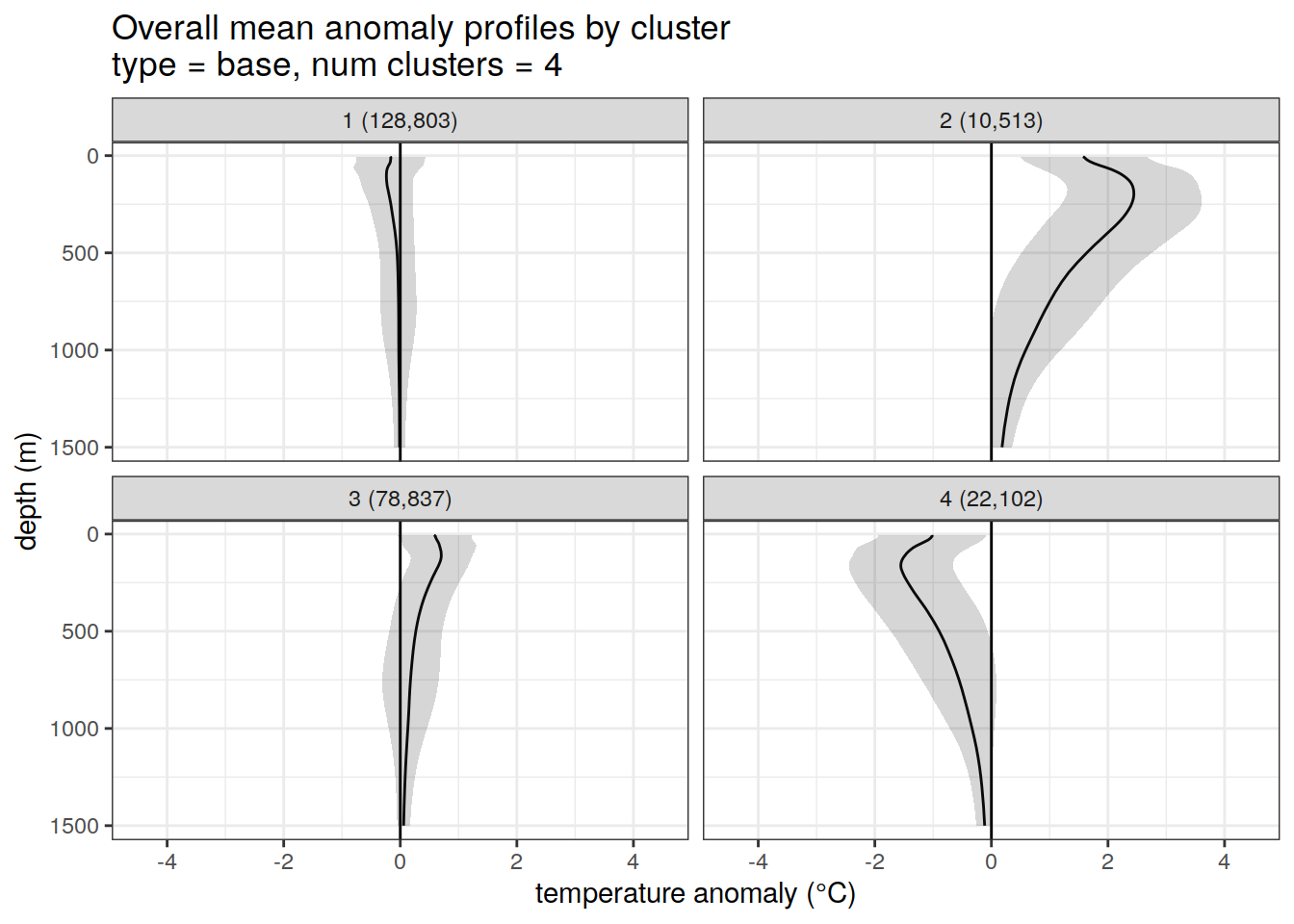
[[2]]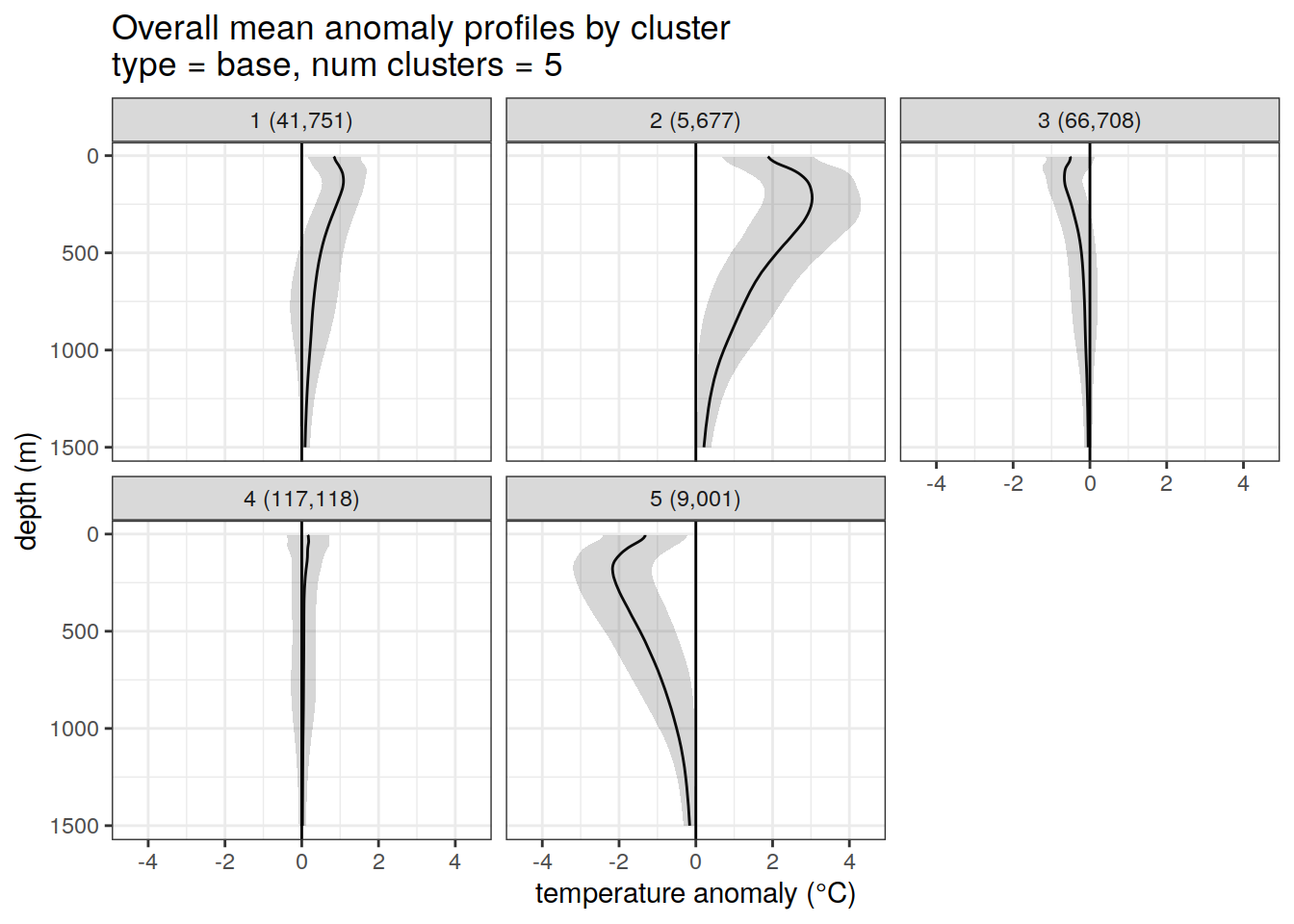
Adjusted profiles
if (opt_norm_anomaly) {
# repeat for adjusted profiles profiles
anomaly_cluster_mean %>%
filter (profile_type == "adjusted") %>%
group_split(profile_type, num_clusters) %>%
map(
~ ggplot(data = .x,) +
geom_path(aes(x = anomaly_mean,
y = depth)) +
geom_ribbon(
aes(
xmax = anomaly_mean + anomaly_sd,
xmin = anomaly_mean - anomaly_sd,
y = depth
),
alpha = 0.2
) +
geom_vline(xintercept = 0) +
scale_y_reverse() +
facet_wrap(~ paste0(cluster, " (", formatC(count_profiles, big.mark=",") , ")")) +
coord_cartesian(xlim = opt_xlim_adjusted) +
scale_x_continuous(breaks = opt_xbreaks_adjusted) +
labs(
title = paste0(
'Overall mean anomaly profiles by cluster \n',
'type = ', unique(.x$profile_type), ', ',
'num clusters = ', unique(.x$num_clusters)
),
x = opt_measure_label_adjusted,
y = 'depth (m)'
)
)
}[[1]]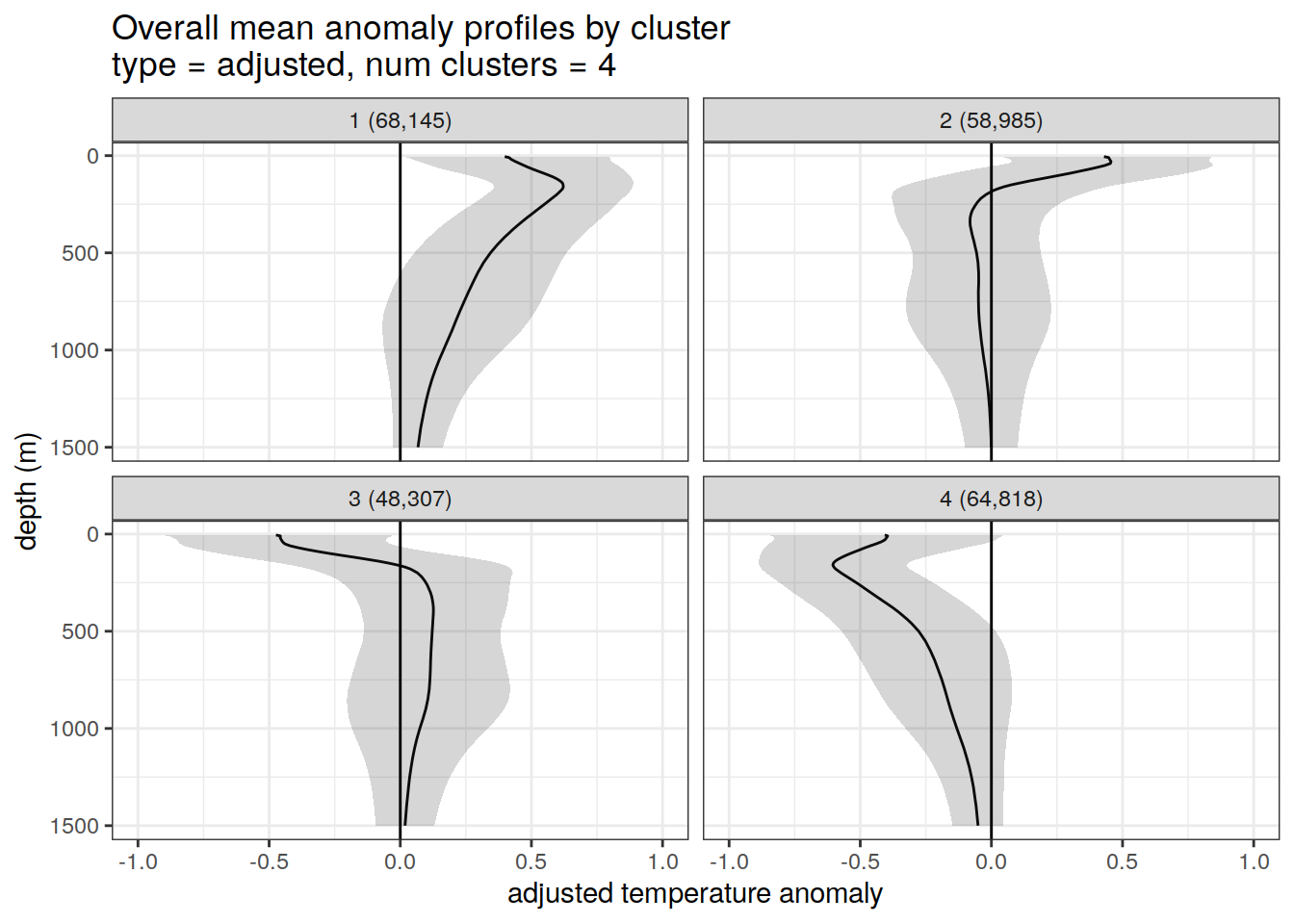
[[2]]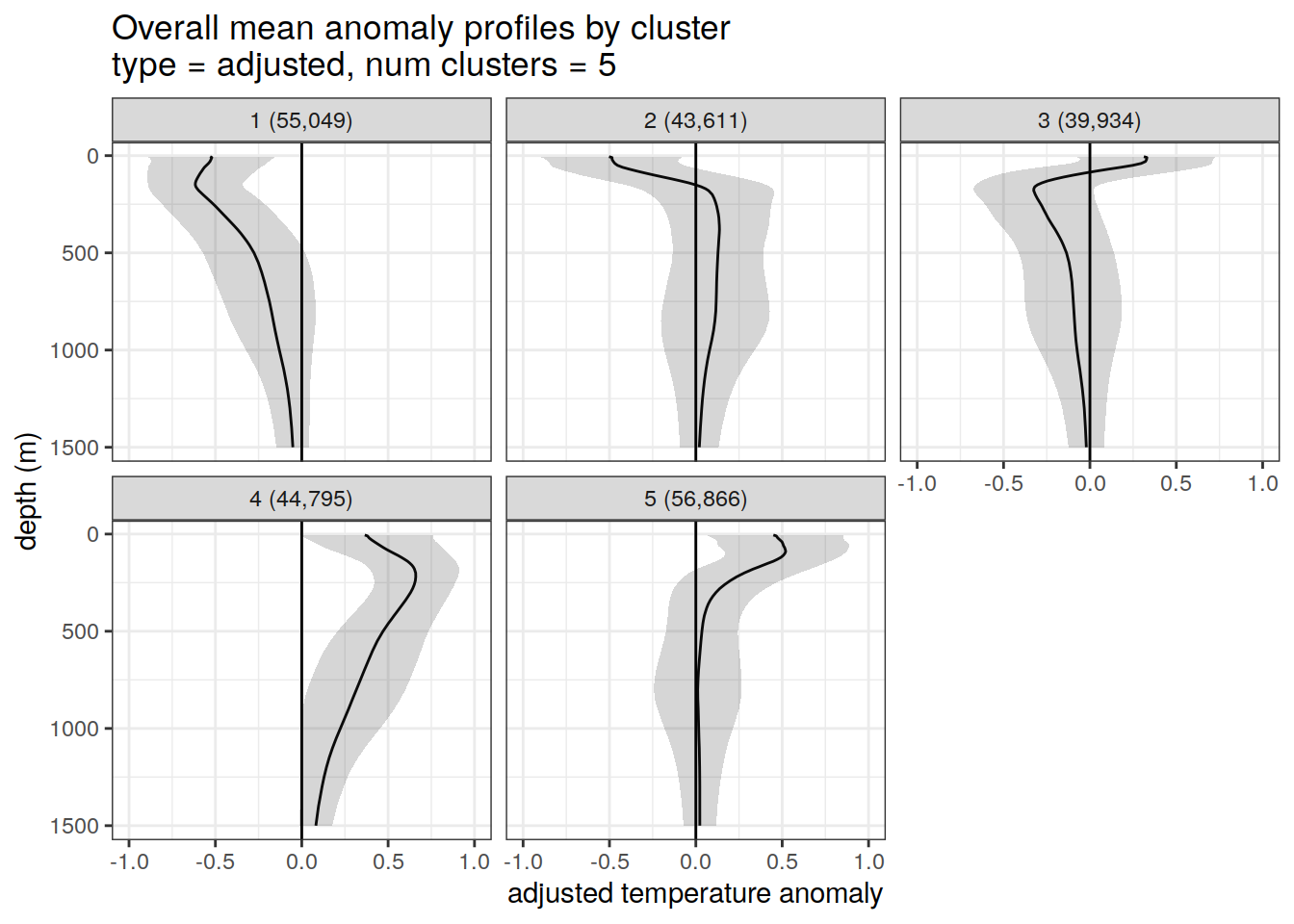
Cluster mean by year
# cluster means by year
anomaly_cluster_mean_year %>%
filter (profile_type == "base") %>%
mutate(year = as.factor(year)) %>%
group_split(profile_type, num_clusters) %>%
map(
~ ggplot(data = .x, ) +
geom_path(aes(
x = anomaly_mean,
y = depth,
col = year
)) +
geom_vline(xintercept = 0) +
scale_y_reverse() +
facet_wrap(~ cluster) +
coord_cartesian(xlim = opt_xlim) +
scale_x_continuous(breaks = opt_xbreaks) +
scale_color_viridis_d() +
labs(
title = paste0(
'Overall mean anomaly profiles by cluster \n',
'type = ', unique(.x$profile_type), ', ',
'num clusters = ', unique(.x$num_clusters)
),
x = opt_measure_label,
y = 'depth (m)'
)
)[[1]]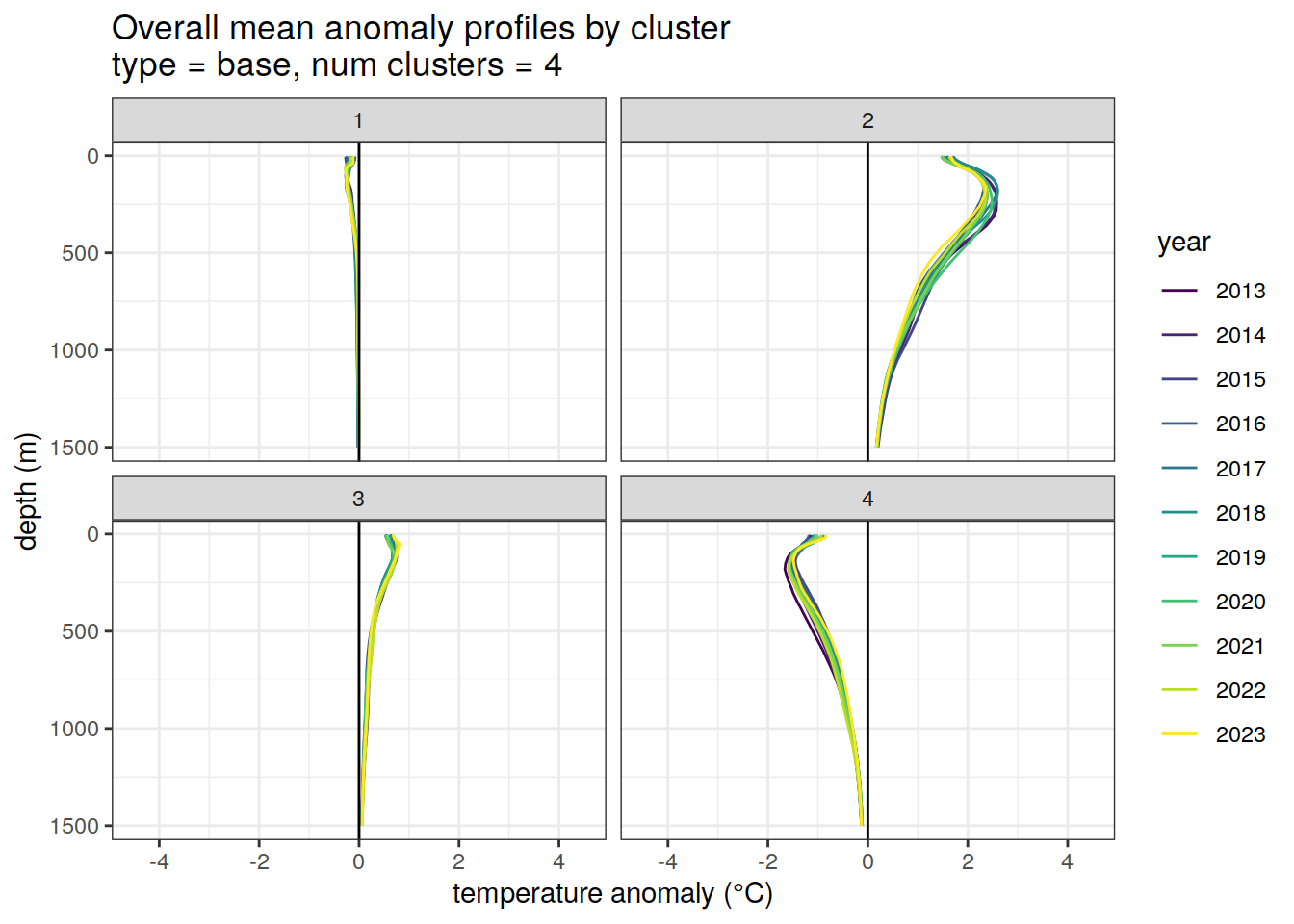
[[2]]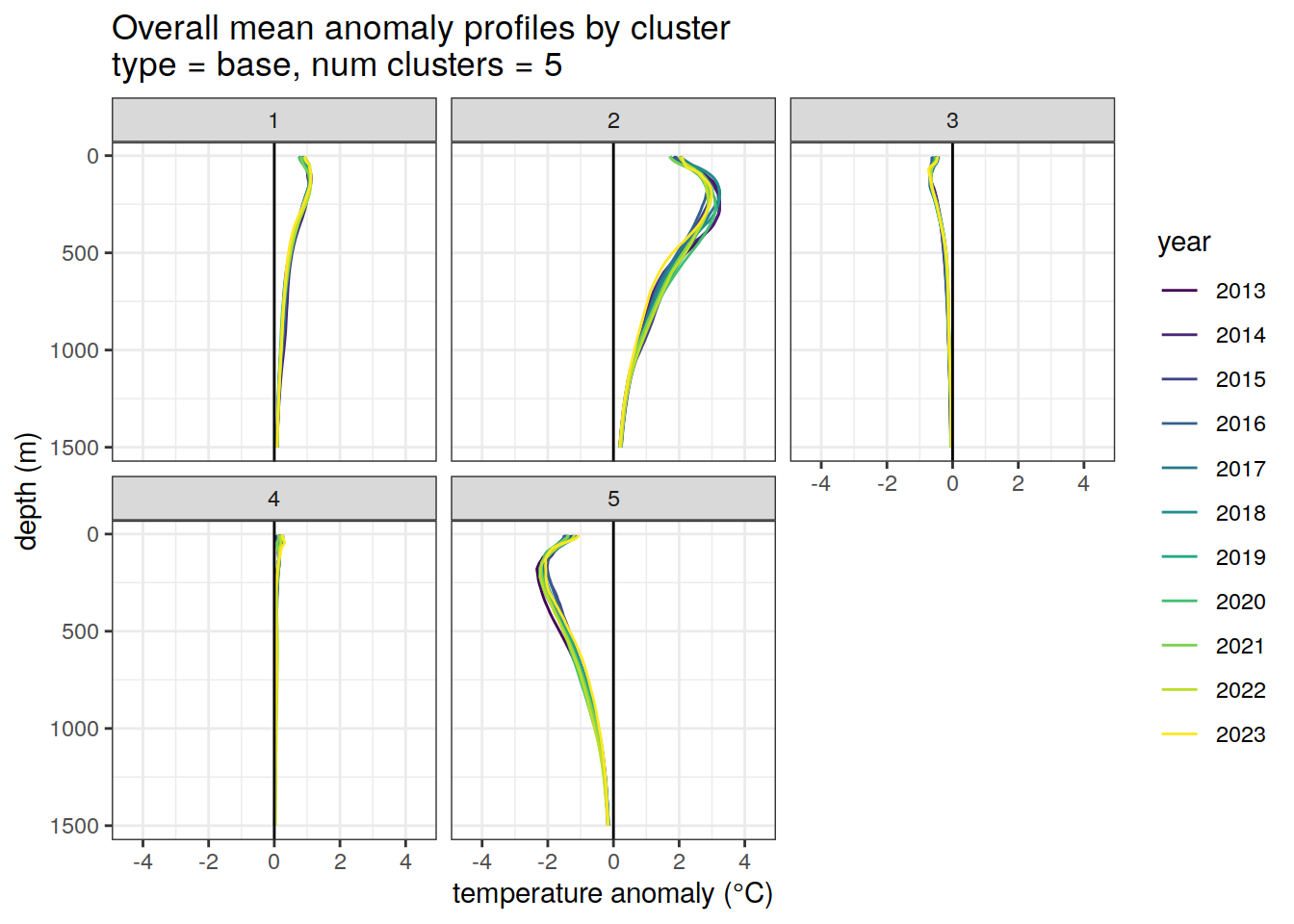
Adjusted profiles
if (opt_norm_anomaly) {
# Repeat for adjusted profiles
anomaly_cluster_mean_year %>%
filter (profile_type == "adjusted") %>%
mutate(year = as.factor(year)) %>%
group_split(profile_type, num_clusters) %>%
map(
~ ggplot(data = .x, ) +
geom_path(aes(
x = anomaly_mean,
y = depth,
col = year
)) +
geom_vline(xintercept = 0) +
scale_y_reverse() +
facet_wrap(~ cluster) +
coord_cartesian(xlim = opt_xlim_adjusted) +
scale_x_continuous(breaks = opt_xbreaks_adjusted) +
scale_color_viridis_d() +
labs(
title = paste0(
'Overall mean anomaly profiles by cluster \n',
'type = ', unique(.x$profile_type), ', ',
'num clusters = ', unique(.x$num_clusters)
),
x = opt_measure_label_adjusted,
y = 'depth (m)'
)
)
}[[1]]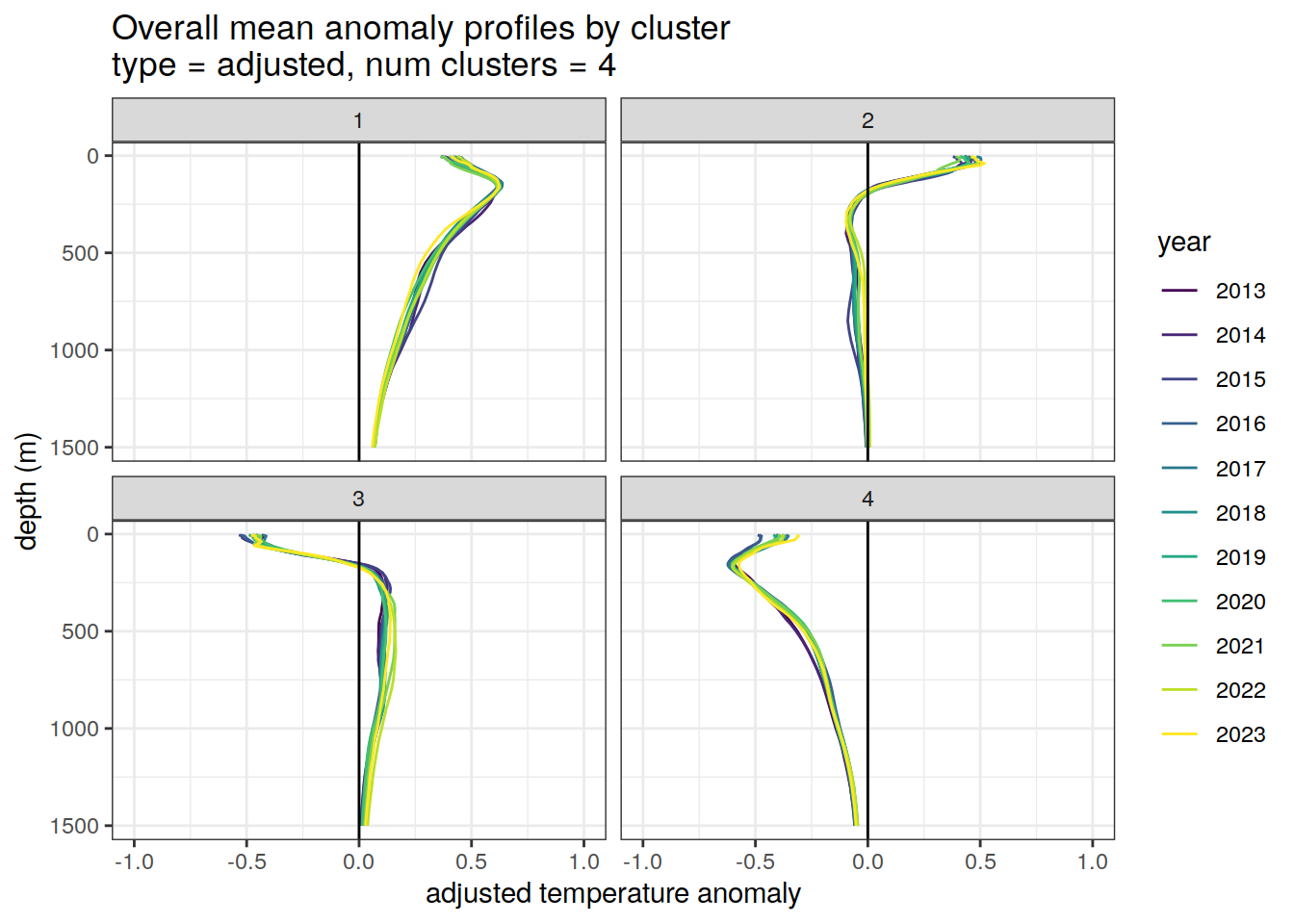
[[2]]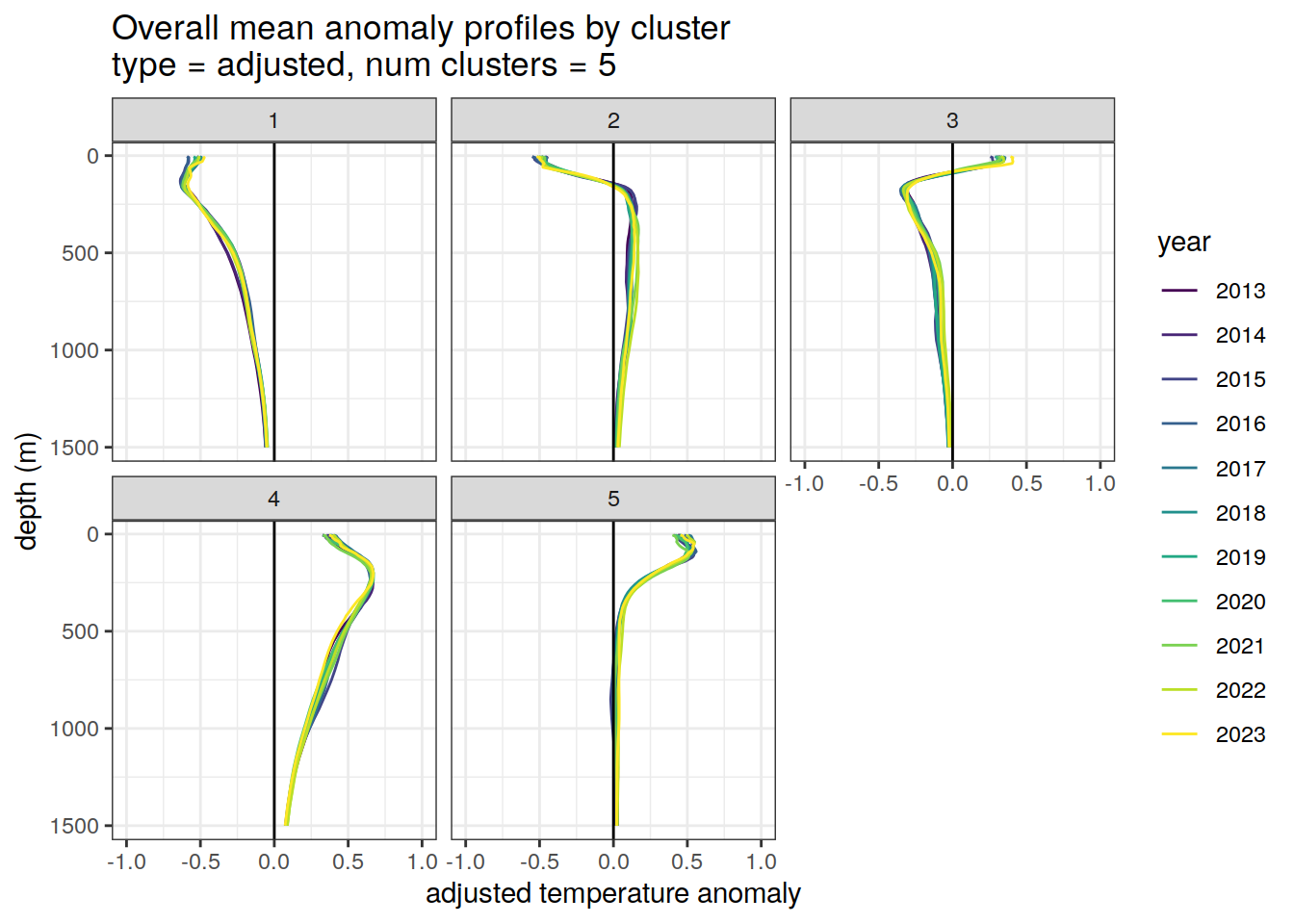
Cluster by year
count of each cluster by year
year_min <- min(cluster_by_year$year)
year_max <- max(cluster_by_year$year)
# create figure
cluster_by_year %>%
filter (profile_type == "base") %>%
group_split(profile_type, num_clusters) %>%
map(
~ ggplot(data = .x, aes(
x = year,
y = count_cluster,
col = cluster,
group = cluster
)) +
geom_point() +
geom_line() +
scale_x_continuous(breaks = seq(year_min, year_max, 2)) +
scale_color_brewer(palette = 'Dark2') +
labs(
title = paste0(
'Count of profiles by year and cluster \n',
'type = ', unique(.x$profile_type), ', ',
'num clusters = ', unique(.x$num_clusters)
),
x = 'year',
y = 'number of profiles',
col = 'cluster'
)
)[[1]]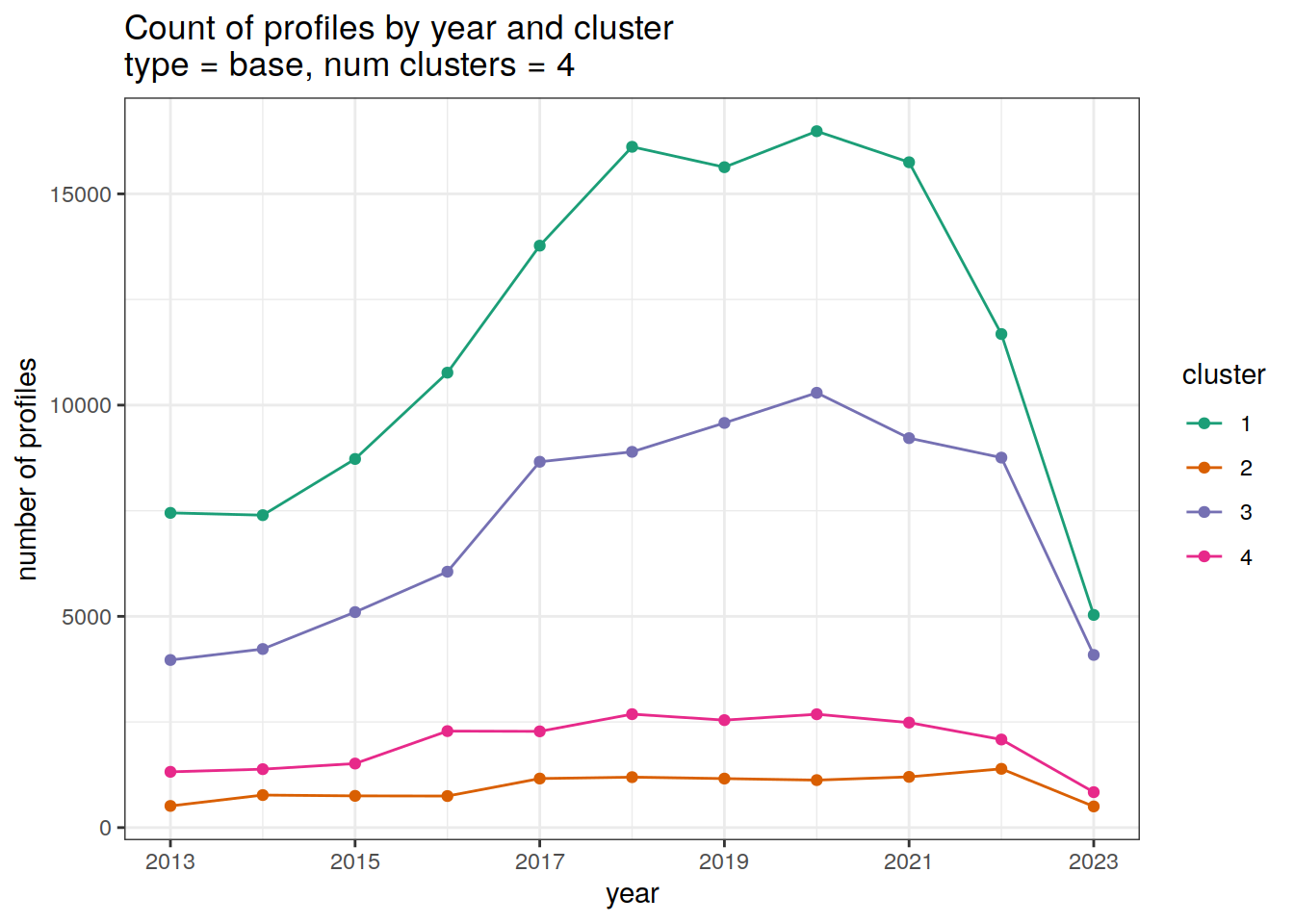
[[2]]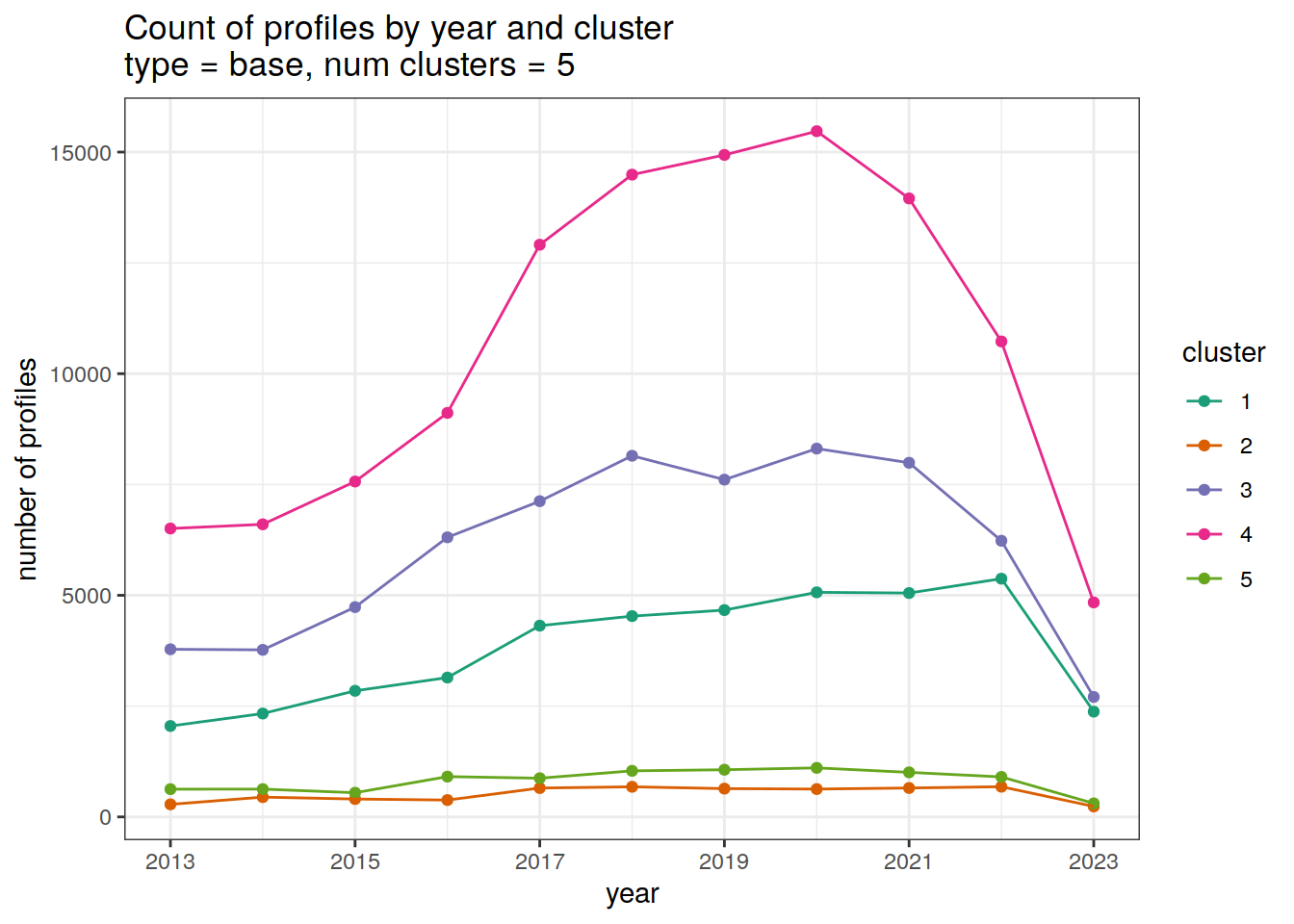
Adjusted profiles
if (opt_norm_anomaly) {
year_min <- min(cluster_by_year$year)
year_max <- max(cluster_by_year$year)
# create figure
cluster_by_year %>%
filter (profile_type == "adjusted") %>%
group_split(profile_type, num_clusters) %>%
map(
~ ggplot(data = .x, aes(
x = year,
y = count_cluster,
col = cluster,
group = cluster
)) +
geom_point() +
geom_line() +
scale_x_continuous(breaks = seq(year_min, year_max, 2)) +
scale_color_brewer(palette = 'Dark2') +
labs(
title = paste0(
'Count of profiles by year and cluster \n',
'type = ', unique(.x$profile_type), ', ',
'num clusters = ', unique(.x$num_clusters)
),
x = 'year',
y = 'number of profiles',
col = 'cluster'
)
)
}[[1]]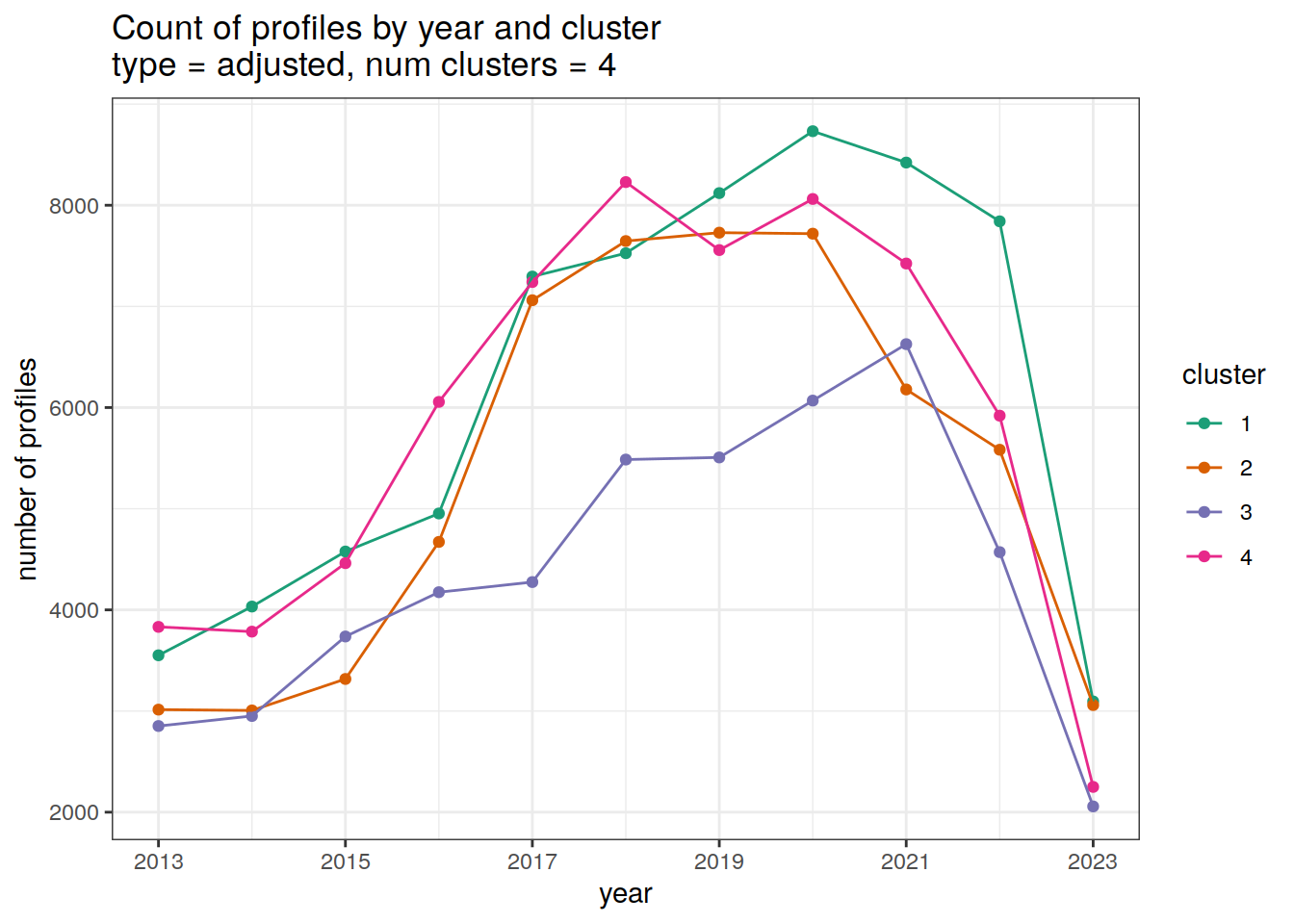
[[2]]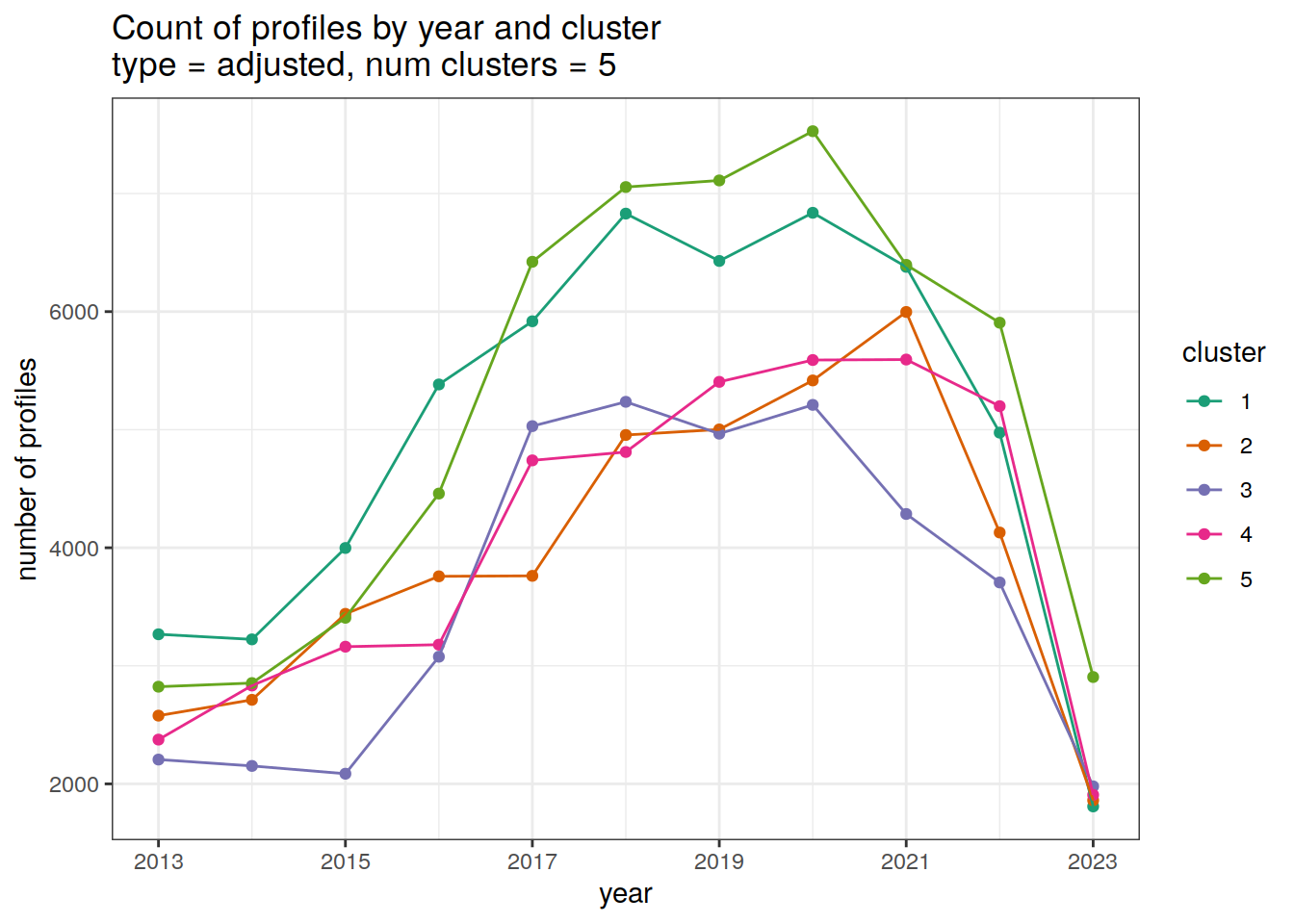
Cluster by month
count of each cluster by month of year
# Determine profile count by cluster and year
# Count the measurements
cluster_by_year <- anomaly_cluster_all %>%
count(profile_type, num_clusters, file_id, cluster, month,
name = "count_cluster")
# Convert to profiles
cluster_by_year <- cluster_by_year %>%
count(profile_type, num_clusters, cluster, month,
name = "count_cluster")
# create figure
cluster_by_year %>%
filter (profile_type == "base") %>%
group_split(profile_type, num_clusters) %>%
map(
~ ggplot(
data = .x,
aes(
x = month,
y = count_cluster,
col = cluster,
group = cluster
)
) +
geom_point() +
geom_line() +
scale_x_continuous(breaks = seq(1, 12, 2)) +
scale_color_brewer(palette = 'Dark2') +
labs(
title = paste0(
'Count of profiles by month and cluster \n',
'type = ', unique(.x$profile_type), ', ',
'num clusters = ', unique(.x$num_clusters)
),
x = 'month',
y = 'number of profiles',
col = 'cluster'
)
)[[1]]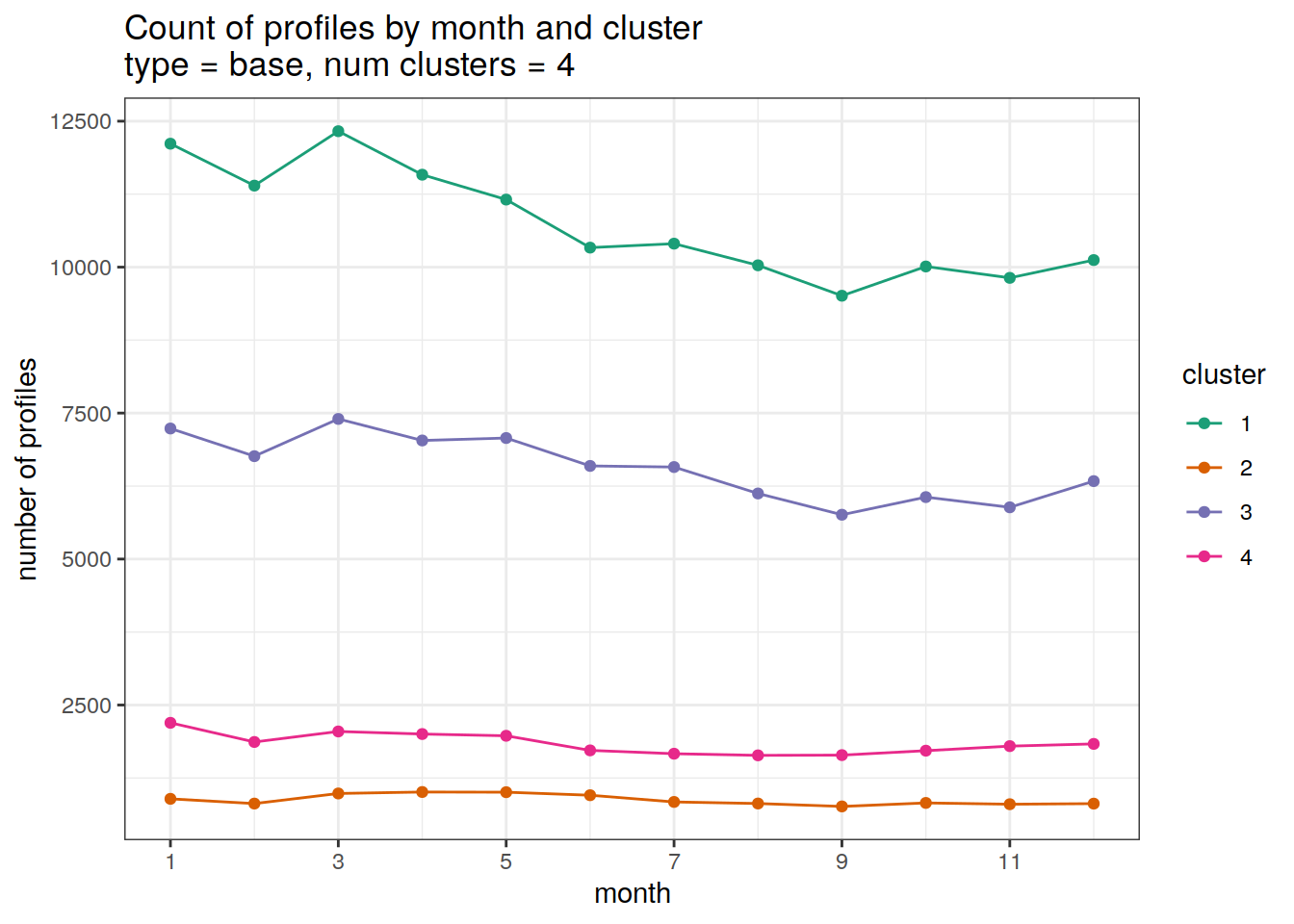
[[2]]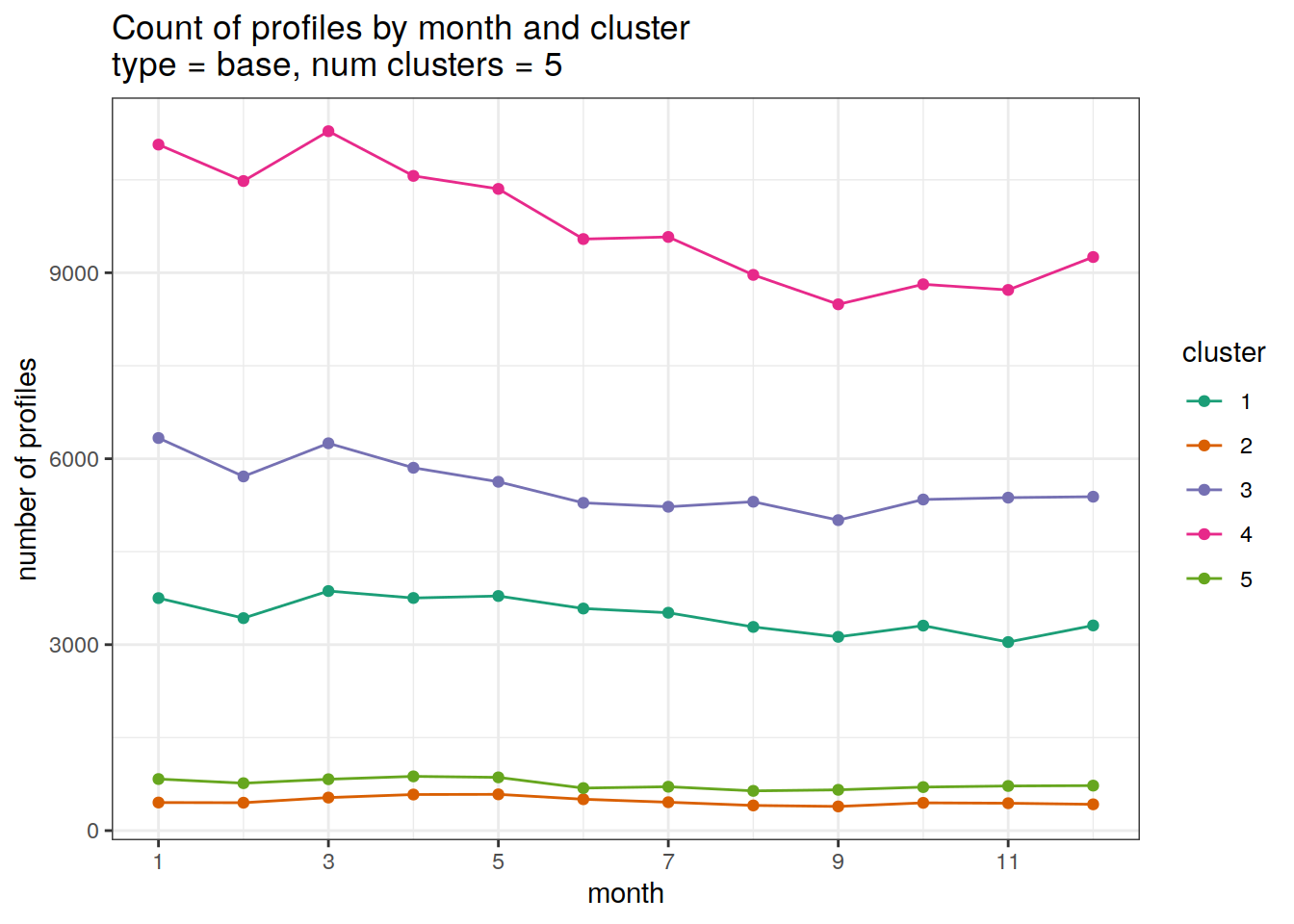
Adjusted profiles
if (opt_norm_anomaly) {
# create figure
cluster_by_year %>%
filter (profile_type == "adjusted") %>%
group_split(profile_type, num_clusters) %>%
map(
~ ggplot(
data = .x,
aes(
x = month,
y = count_cluster,
col = cluster,
group = cluster
)
) +
geom_point() +
geom_line() +
scale_x_continuous(breaks = seq(1, 12, 2)) +
scale_color_brewer(palette = 'Dark2') +
labs(
title = paste0(
'Count of profiles by month and cluster \n',
'type = ', unique(.x$profile_type), ', ',
'num clusters = ', unique(.x$num_clusters)
),
x = 'month',
y = 'number of profiles',
col = 'cluster'
)
)
}[[1]]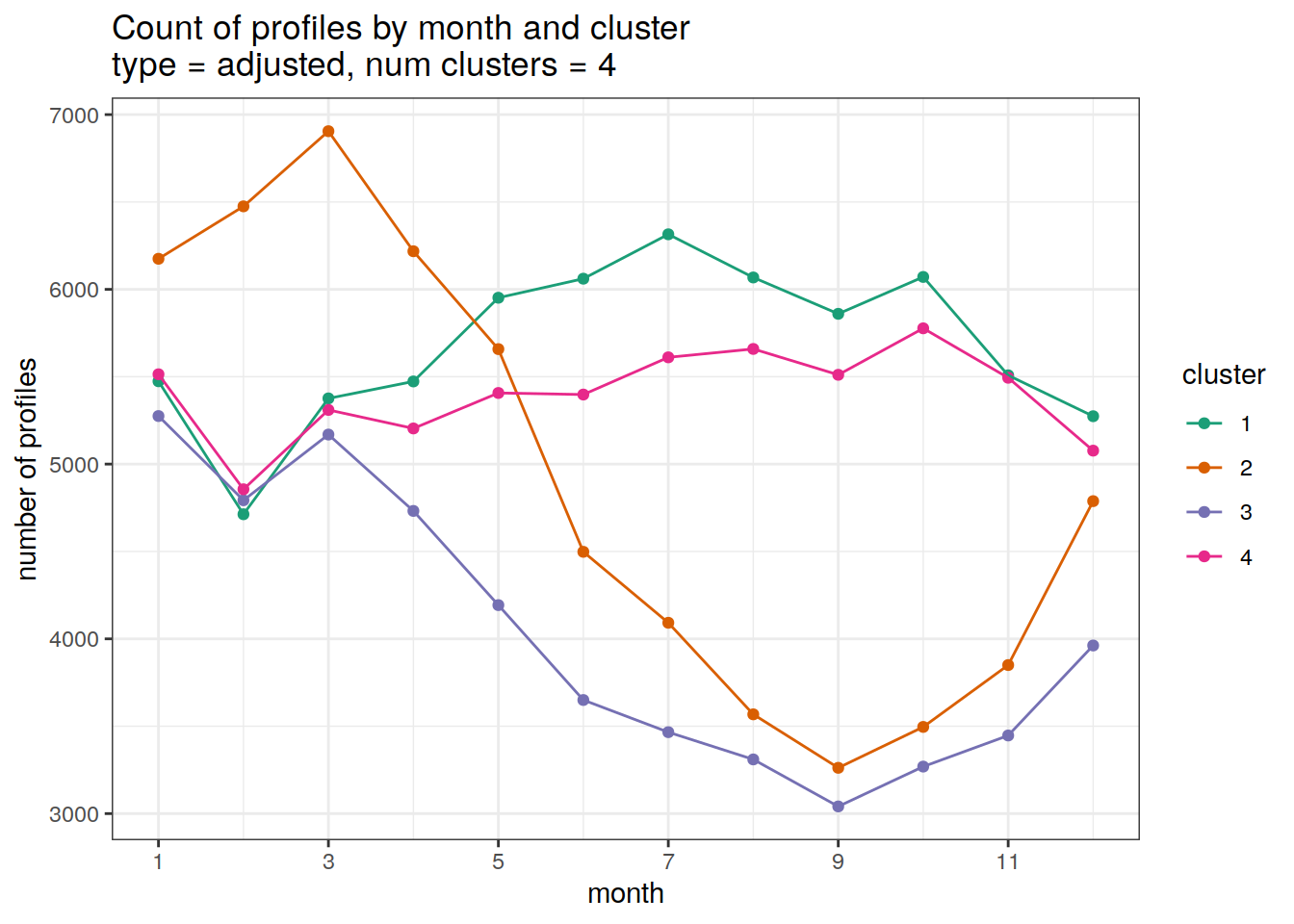
[[2]]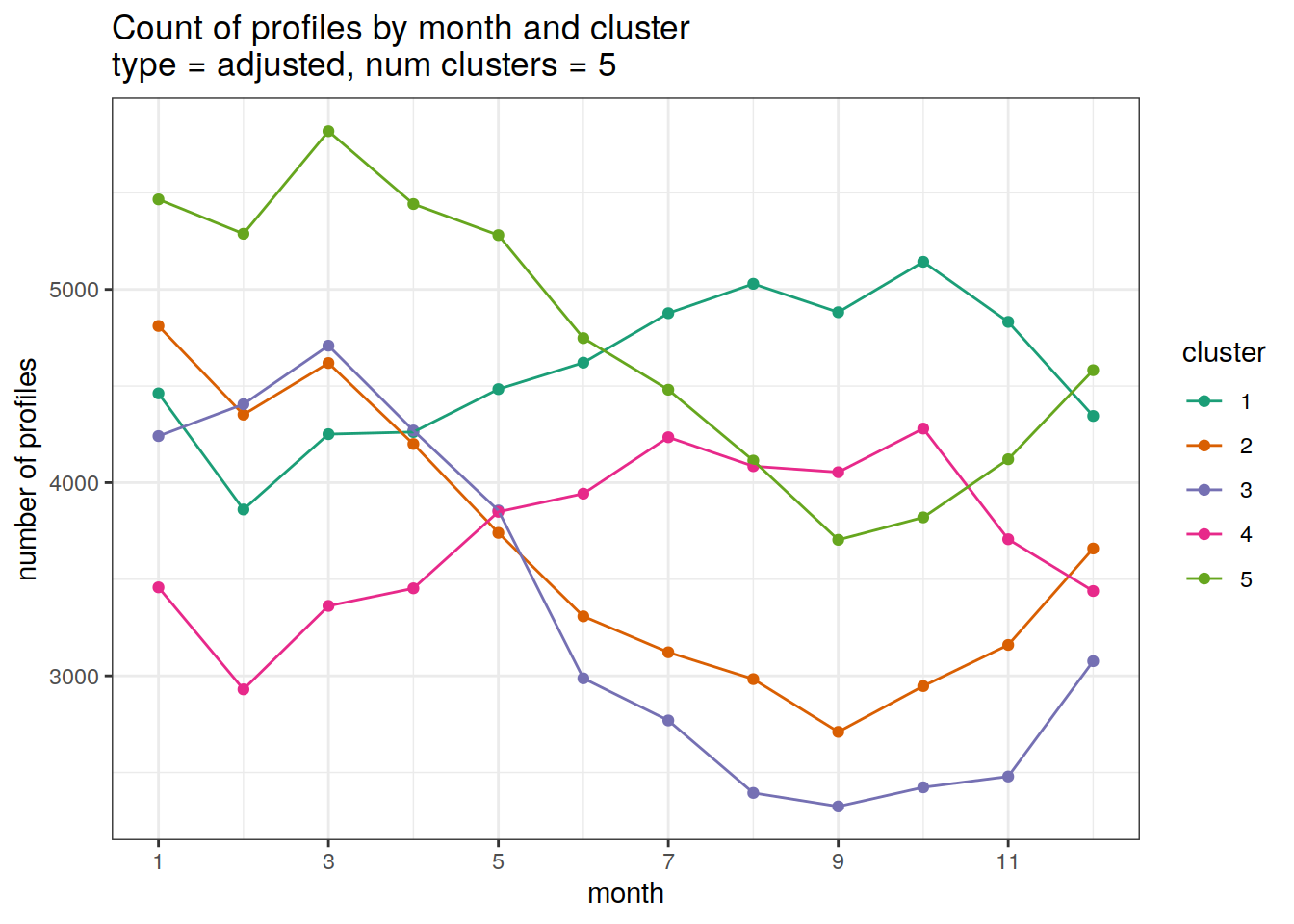
Cluster spatial
location of each cluster on map, spatial analysis
# create figure
anomaly_cluster_all %>%
filter (profile_type == "base") %>%
group_split(profile_type, num_clusters) %>%
map(
~ map +
geom_tile(data = .x,
aes(
x = lon,
y = lat,
fill = cluster
)) +
lims(y = opt_map_lat_limit) +
scale_fill_brewer(palette = 'Dark2') +
labs(
title = paste0(
'cluster spatial distribution \n',
'type = ', unique(.x$profile_type), ', ',
'num clusters = ', unique(.x$num_clusters)
),
)
)[[1]]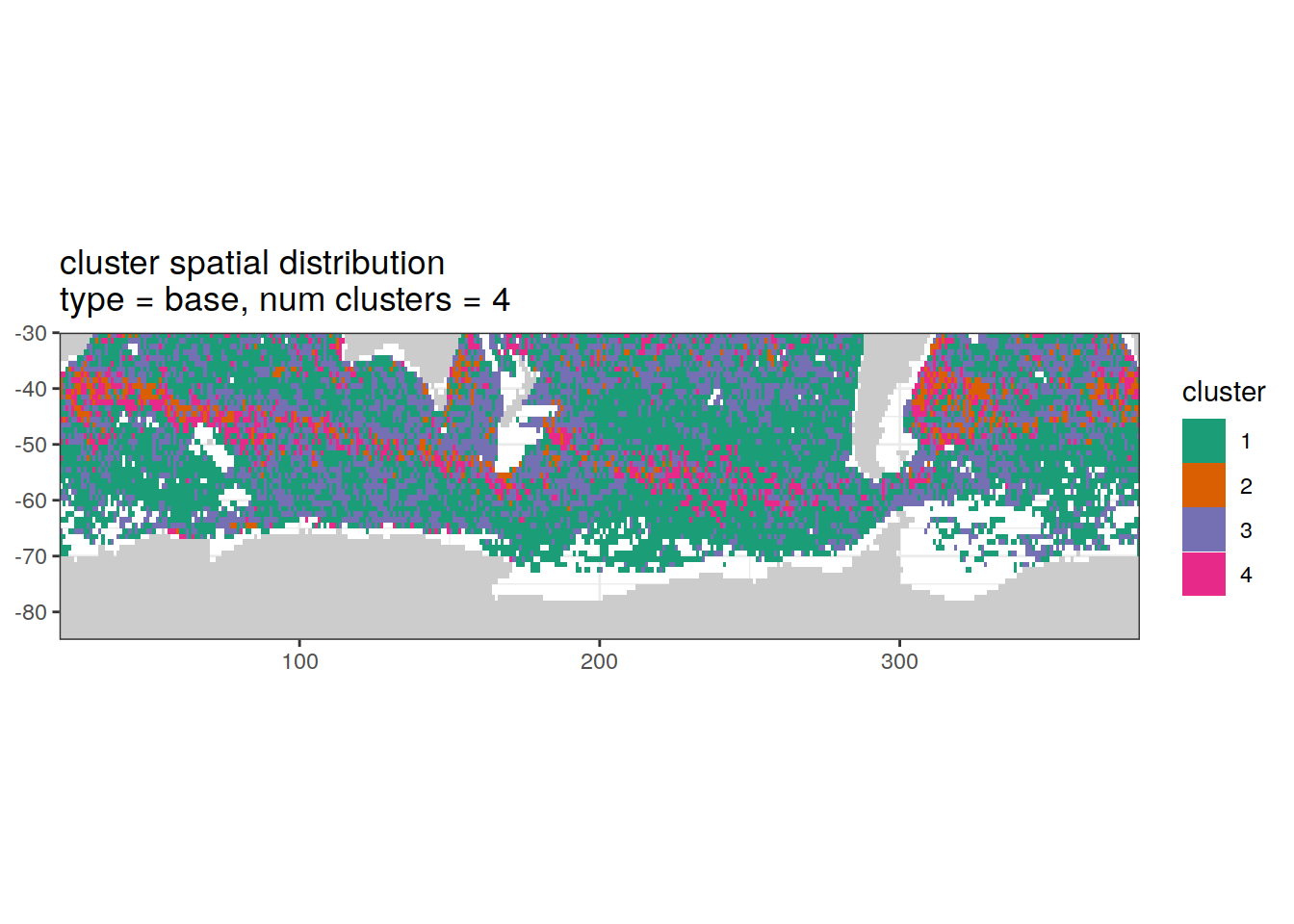
[[2]]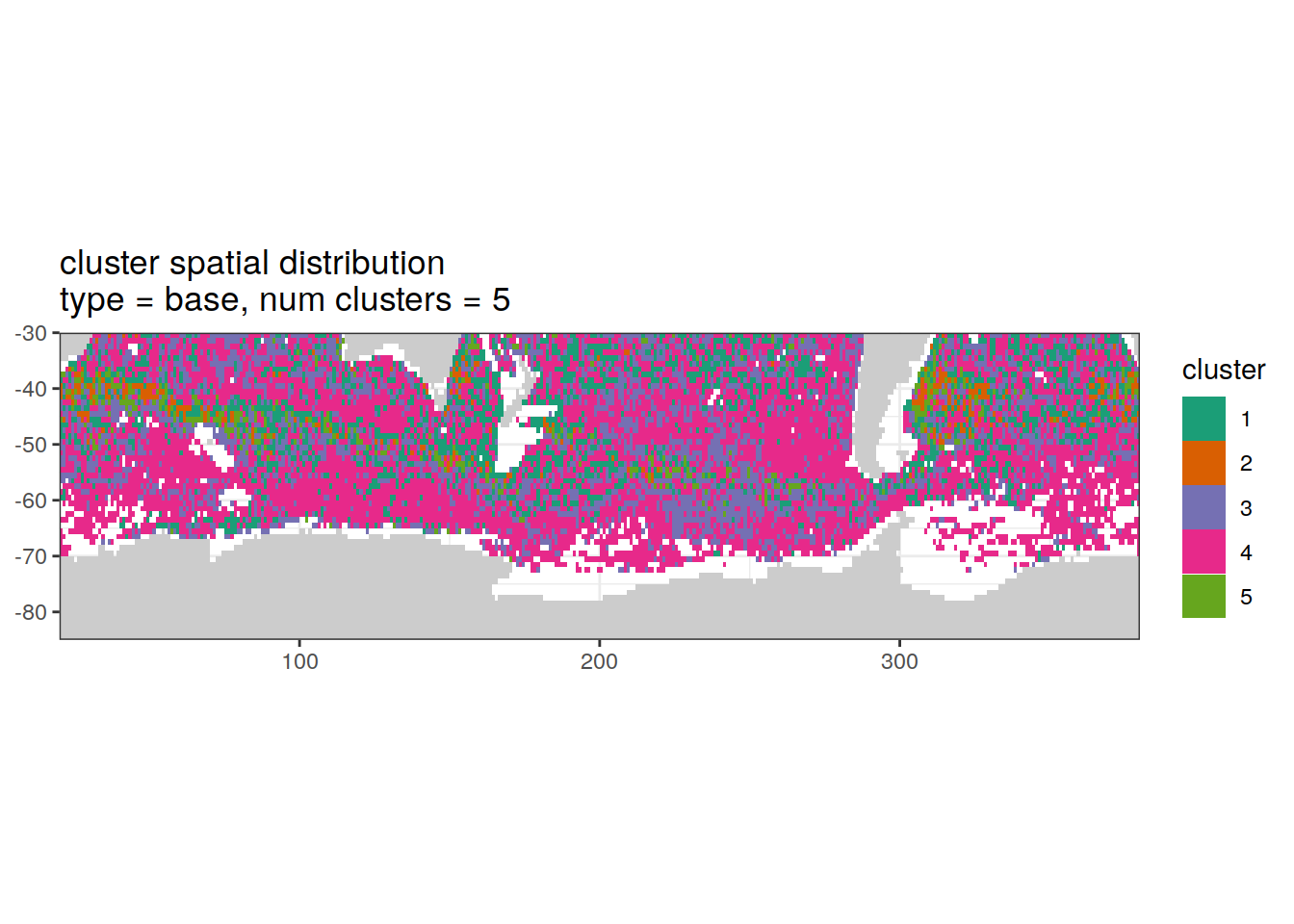
Adjusted profiles
if (opt_norm_anomaly) {
# create figure
anomaly_cluster_all %>%
filter (profile_type == "adjusted") %>%
group_split(profile_type, num_clusters) %>%
map(
~ map +
geom_tile(data = .x,
aes(
x = lon,
y = lat,
fill = cluster
)) +
lims(y = opt_map_lat_limit) +
scale_fill_brewer(palette = 'Dark2') +
labs(
title = paste0(
'cluster spatial distribution \n',
'type = ', unique(.x$profile_type), ', ',
'num clusters = ', unique(.x$num_clusters)
),
)
)
}[[1]]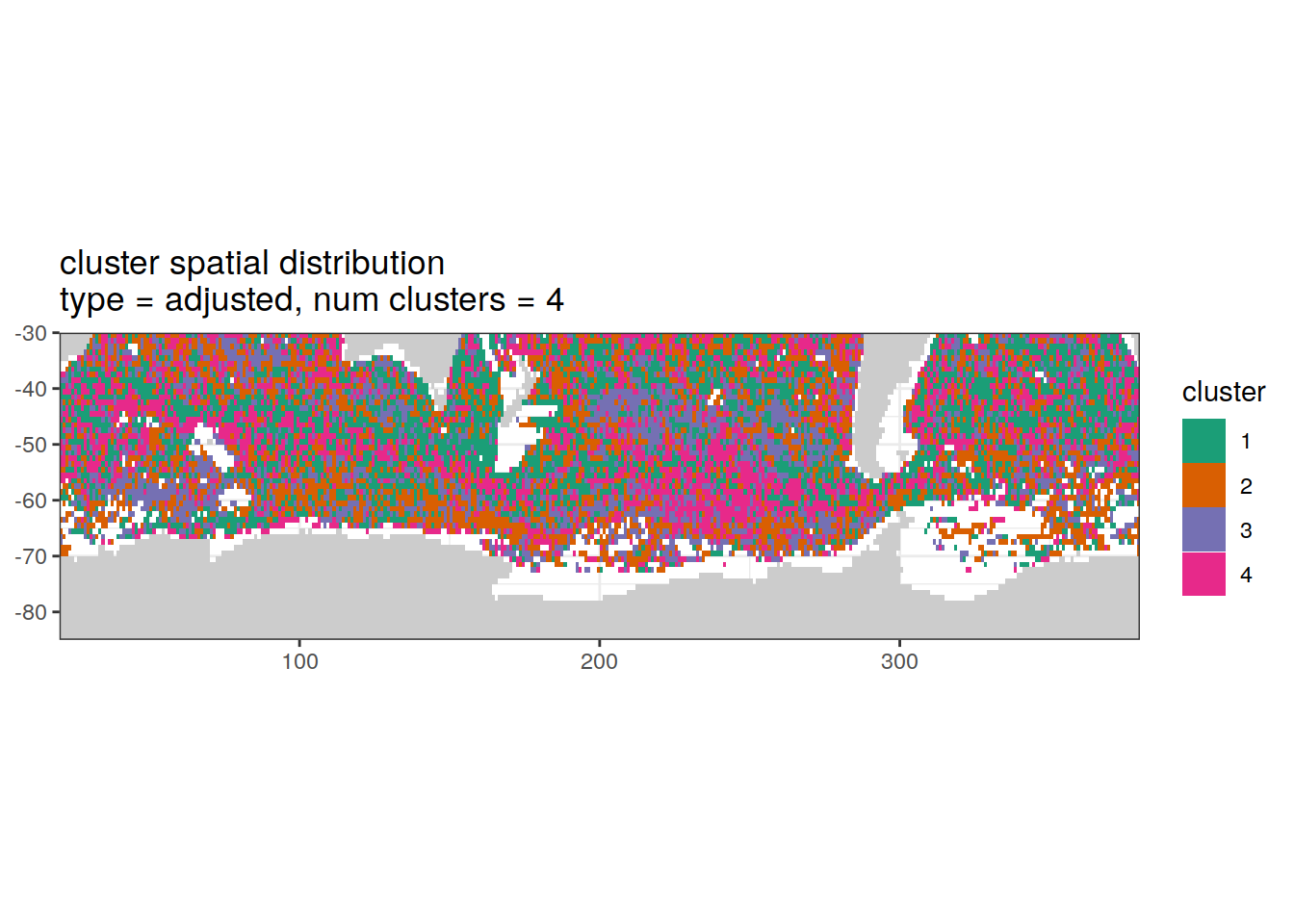
[[2]]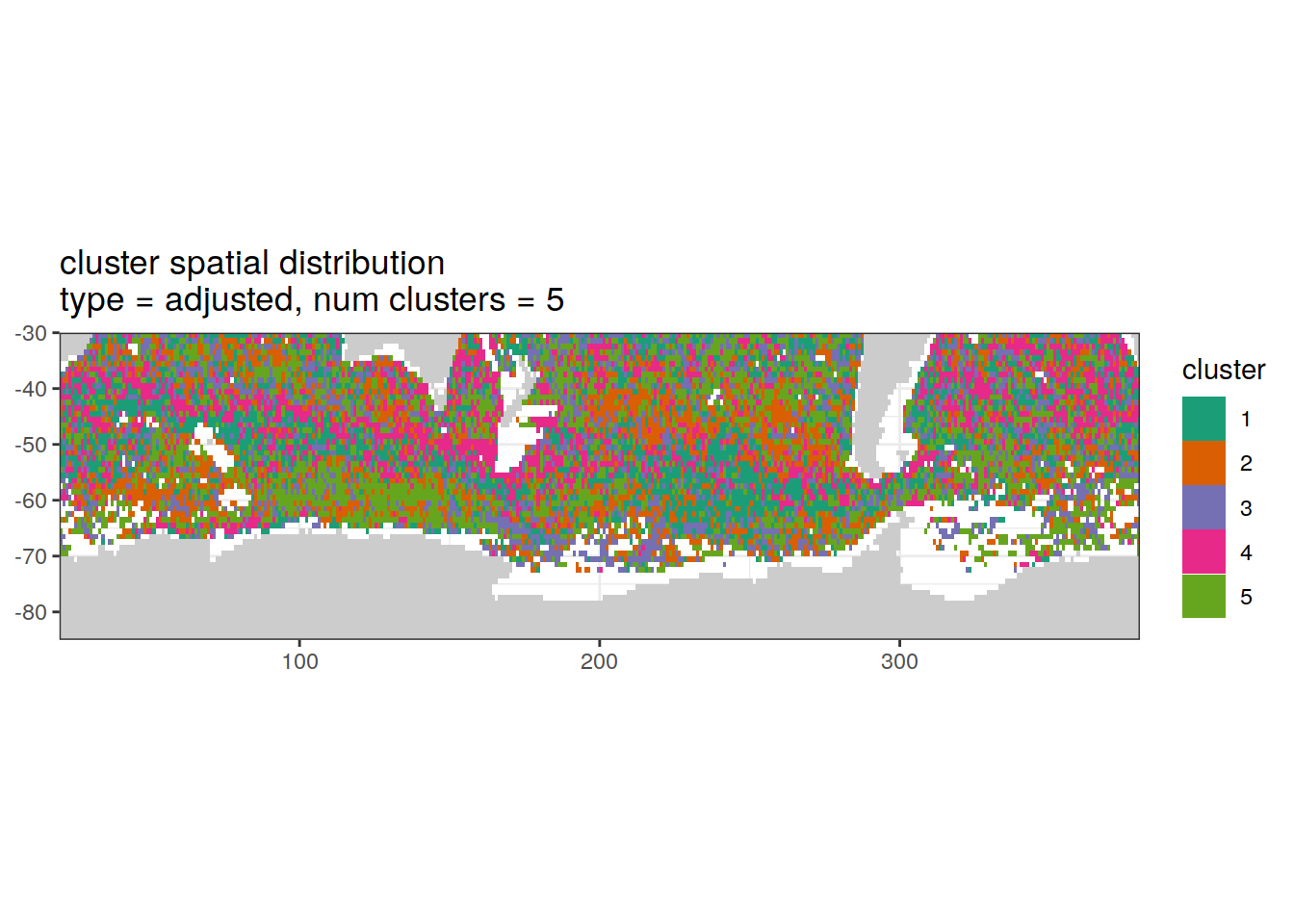
Cluster spatial counts
count of measurements for each cluster on separate maps, spatial analysis
# Count profiles
cluster_by_location <- anomaly_cluster_all %>%
count(profile_type, num_clusters, file_id, lat, lon, cluster,
name = "count_cluster")
# # Add cluster counts to
cluster_by_location <- left_join(cluster_by_location, cluster_count)
# create figure
cluster_by_location %>%
filter (profile_type == "base") %>%
group_split(profile_type, num_clusters) %>%
map(
~ map +
geom_tile(data = .x %>%
count(lat, lon, cluster, count_profiles),
aes(
x = lon,
y = lat,
fill = n
)) +
lims(y = opt_map_lat_limit) +
scale_fill_gradient(low = "blue",
high = "red",
trans = "log10") +
facet_wrap(~ paste0(cluster, " (", formatC(count_profiles, big.mark=",") , ")"), ncol = 2) +
labs(
title = paste0(
'cluster spatial distribution \n',
'type = ', unique(.x$profile_type), ', ',
'num clusters = ', unique(.x$num_clusters)
)
)
)[[1]]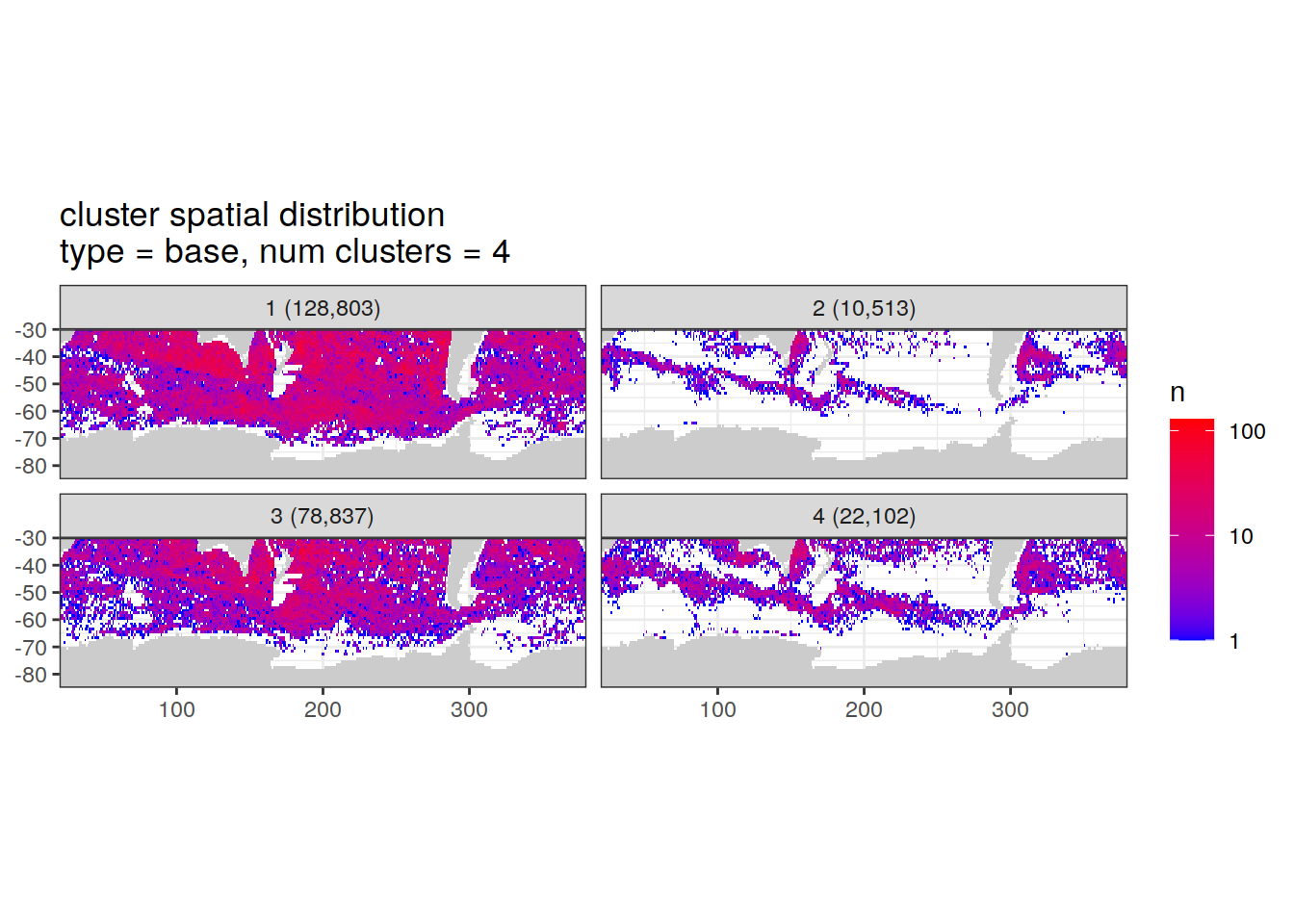
[[2]]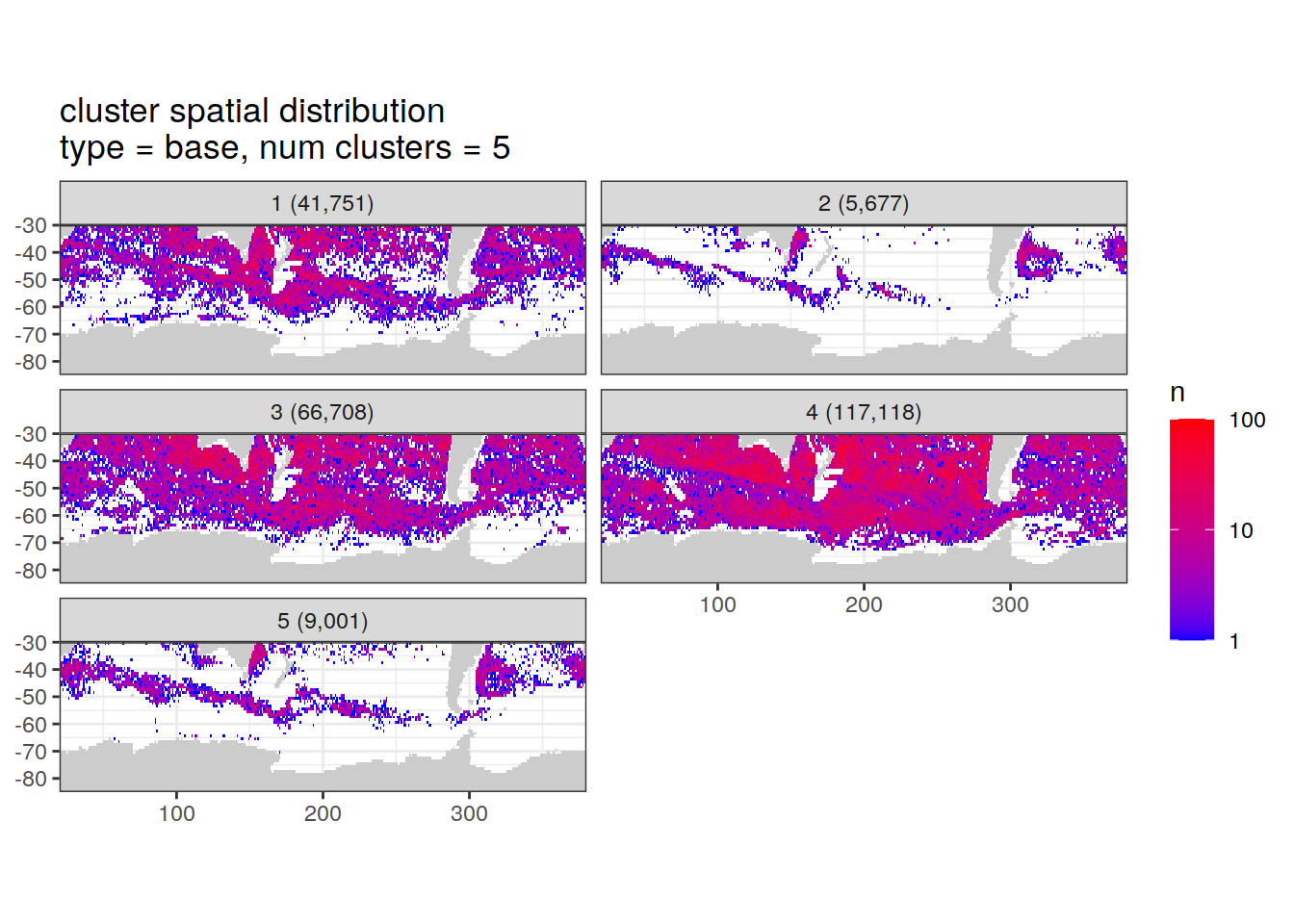
Adjusted profiles
if (opt_norm_anomaly) {
# create figure
cluster_by_location %>%
filter (profile_type == "adjusted") %>%
group_split(profile_type, num_clusters) %>%
map(
~ map +
geom_tile(data = .x %>%
count(lat, lon, cluster, count_profiles),
aes(
x = lon,
y = lat,
fill = n
)) +
lims(y = opt_map_lat_limit) +
scale_fill_gradient(low = "blue",
high = "red",
trans = "log10") +
facet_wrap(~ paste0(cluster, " (", formatC(count_profiles, big.mark=",") , ")"), ncol = 2) +
labs(
title = paste0(
'cluster spatial distribution \n',
'type = ', unique(.x$profile_type), ', ',
'num clusters = ', unique(.x$num_clusters)
)
)
)
}[[1]]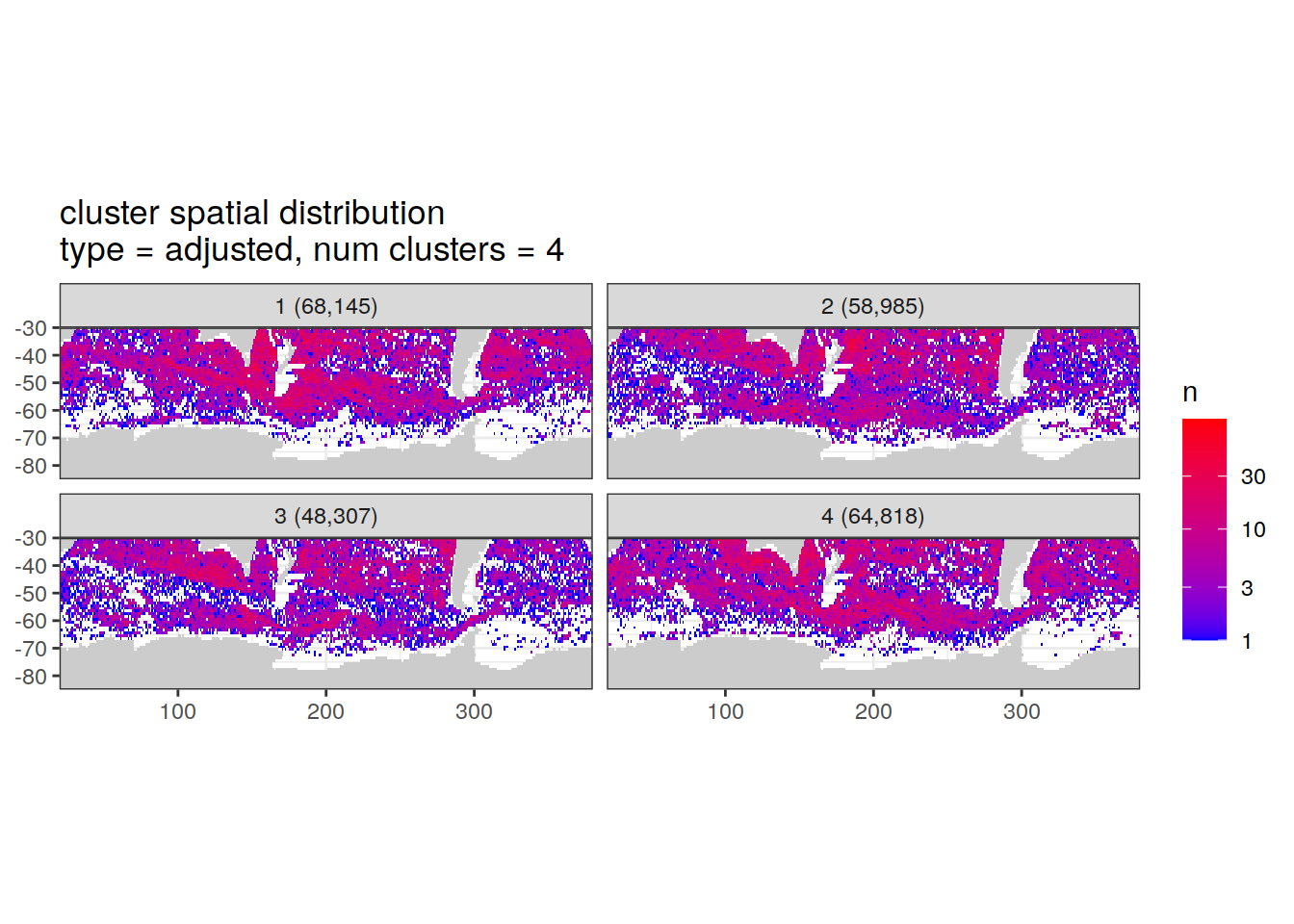
[[2]]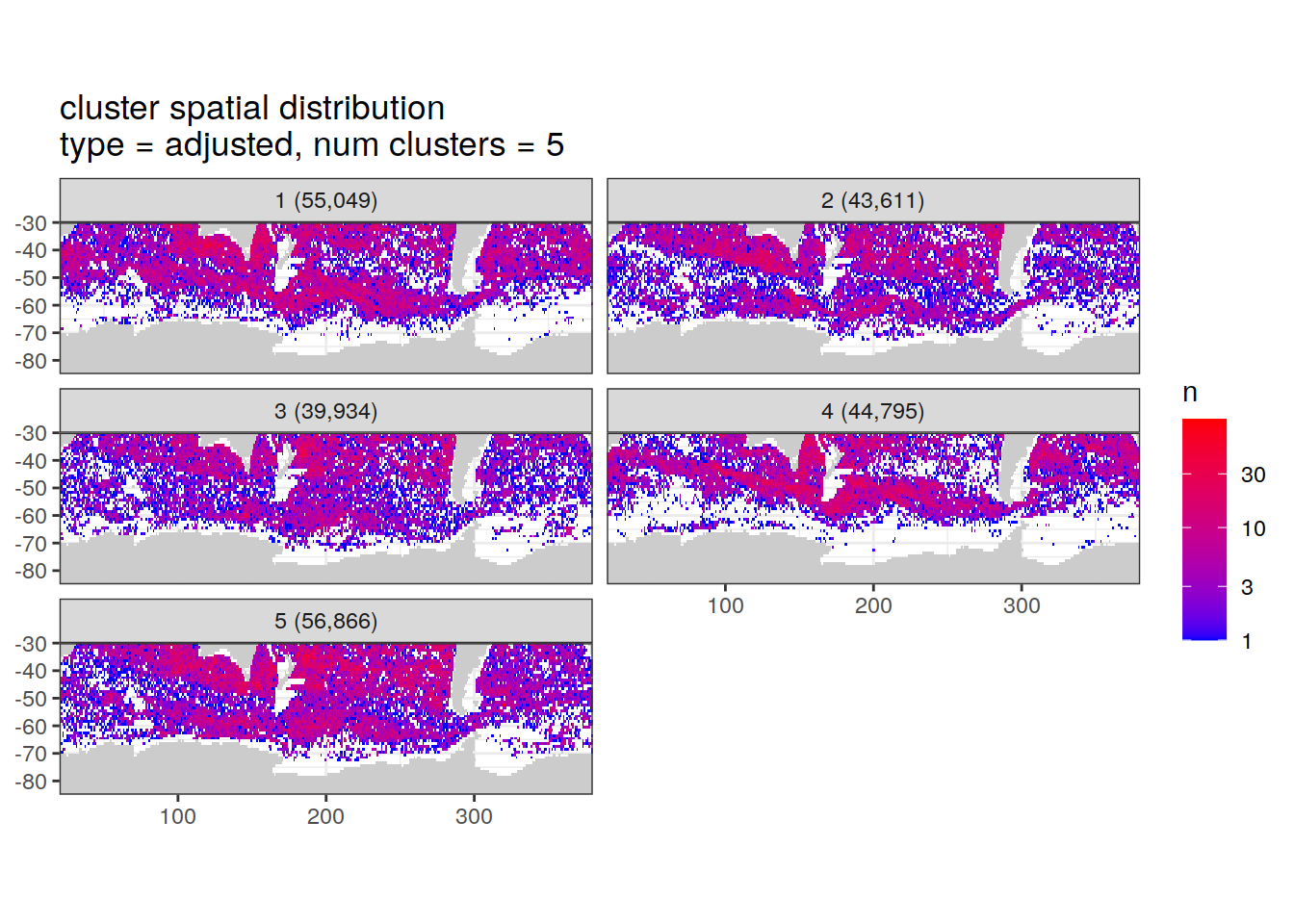
Cluster by surface Extreme
if (opt_extreme_analysis){
# date to match to ocean SODA
anomaly_va <- anomaly_va %>%
mutate(date = ymd(format(date, "%Y-%m-15")))
# Add the OceanSODA extreme condition
anomaly_va <- left_join(anomaly_va, extreme_data)
# If extreme is NA set it to N
anomaly_va <- anomaly_va %>% replace_na(list(extreme_flag = 'N'))
anomaly_va <- anomaly_va %>% mutate (profile_type = 'base')
# Create a replica data set with profile_type = adjusted
if (opt_norm_anomaly){
# mark as adjusted
anomaly_va_norm <- anomaly_va %>% mutate (profile_type = 'adjusted')
# Get the maximum anomaly for each profile - the normalisation will then fit -1 to 1
anomaly_va_norm <- anomaly_va_norm %>%
group_by(file_id) %>%
mutate(abs_ma = max(abs(anomaly))) %>%
ungroup()
# Carry out the adjustment
anomaly_va_norm <- anomaly_va_norm %>%
mutate(anomaly = anomaly/abs_ma)
#remove the surface anomaly field
anomaly_va_norm <- anomaly_va_norm %>% select(-c(abs_ma))
# Append to base profiles
anomaly_va <- rbind(anomaly_va, anomaly_va_norm)
}
profile_types <- c('adjusted', 'base')
# loop through profile_type
for (iprofile_type in 1:2) {
sel_profile_type = profile_types[iprofile_type]
# loop through surface condition
for (i in 1:3) {
# ---------------------------------------------------------------------------------------------
# Preparation
# ---------------------------------------------------------------------------------------------
# select profile based on profile_range and he appropriate max depth
anomaly_va_id <- anomaly_va %>%
filter(profile_range == opt_profile_range & depth <= opt_max_depth[opt_profile_range] & extreme_flag == extreme_type[i] & profile_type == sel_profile_type)
# Simplified table ready to pivot
anomaly_va_id <- anomaly_va_id %>%
select(file_id,
depth,
anomaly,
year,
month,
lat,
lon)
# wide table with each depth becoming a column
anomaly_va_wide <- anomaly_va_id %>%
select(file_id, depth, anomaly) %>%
pivot_wider(names_from = depth, values_from = anomaly)
# Drop any rows with missing values N/A caused by gaps in climatology data
anomaly_va_wide <- anomaly_va_wide %>%
drop_na()
# Table for cluster analysis
points <- anomaly_va_wide %>%
column_to_rownames(var = "file_id")
# ---------------------------------------------------------------------------------------------
# cluster analysis
# ---------------------------------------------------------------------------------------------
# loop through number of clusters
for (inum_clusters in opt_num_clusters_ext_min[i]:opt_num_clusters_ext_max[i]) {
set.seed(1)
kclusts <-
tibble(k = inum_clusters) %>%
mutate(
kclust = map(k, ~ kmeans(points, .x, iter.max = opt_max_iterations, nstart = opt_n_start)),
tidied = map(kclust, tidy),
glanced = map(kclust, glance),
augmented = map(kclust, augment, points)
)
profile_id <-
kclusts %>%
unnest(cols = c(augmented)) %>%
select(file_id = .rownames,
cluster = .cluster) %>%
mutate(file_id = as.numeric(file_id),
cluster = as.character(cluster))
# Add cluster to anomaly_va
anomaly_cluster <- full_join(anomaly_va_id, profile_id)
# Plot cluster mean
anomaly_cluster <- anomaly_cluster %>%
filter(!is.na(cluster))
# cluster mean
anomaly_cluster_mean <- anomaly_cluster %>%
group_by(cluster, depth) %>%
summarise(
count_cluster = n(),
anomaly_mean = mean(anomaly, na.rm = TRUE),
anomaly_sd = sd(anomaly, na.rm = TRUE)
) %>%
ungroup()
anomaly_cluster_mean_year <- anomaly_cluster %>%
group_by(cluster, depth, year) %>%
summarise(
count_cluster = n(),
anomaly_mean = mean(anomaly, na.rm = TRUE),
anomaly_sd = sd(anomaly, na.rm = TRUE)
) %>%
ungroup()
anomaly_year_mean <- anomaly_cluster %>%
group_by(cluster, year) %>%
summarise(
count_cluster = n(),
anomaly_mean = mean(anomaly, na.rm = TRUE),
anomaly_sd = sd(anomaly, na.rm = TRUE)
) %>%
ungroup()
anomaly_year_mean <- anomaly_year_mean %>%
group_by(year) %>%
summarise(anomaly_mean = mean(anomaly_mean, na.rm = TRUE)) %>%
ungroup ()
if (!exists('anomaly_cluster_mean_ext')) {
anomaly_cluster_mean_ext <-
anomaly_cluster_mean %>% mutate(
extreme_order = i,
extreme = extreme_type[i],
num_clusters = inum_clusters,
profile_type = sel_profile_type
)
anomaly_cluster_mean_year_ext <-
anomaly_cluster_mean_year %>% mutate(
extreme_order = i,
extreme = extreme_type[i],
num_clusters = inum_clusters,
profile_type = sel_profile_type
)
anomaly_year_mean_ext <-
anomaly_year_mean %>% mutate(
extreme_order = i,
extreme = extreme_type[i],
num_clusters = inum_clusters,
profile_type = sel_profile_type
)
anomaly_cluster_ext <-
anomaly_cluster %>% mutate(
extreme_order = i,
extreme = extreme_type[i],
num_clusters = inum_clusters,
profile_type = sel_profile_type
)
} else {
anomaly_cluster_mean_ext <-
rbind(
anomaly_cluster_mean_ext,
anomaly_cluster_mean %>% mutate(
extreme_order = i,
extreme = extreme_type[i],
num_clusters = inum_clusters,
profile_type = sel_profile_type
)
)
anomaly_cluster_mean_year_ext <-
rbind(
anomaly_cluster_mean_year_ext,
anomaly_cluster_mean_year %>% mutate(
extreme_order = i,
extreme = extreme_type[i],
num_clusters = inum_clusters,
profile_type = sel_profile_type
)
)
anomaly_year_mean_ext <-
rbind(
anomaly_year_mean_ext,
anomaly_year_mean %>% mutate(
extreme_order = i,
extreme = extreme_type[i],
num_clusters = inum_clusters,
profile_type = sel_profile_type
)
)
anomaly_cluster_ext <-
rbind(
anomaly_cluster_ext,
anomaly_cluster_ext <-
anomaly_cluster %>% mutate(
extreme_order = i,
extreme = extreme_type[i],
num_clusters = inum_clusters,
profile_type = sel_profile_type
)
)
}
}
}
}
}Cluster means
if (opt_extreme_analysis){
# Determine profile count by cluster and year
# Count the measurements
cluster_by_year <- anomaly_cluster_ext %>%
count(profile_type, num_clusters, extreme, extreme_order, file_id, cluster, year,
name = "count_cluster")
# Convert to profiles
cluster_by_year <- cluster_by_year %>%
count(profile_type, num_clusters, extreme, extreme_order, cluster, year,
name = "count_cluster")
# total of each type of cluster
cluster_count <- cluster_by_year %>%
group_by(profile_type, num_clusters, extreme, extreme_order, cluster) %>%
summarise(count_profiles = sum(count_cluster)) %>%
ungroup()
anomaly_cluster_mean_ext <- left_join(anomaly_cluster_mean_ext, cluster_count)
# create figure of cluster mean profiles
anomaly_cluster_mean_ext %>%
filter (profile_type == "base") %>%
group_split(profile_type, num_clusters, extreme_order) %>%
map(
~ ggplot(data = .x, ) +
geom_path(aes(x = anomaly_mean,
y = depth)) +
geom_ribbon(
aes(
xmax = anomaly_mean + anomaly_sd,
xmin = anomaly_mean - anomaly_sd,
y = depth
),
alpha = 0.2
) +
geom_vline(xintercept = 0) +
scale_y_reverse() +
#facet_wrap(~ cluster) +
facet_wrap(~ paste0(cluster, " (", formatC(count_profiles, big.mark=",") , ")")) +
coord_cartesian(xlim = opt_xlim) +
scale_x_continuous(breaks = opt_xbreaks) +
labs(
title = paste0(
'Overall mean anomaly profiles by cluster \n',
'profile type: ', unique(.x$profile_type), ', ',
'surface extreme: ', unique(.x$extreme), ', ',
'number clusters: ', unique(.x$num_clusters)
),
x = opt_measure_label,
y = 'depth (m)'
)
)
}[[1]]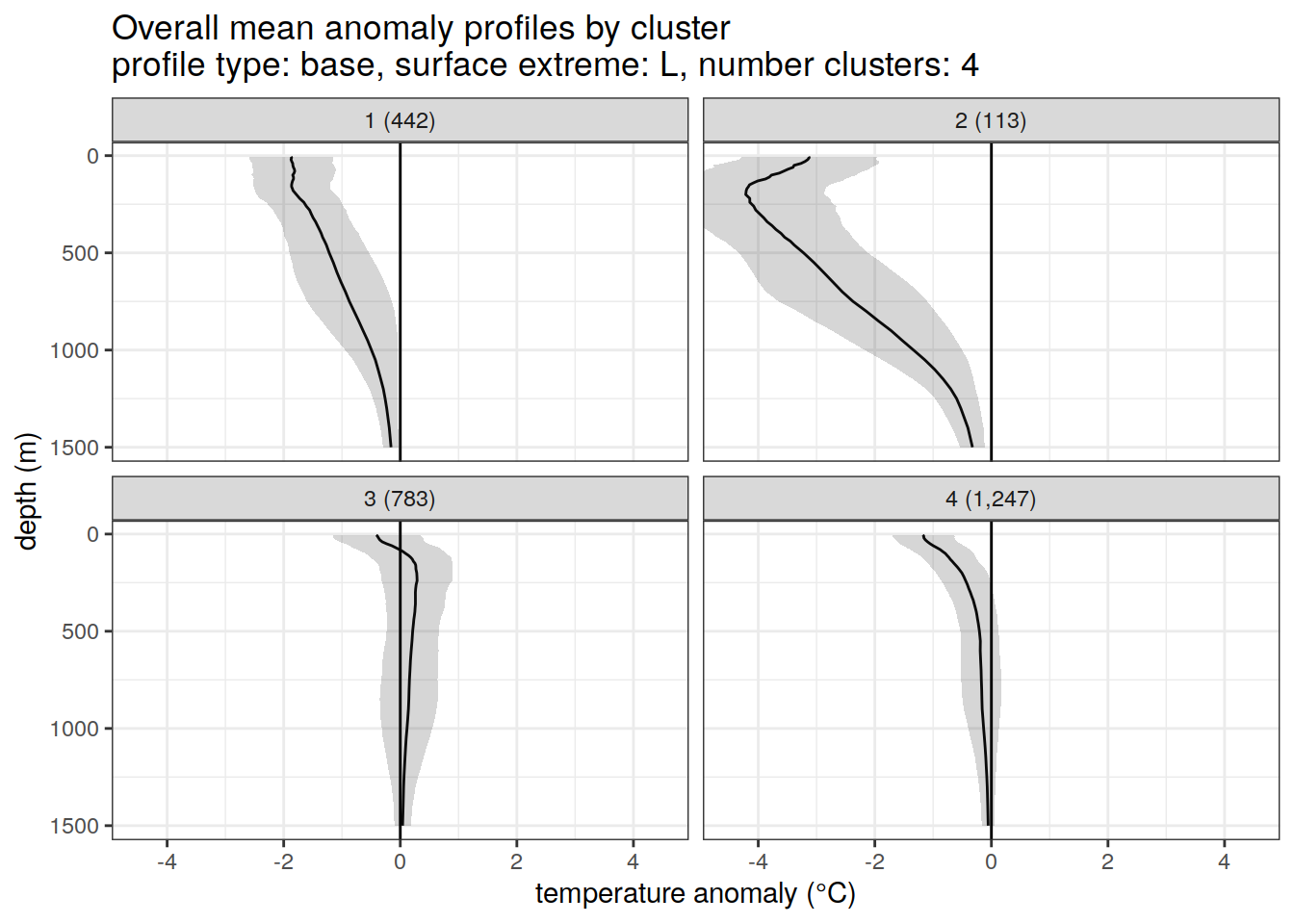
[[2]]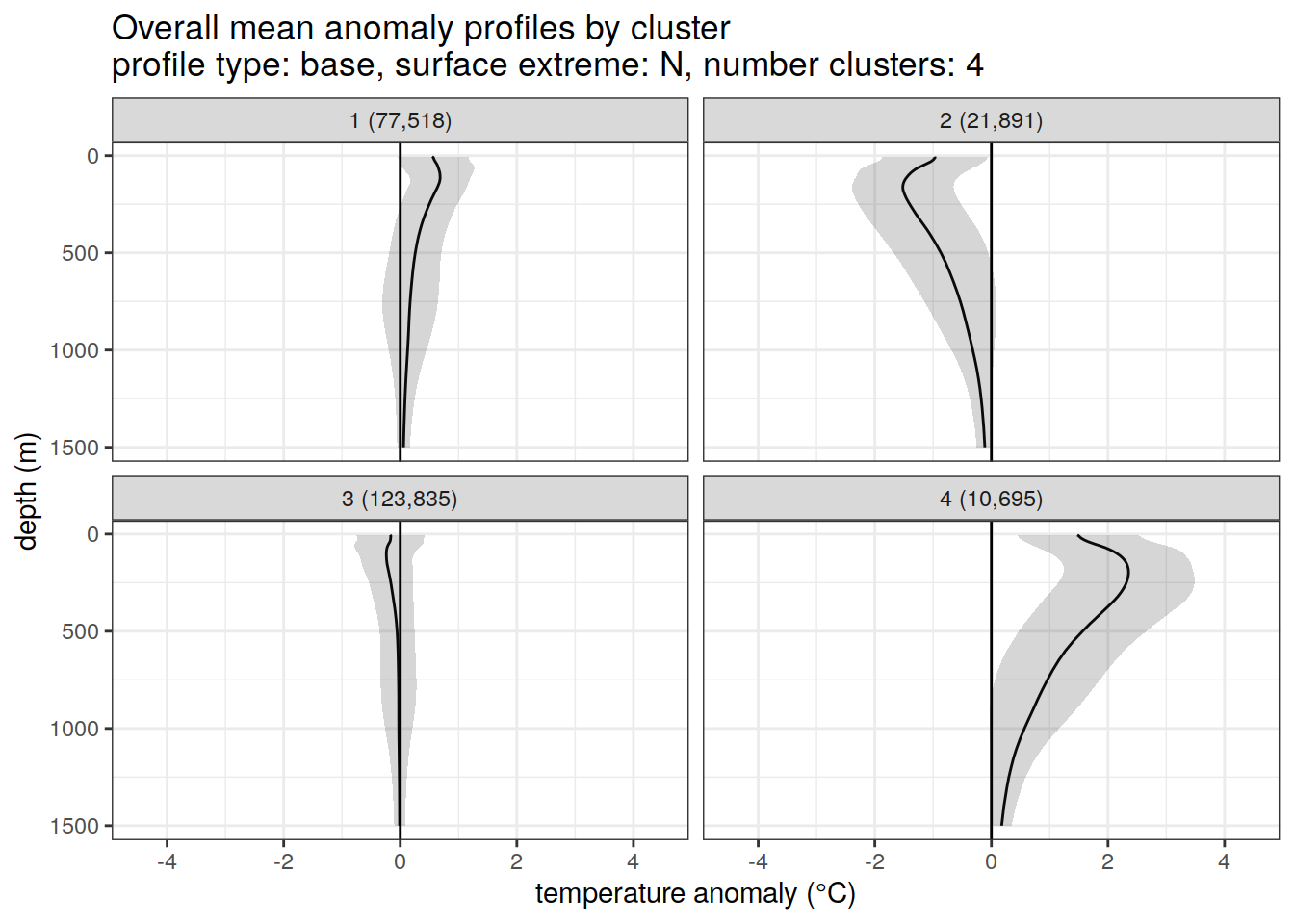
[[3]]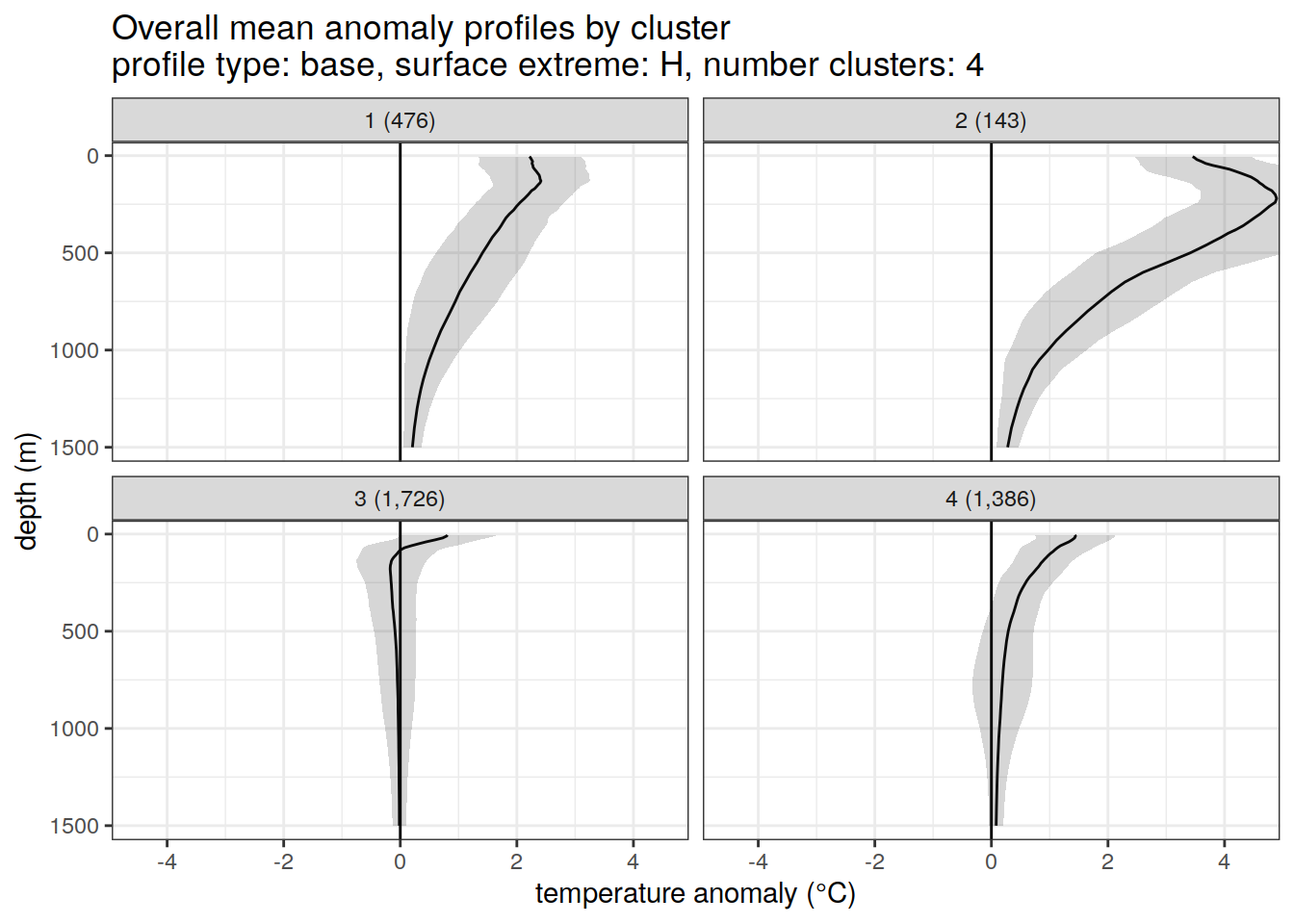
[[4]]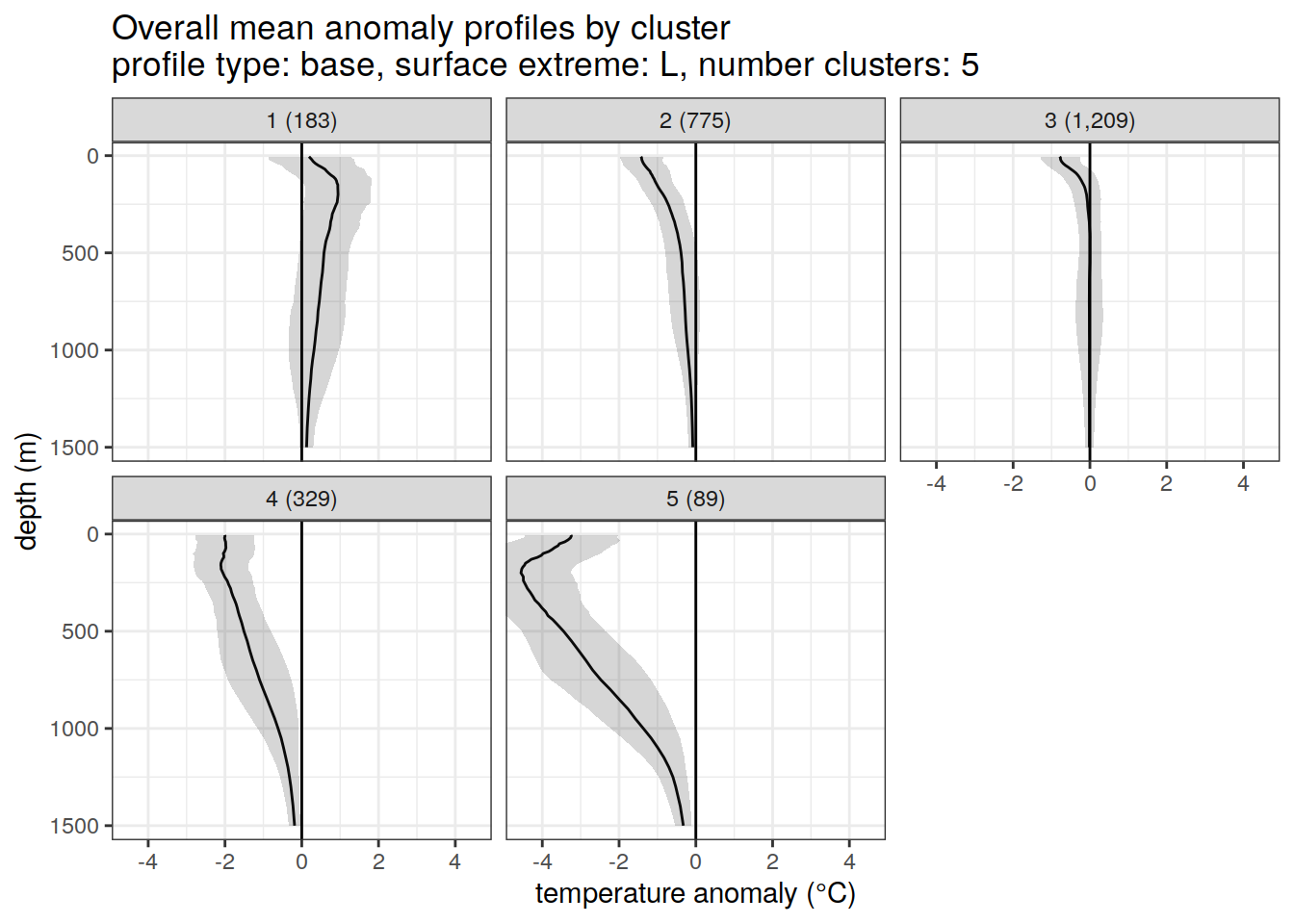
[[5]]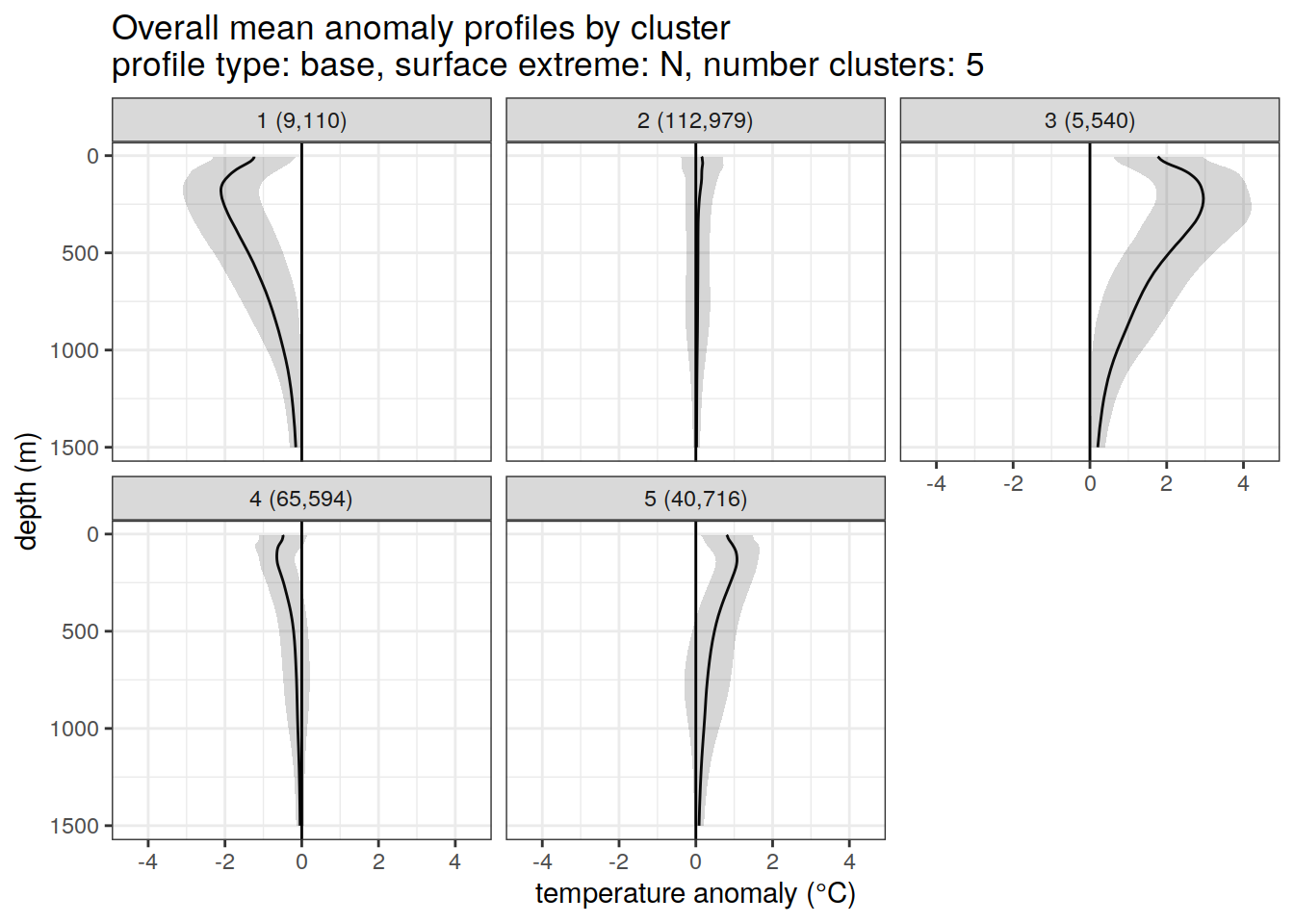
[[6]]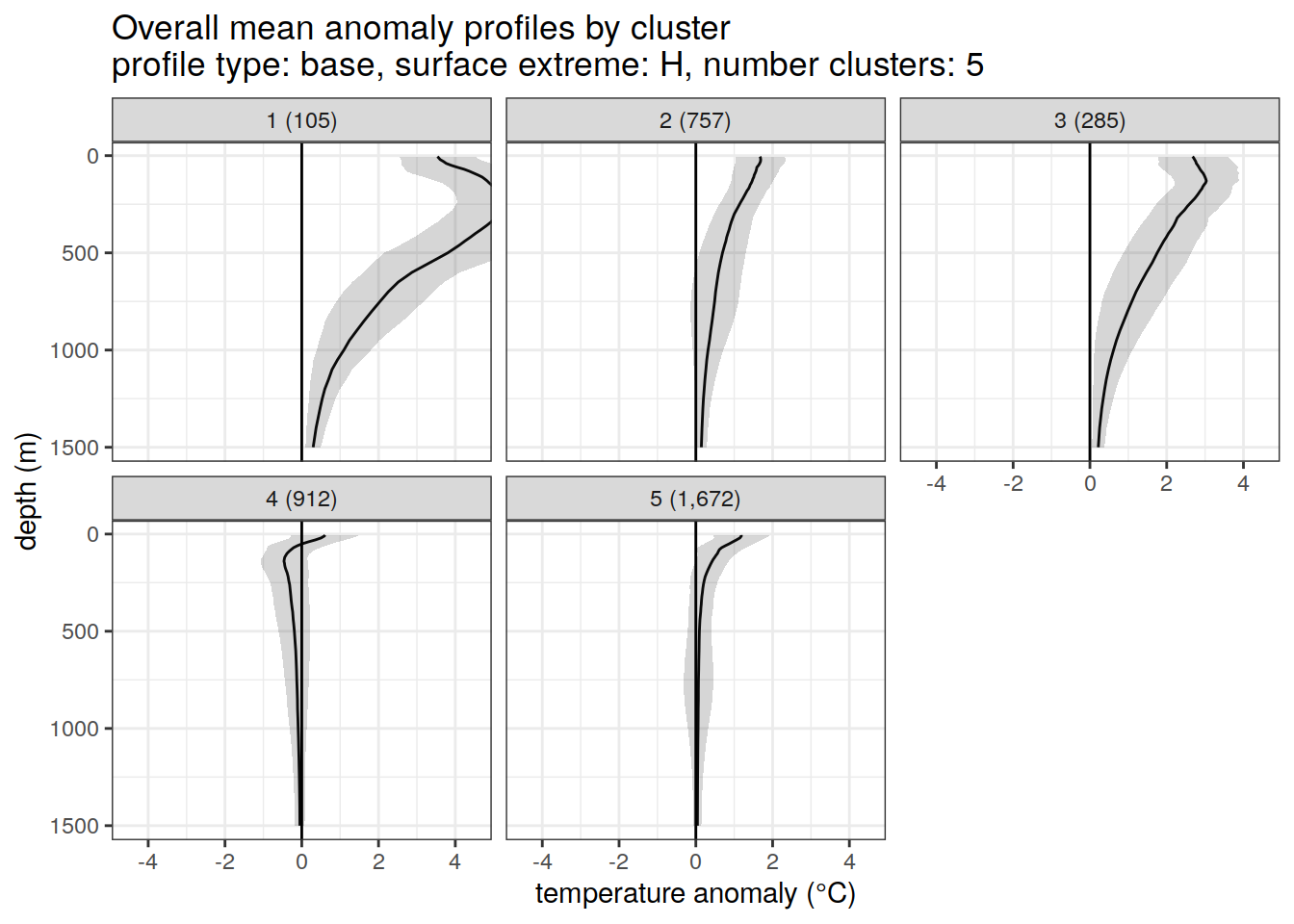
Adjusted profiles
if (opt_extreme_analysis){
if (opt_norm_anomaly) {
# create figure of cluster mean profiles
anomaly_cluster_mean_ext %>%
filter (profile_type == "adjusted") %>%
group_split(profile_type, num_clusters, extreme_order) %>%
map(
~ ggplot(data = .x, ) +
geom_path(aes(x = anomaly_mean,
y = depth)) +
geom_ribbon(
aes(
xmax = anomaly_mean + anomaly_sd,
xmin = anomaly_mean - anomaly_sd,
y = depth
),
alpha = 0.2
) +
geom_vline(xintercept = 0) +
scale_y_reverse() +
#facet_wrap(~ cluster) +
facet_wrap(~ paste0(cluster, " (", formatC(count_profiles, big.mark=",") , ")")) +
coord_cartesian(xlim = opt_xlim_adjusted) +
scale_x_continuous(breaks = opt_xbreaks_adjusted) +
labs(
title = paste0(
'Overall mean anomaly profiles by cluster \n',
'profile type: ', unique(.x$profile_type), ', ',
'surface extreme: ', unique(.x$extreme), ', ',
'number clusters: ', unique(.x$num_clusters)
),
x = opt_measure_label_adjusted,
y = 'depth (m)'
)
)
}
}[[1]]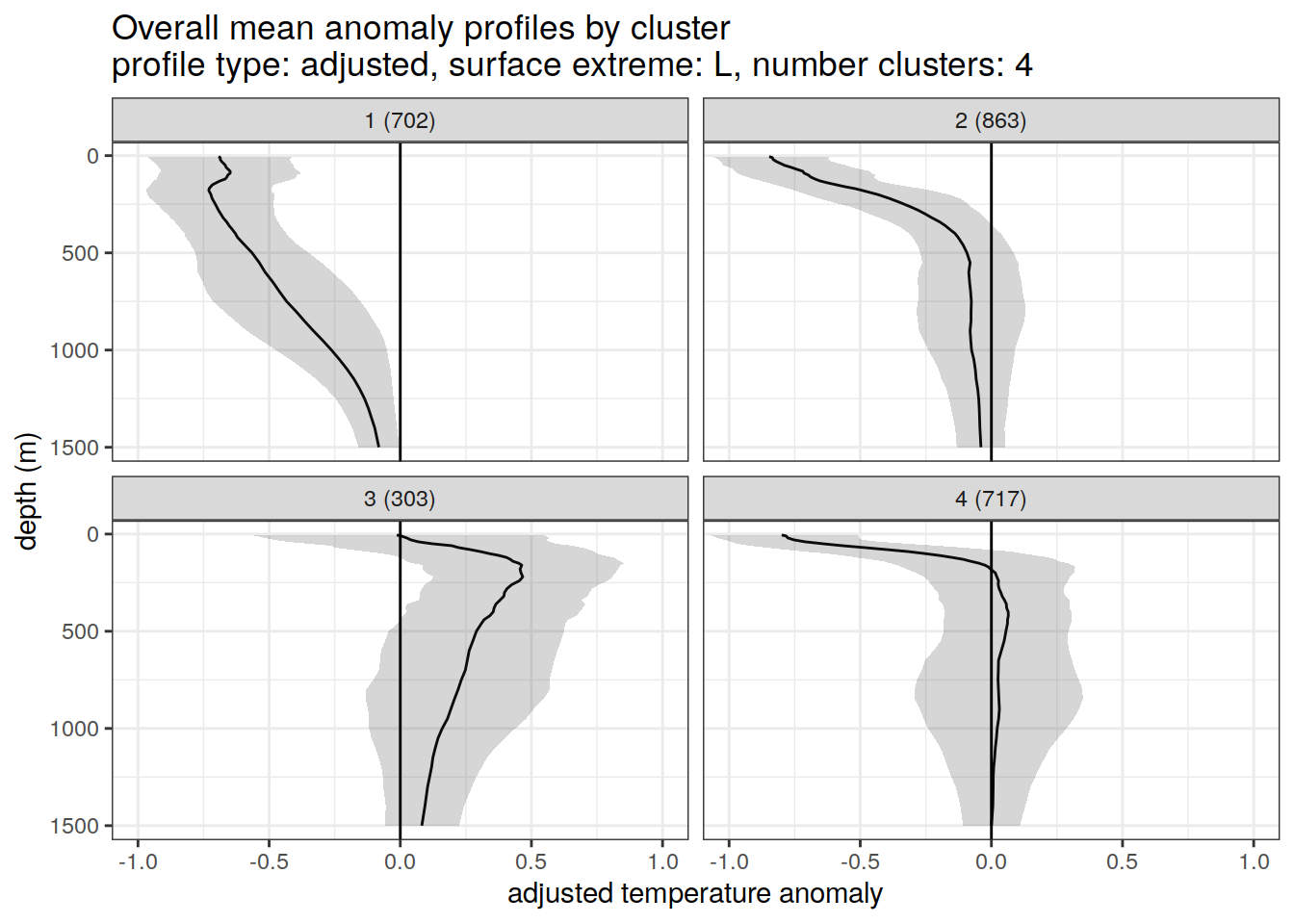
[[2]]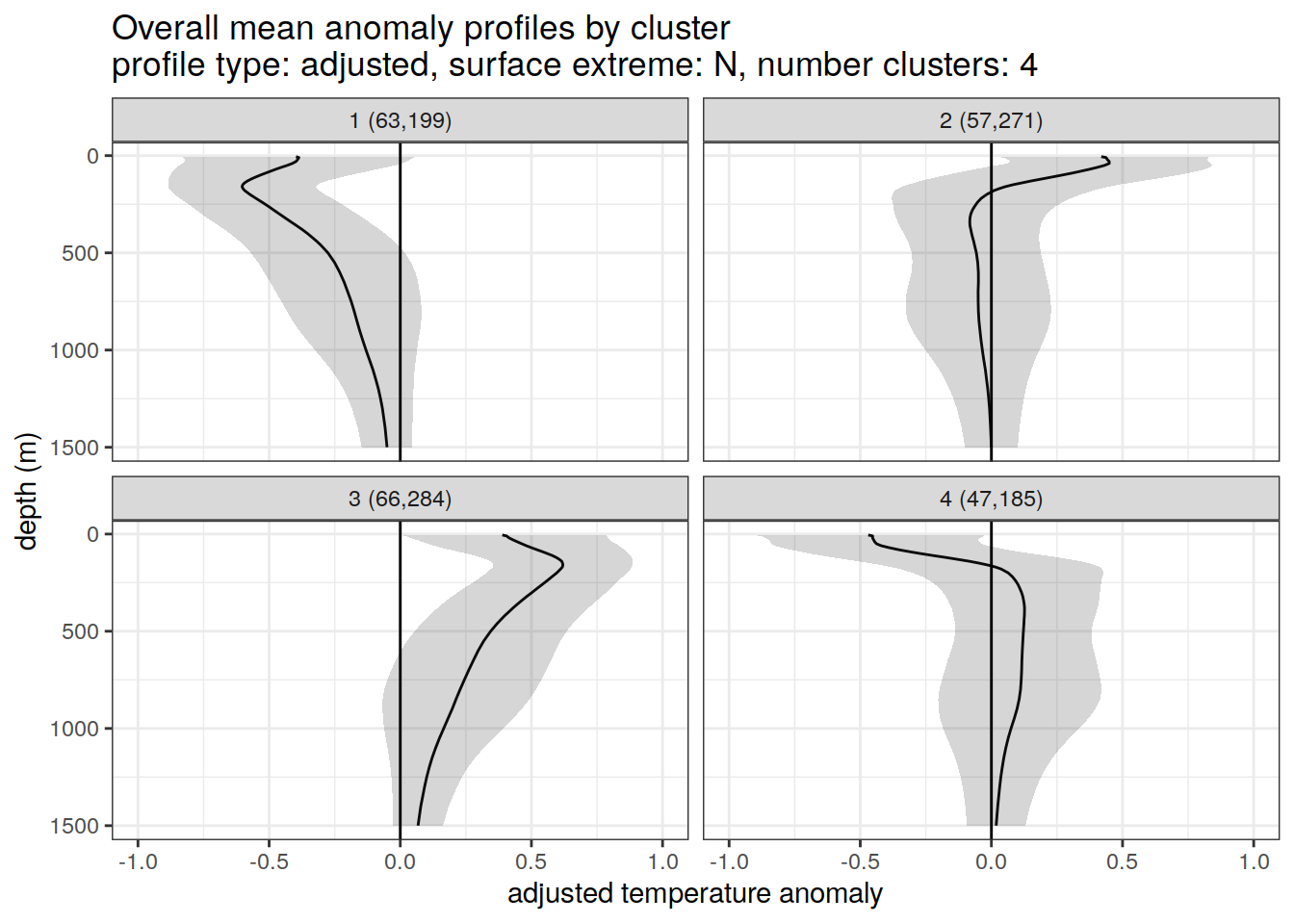
[[3]]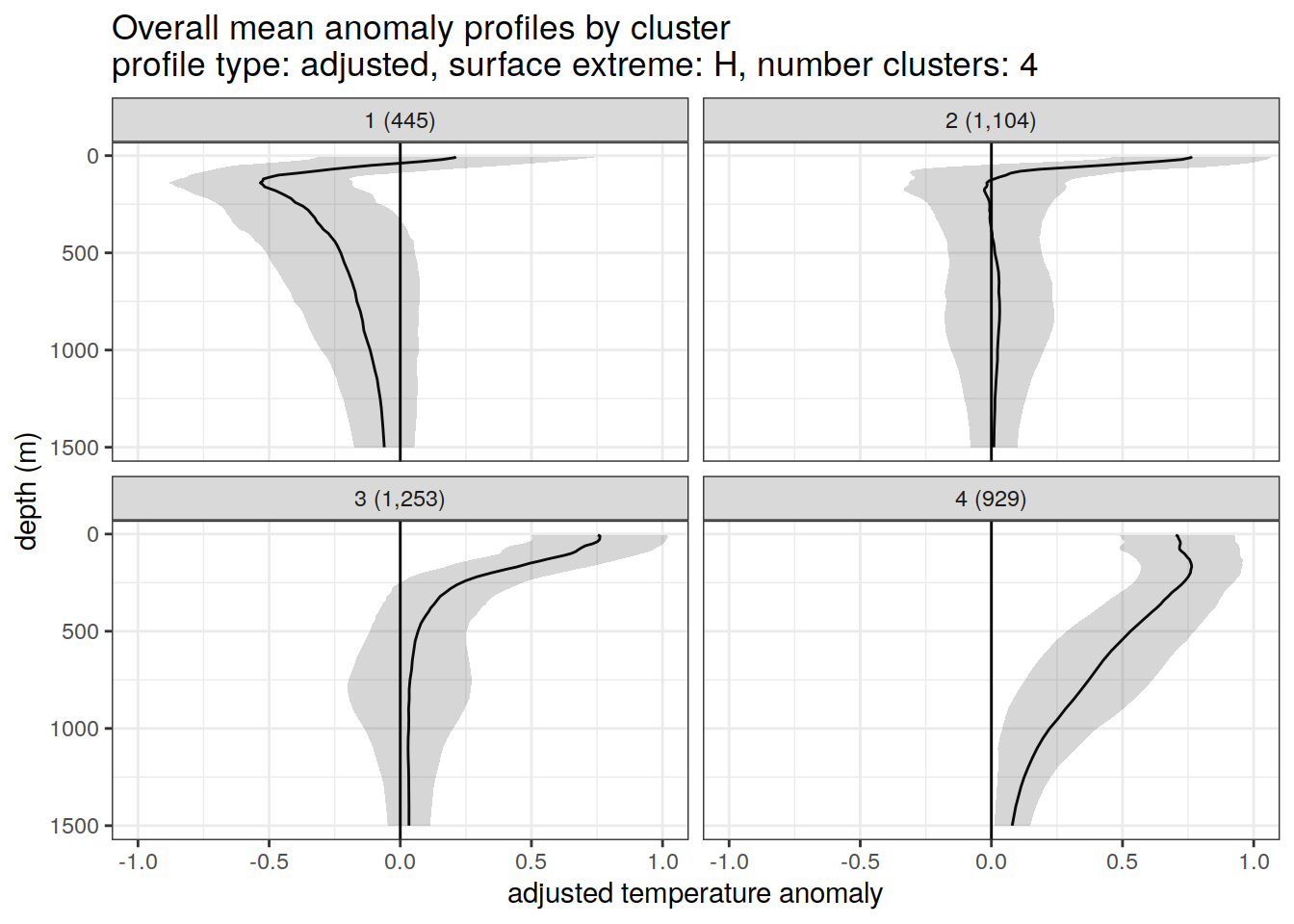
[[4]]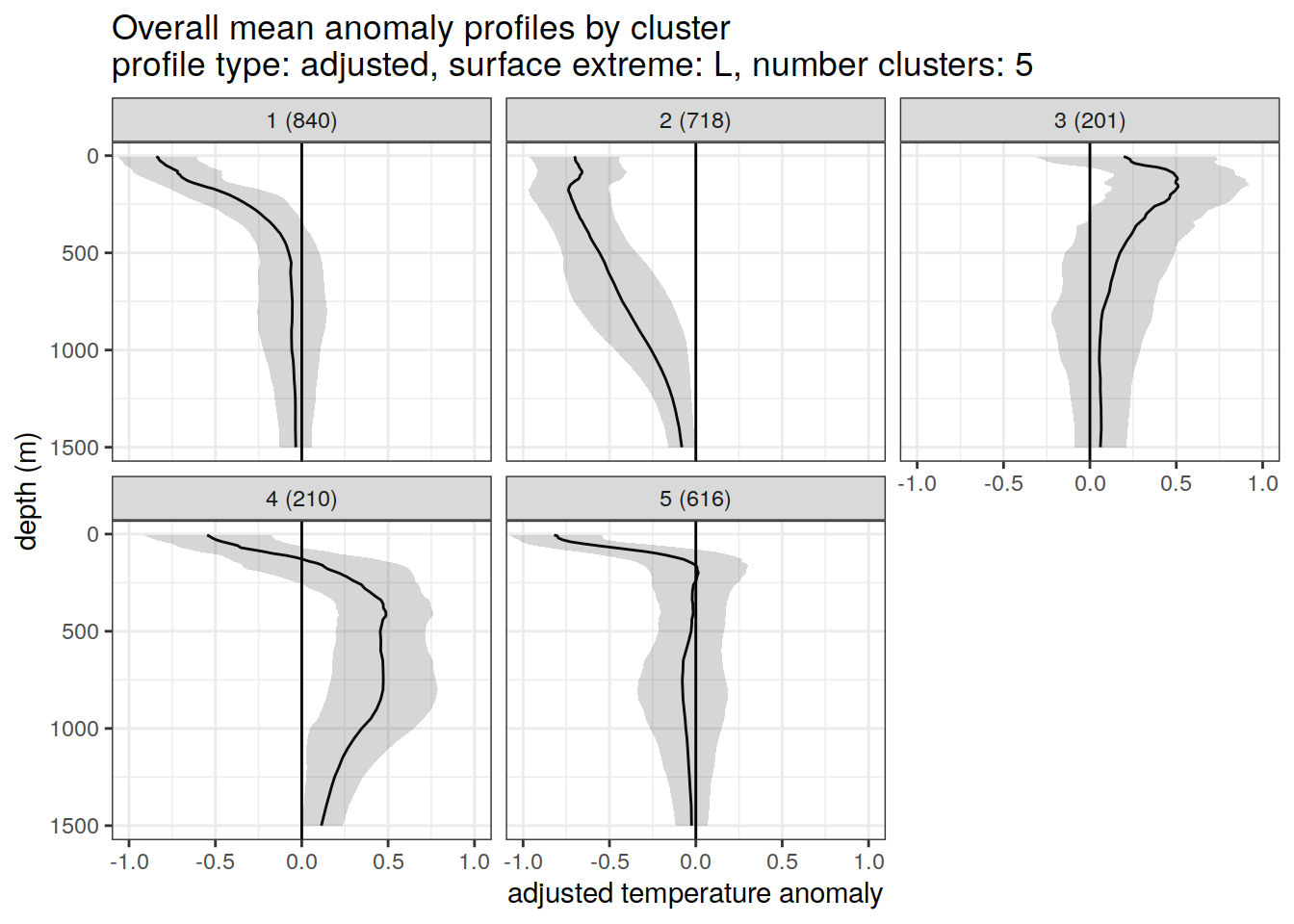
[[5]]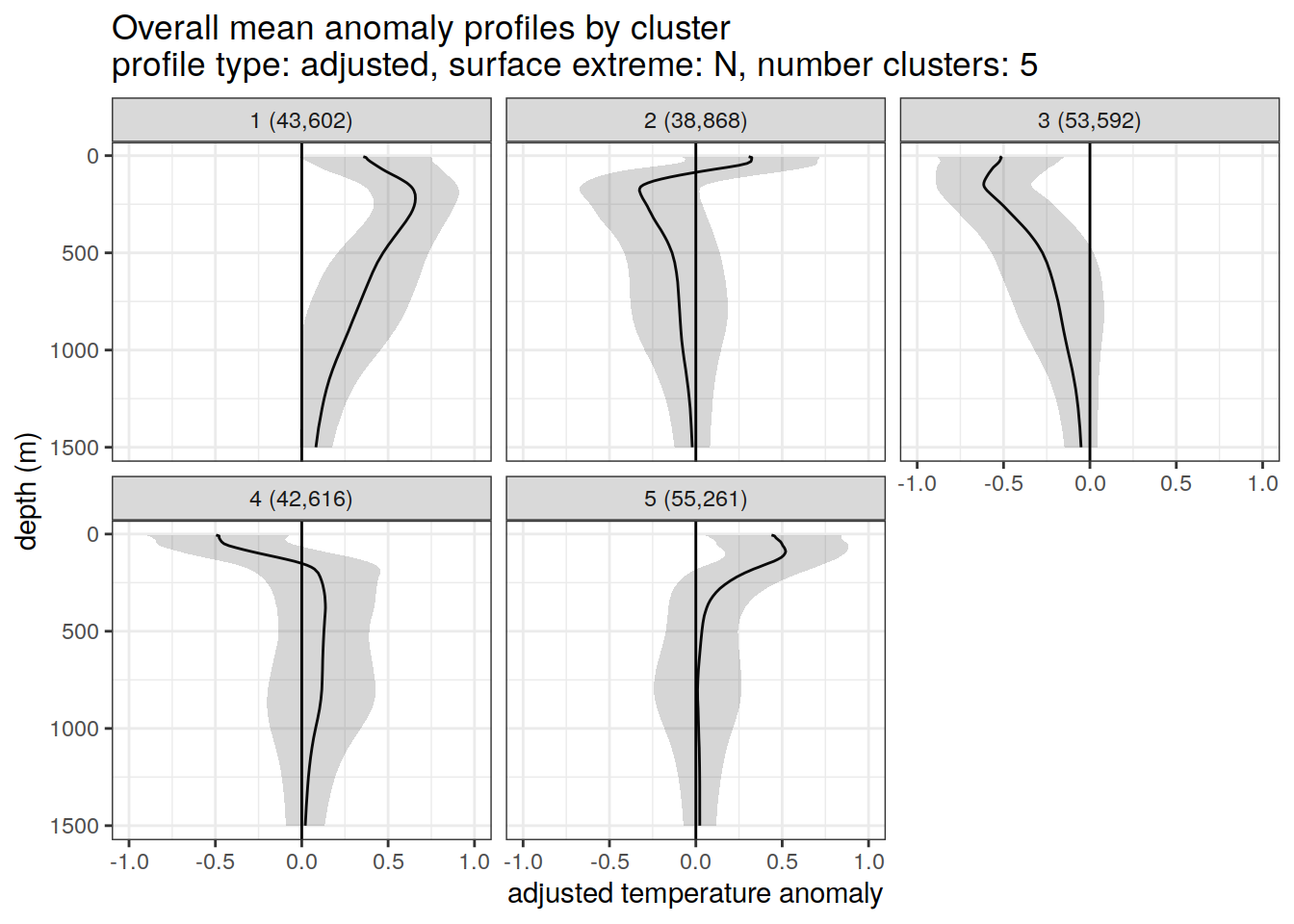
[[6]]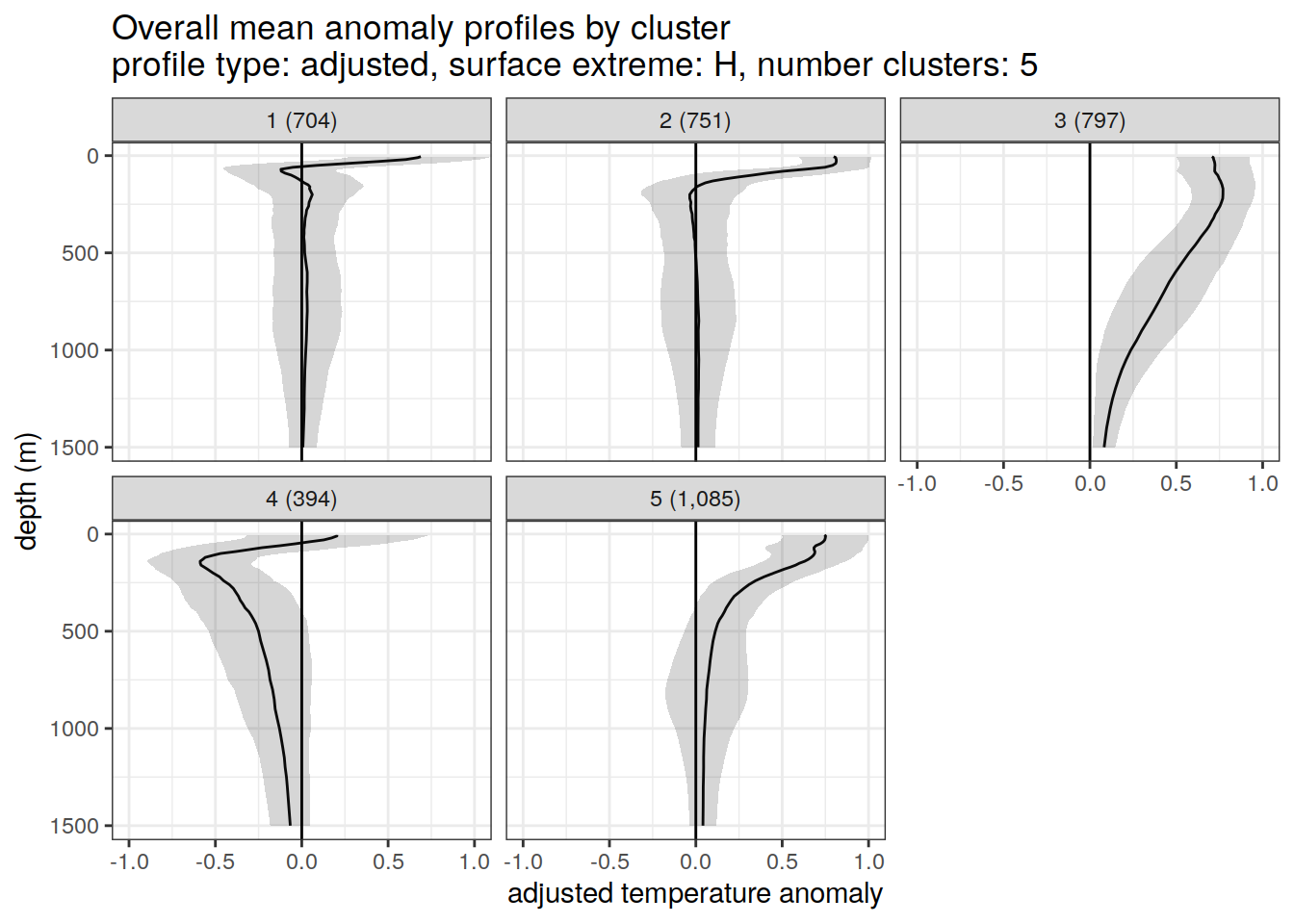
Clusters mean by year
if (opt_extreme_analysis){
# cluster means by year
anomaly_cluster_mean_year_ext %>%
filter (profile_type == "base") %>%
mutate(year = as.factor(year)) %>%
group_split(profile_type, num_clusters, extreme_order) %>%
map(
~ ggplot(data = .x,) +
geom_path(aes(
x = anomaly_mean,
y = depth,
col = year
)) +
geom_vline(xintercept = 0) +
scale_y_reverse() +
facet_wrap(~ cluster) +
coord_cartesian(xlim = opt_xlim) +
scale_x_continuous(breaks = opt_xbreaks) +
scale_color_viridis_d() +
labs(
title = paste0(
'Overall mean anomaly profiles by cluster by year \n',
'profile type: ', unique(.x$profile_type), ', ',
'surface extreme: ', unique(.x$extreme), ', ',
'number clusters: ', unique(.x$num_clusters)
),
x = opt_measure_label,
y = 'depth (m)'
)
)
}[[1]]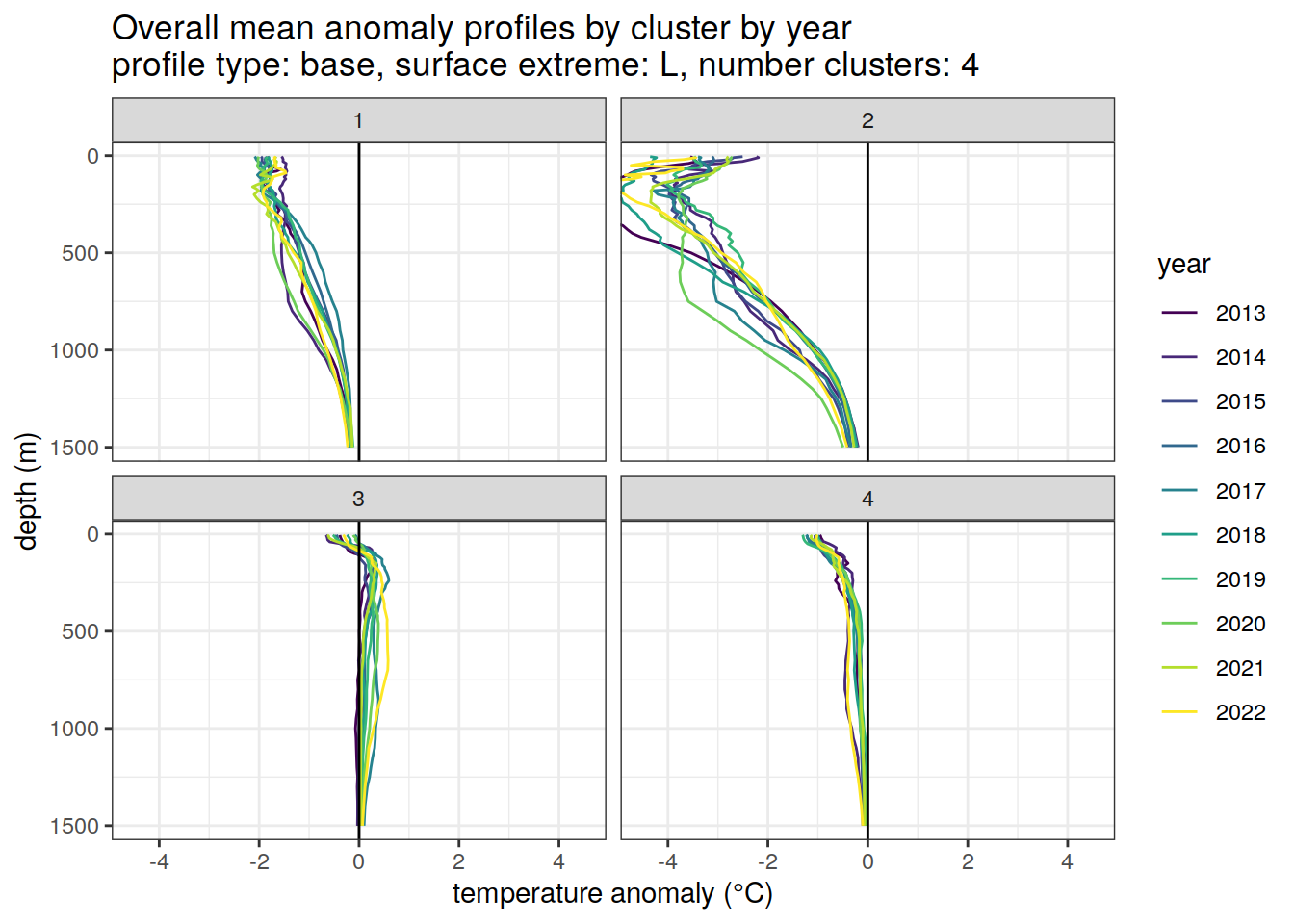
[[2]]
[[3]]
[[4]]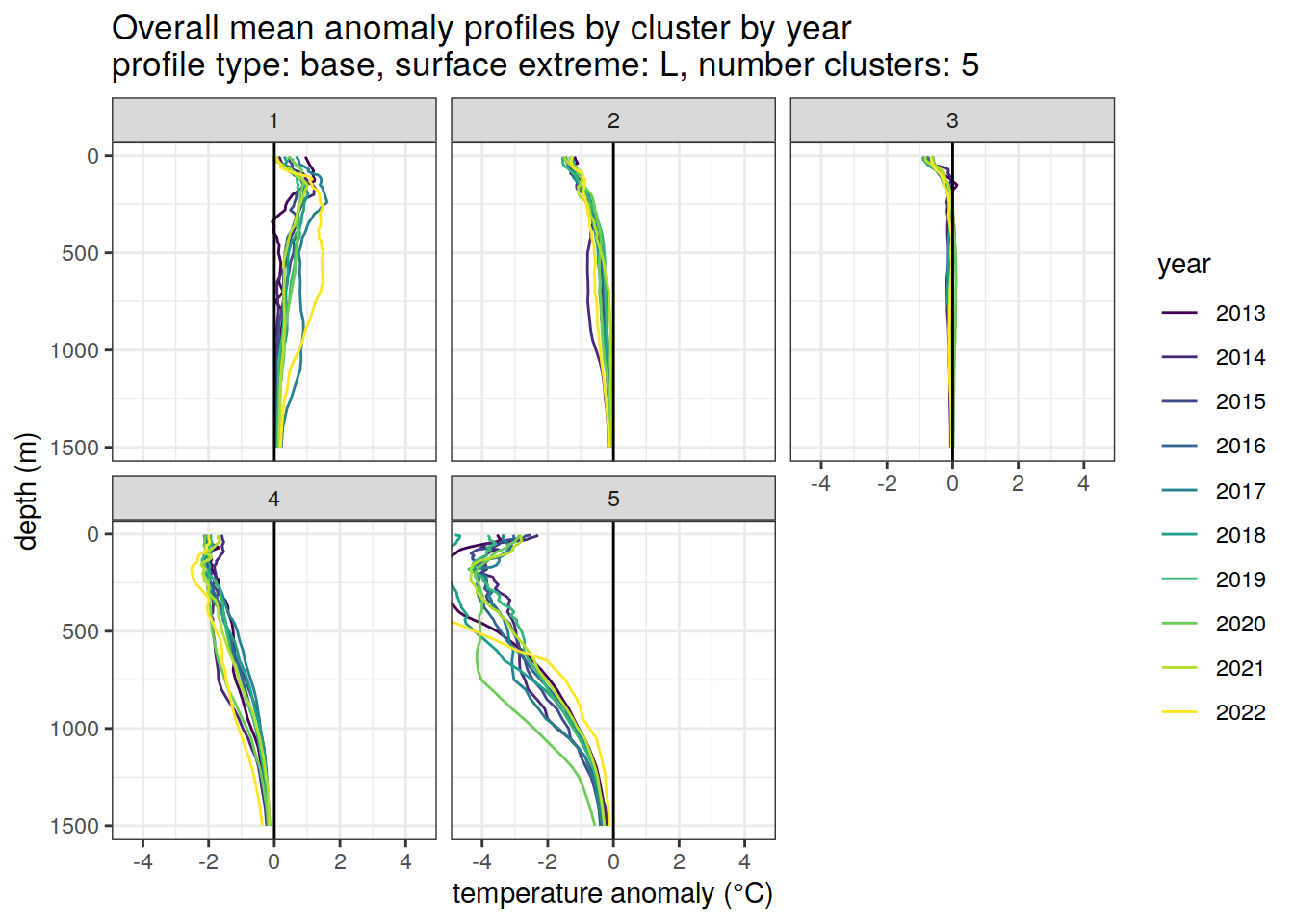
[[5]]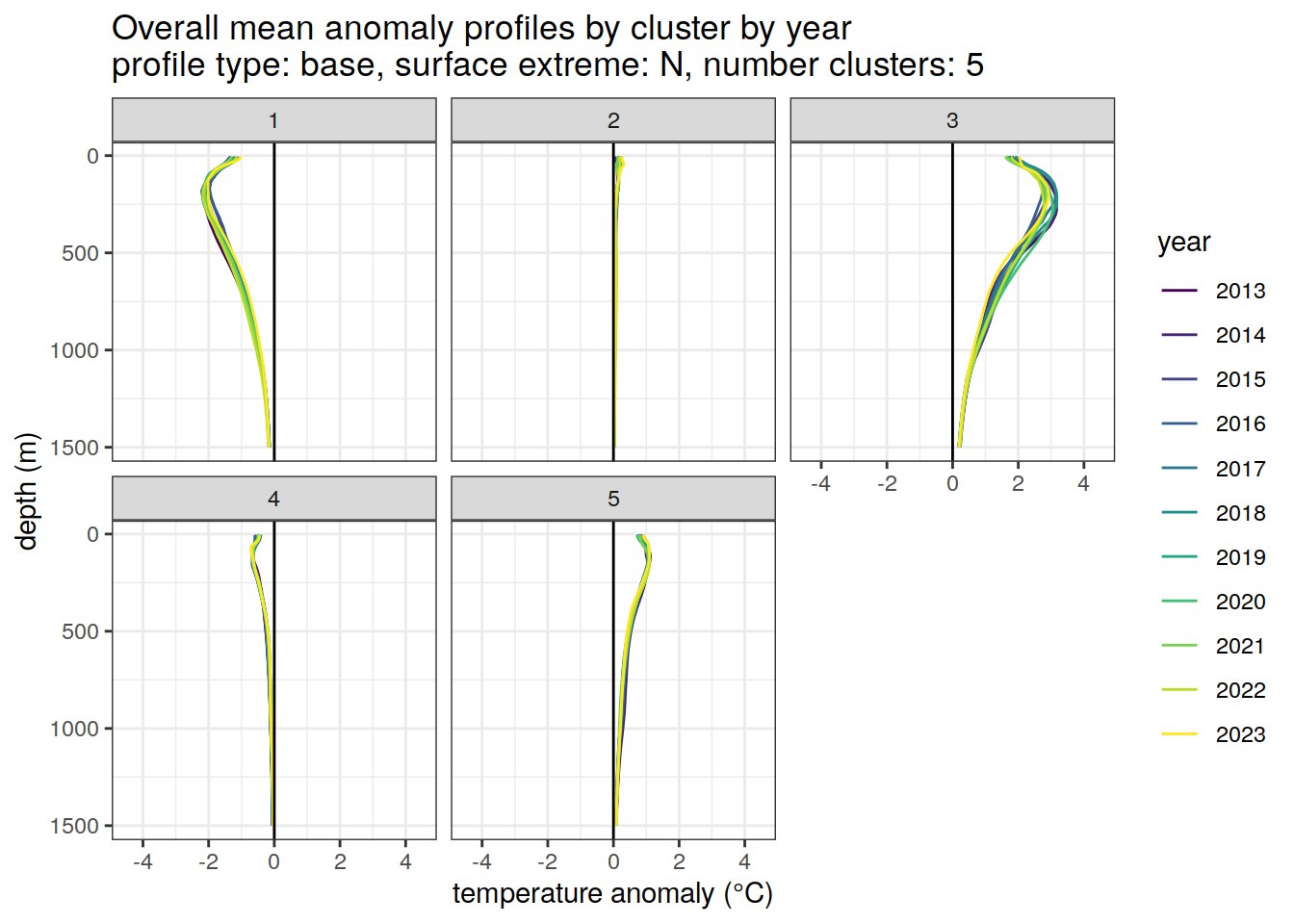
[[6]]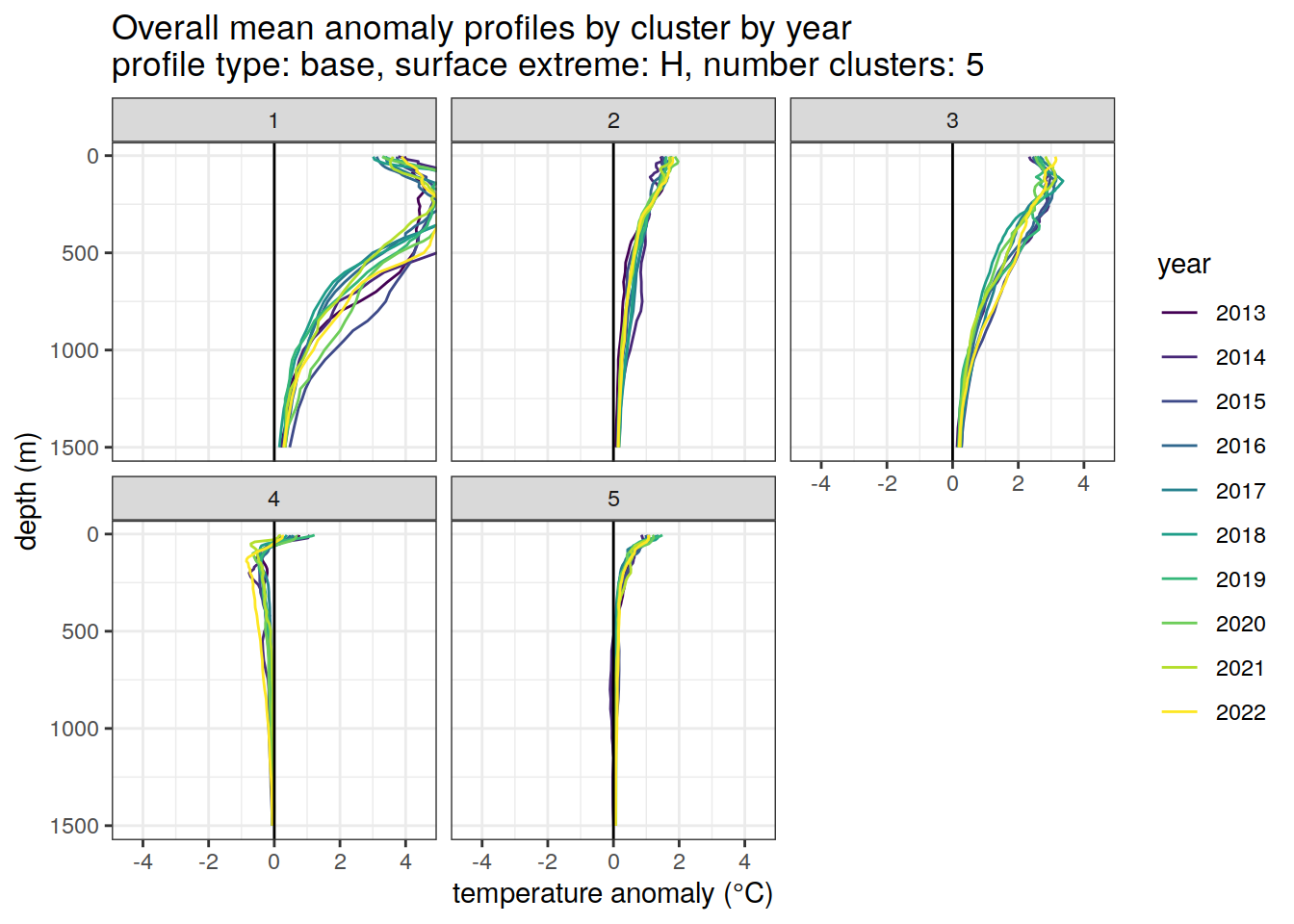
Adjusted profiles
if (opt_extreme_analysis){
if (opt_norm_anomaly) {
# cluster means by year
anomaly_cluster_mean_year_ext %>%
filter (profile_type == "adjusted") %>%
mutate(year = as.factor(year)) %>%
group_split(profile_type, num_clusters, extreme_order) %>%
map(
~ ggplot(data = .x,) +
geom_path(aes(
x = anomaly_mean,
y = depth,
col = year
)) +
geom_vline(xintercept = 0) +
scale_y_reverse() +
facet_wrap(~ cluster) +
coord_cartesian(xlim = opt_xlim_adjusted) +
scale_x_continuous(breaks = opt_xbreaks_adjusted) +
scale_color_viridis_d() +
labs(
title = paste0(
'Overall mean anomaly profiles by cluster by year \n',
'profile type: ', unique(.x$profile_type), ', ',
'surface extreme: ', unique(.x$extreme), ', ',
'number clusters: ', unique(.x$num_clusters)
),
x = opt_measure_label_adjusted,
y = 'depth (m)'
)
)
}
}[[1]]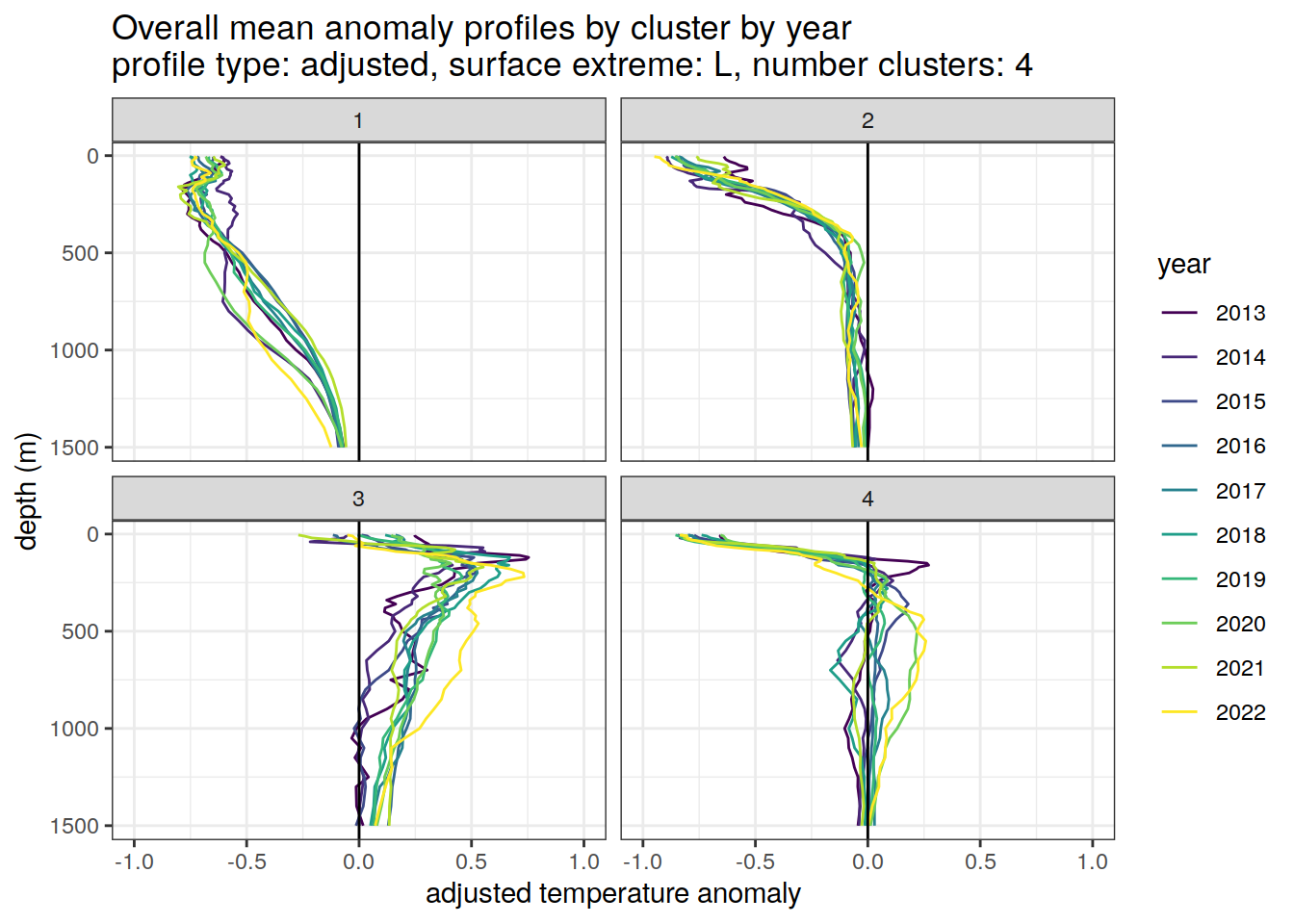
[[2]]
[[3]]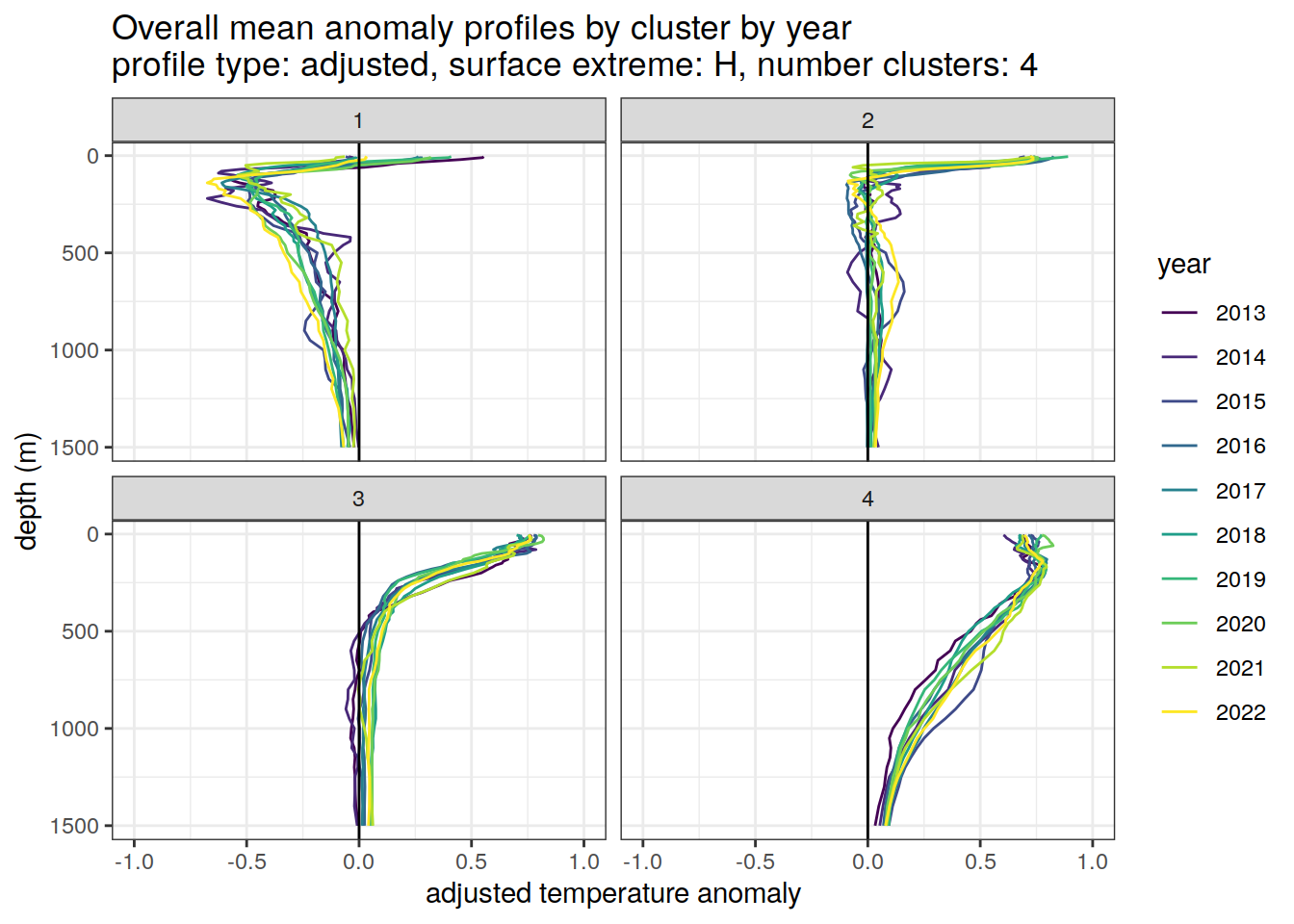
[[4]]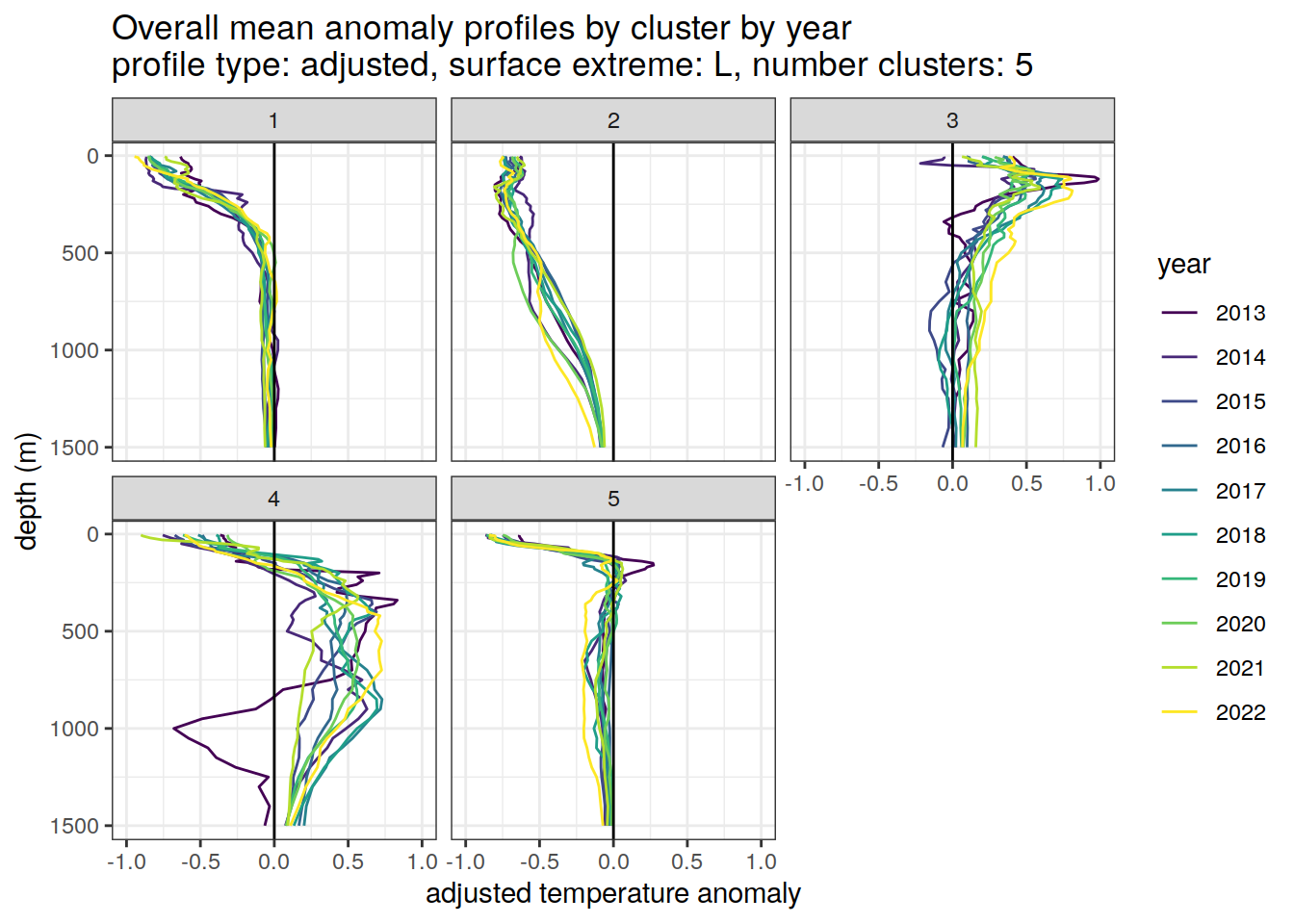
[[5]]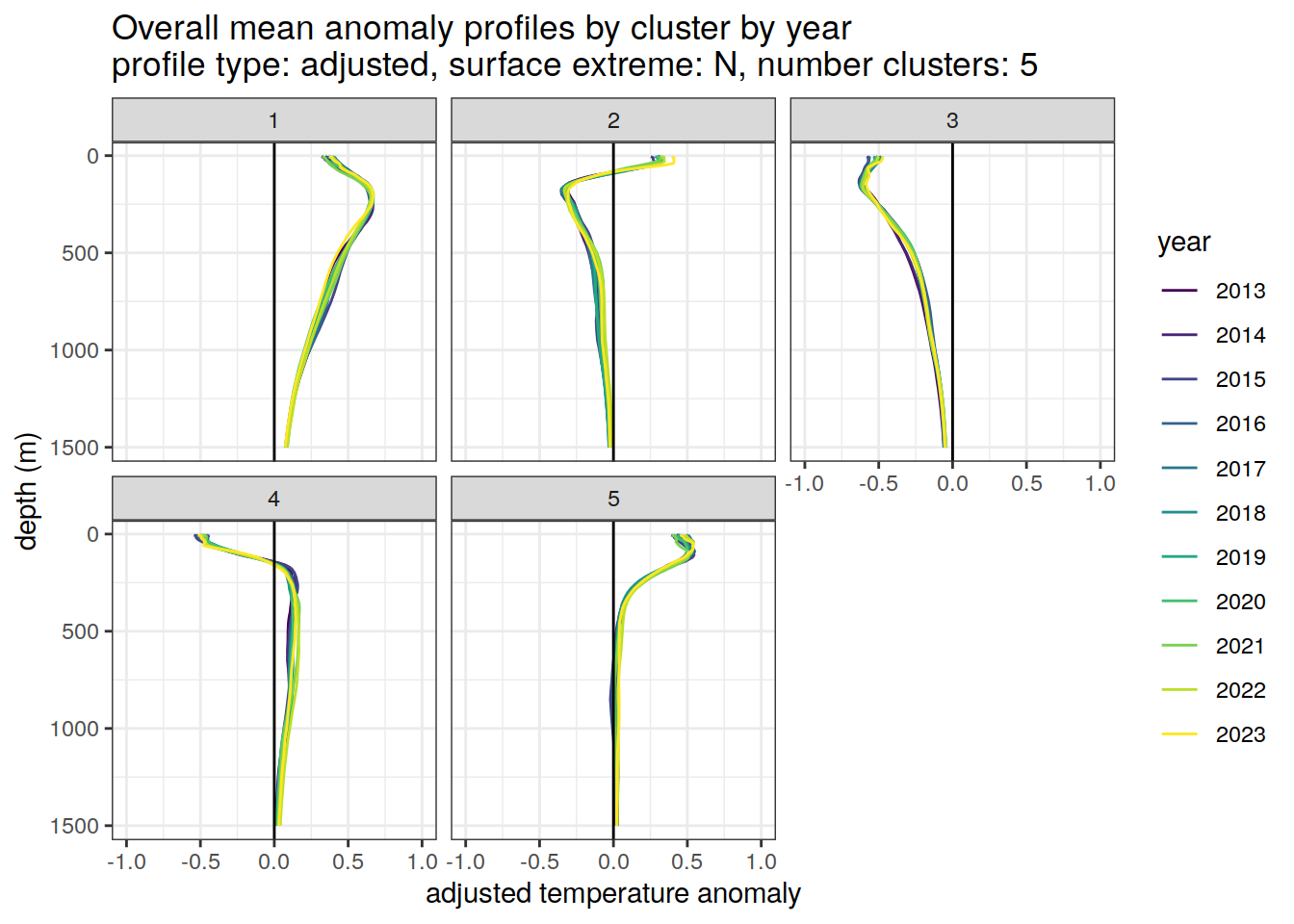
[[6]]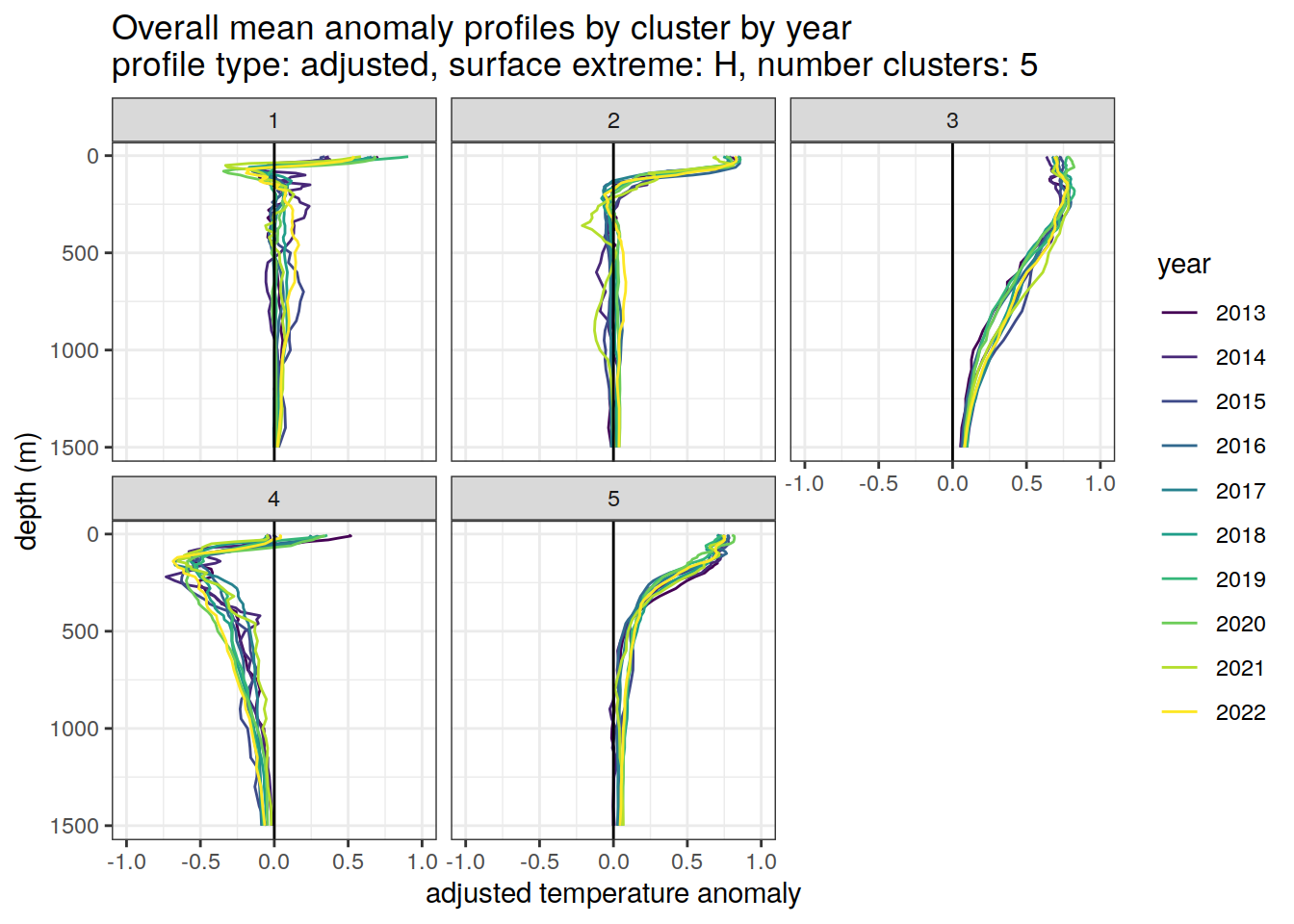
Cluster by year
count of each cluster by year
if (opt_extreme_analysis){
# Determine profile count by extreme and cluster and year
# Count the measurements
cluster_by_year <- anomaly_cluster_ext %>%
count(file_id, profile_type, num_clusters, extreme_order, extreme, cluster, year,
name = "count_cluster")
# Convert to profiles
cluster_by_year <- cluster_by_year %>%
count(profile_type, num_clusters, extreme_order, extreme, cluster, year,
name = "count_cluster")
year_min <- min(cluster_by_year$year)
year_max <- max(cluster_by_year$year)
# create figure
cluster_by_year %>%
filter (profile_type == "base") %>%
group_split(profile_type, num_clusters, extreme_order) %>%
map(
~ ggplot(
data = .x,
aes(
x = year,
y = count_cluster,
col = cluster,
group = cluster
)
) +
geom_point() +
geom_line() +
scale_x_continuous(breaks = seq(year_min, year_max, 2)) +
scale_color_brewer(palette = 'Dark2') +
labs(
x = 'year',
y = 'number of profiles',
col = 'cluster',
title = paste0(
'Count of profiles by year and cluster \n',
'profile type: ', unique(.x$profile_type), ', ',
'surface extreme: ', unique(.x$extreme), ', ',
'number clusters: ', unique(.x$num_clusters)
)
)
)
}[[1]]
[[2]]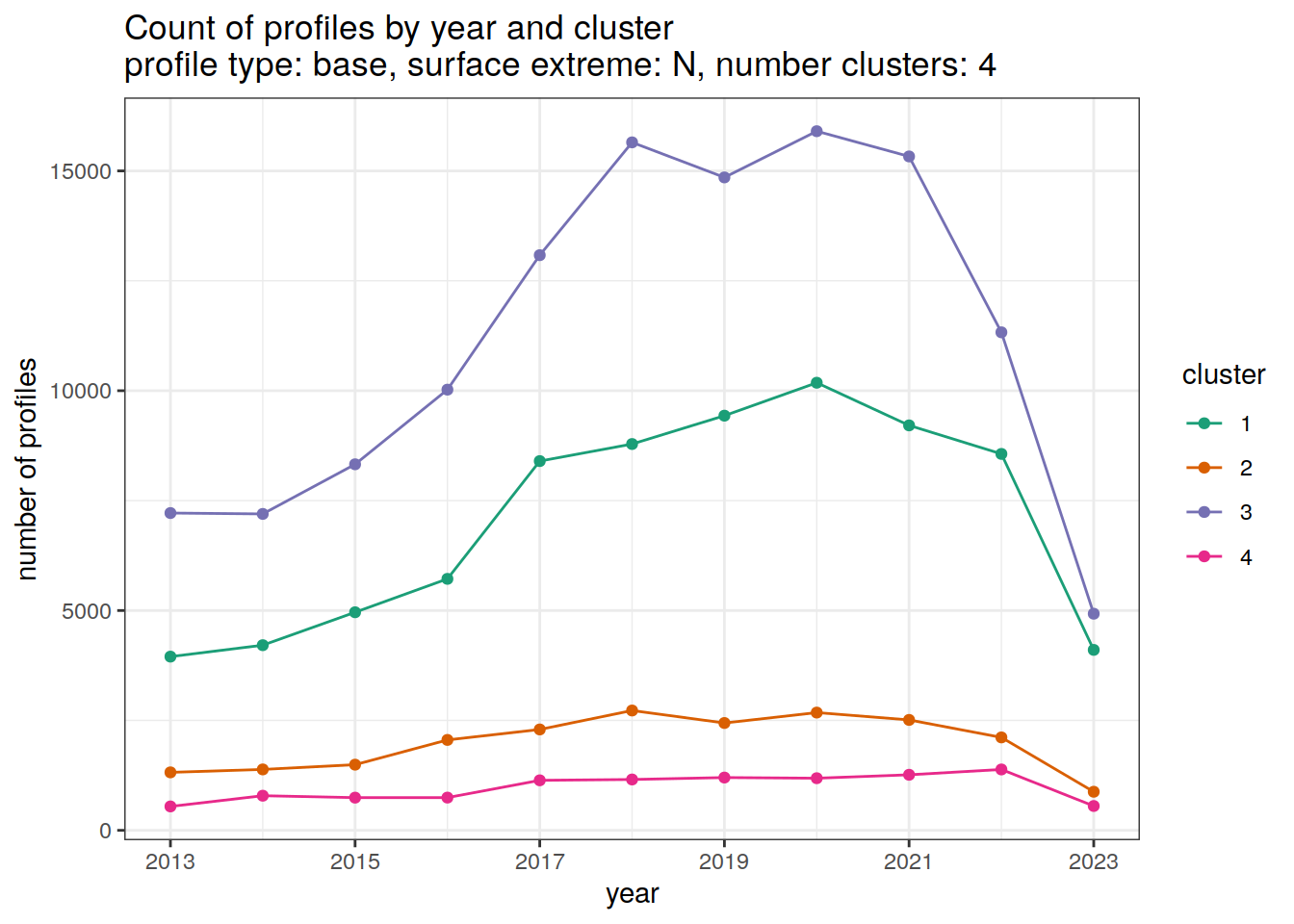
[[3]]
[[4]]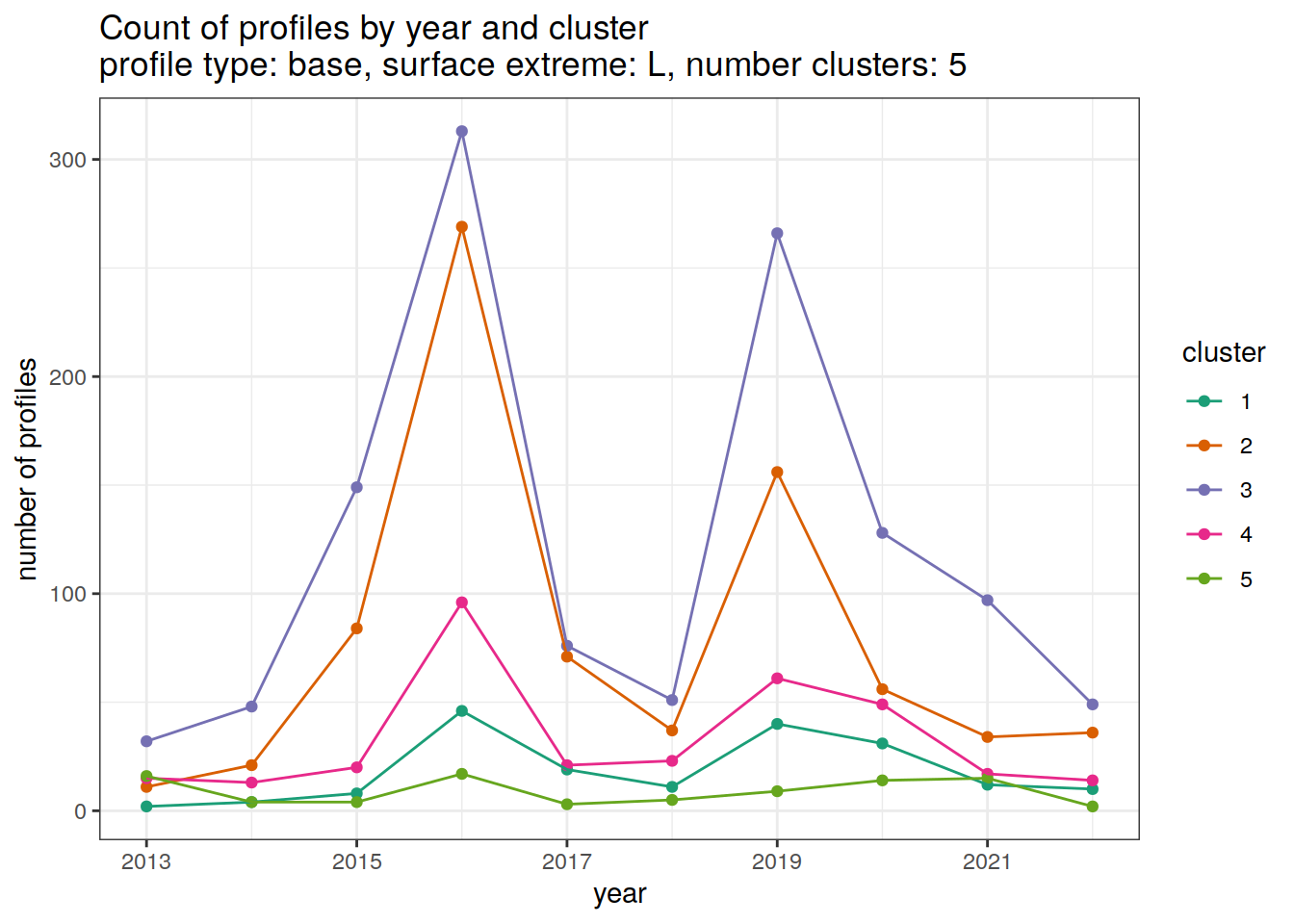
[[5]]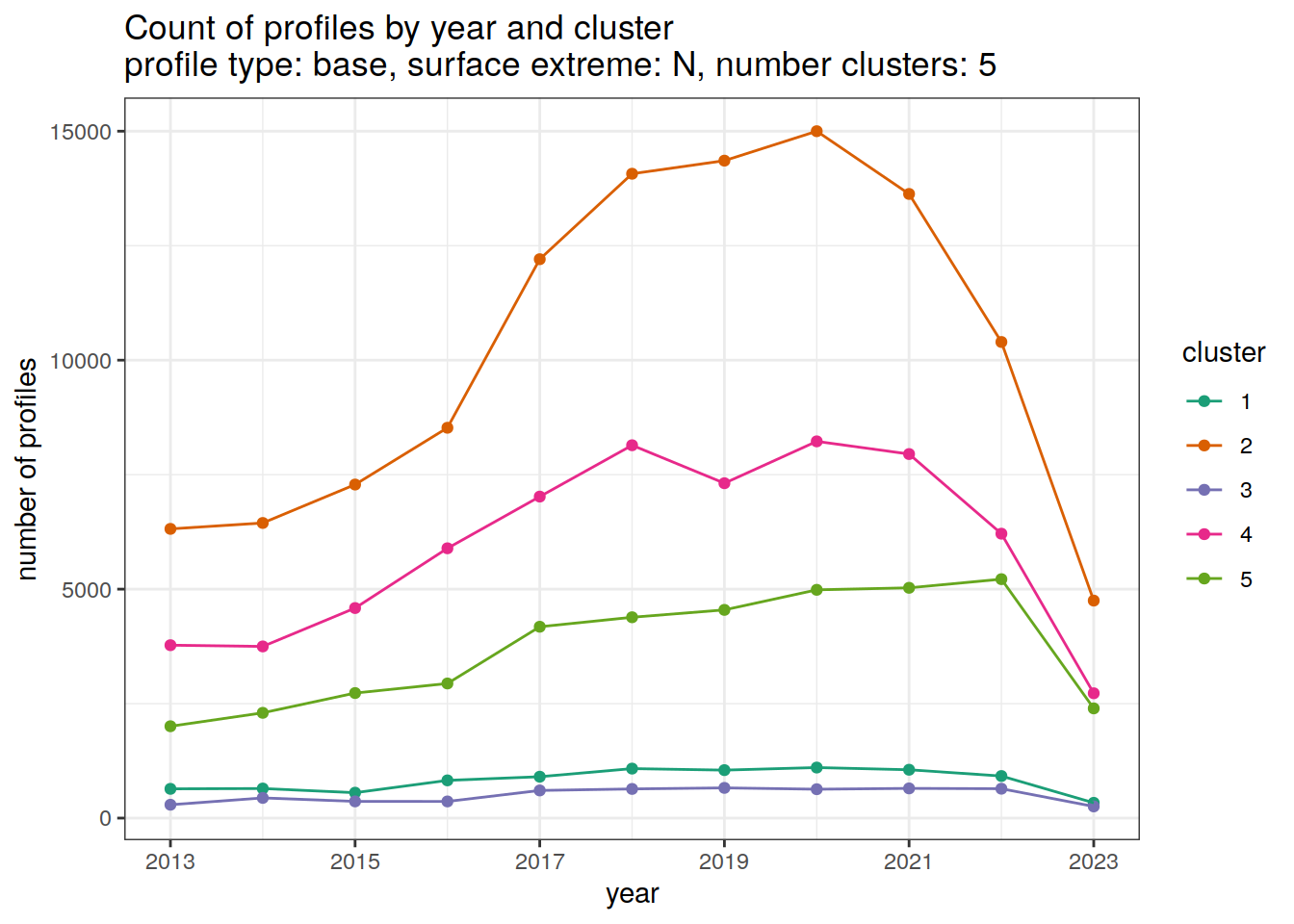
[[6]]
Adjusted profiles
if (opt_extreme_analysis){
if (opt_norm_anomaly) {
# create figure
cluster_by_year %>%
filter (profile_type == "adjusted") %>%
group_split(profile_type, num_clusters, extreme_order) %>%
map(
~ ggplot(
data = .x,
aes(
x = year,
y = count_cluster,
col = cluster,
group = cluster
)
) +
geom_point() +
geom_line() +
scale_x_continuous(breaks = seq(year_min, year_max, 2)) +
scale_color_brewer(palette = 'Dark2') +
labs(
x = 'year',
y = 'number of profiles',
col = 'cluster',
title = paste0(
'Count of profiles by year and cluster \n',
'profile type: ', unique(.x$profile_type), ', ',
'surface extreme: ', unique(.x$extreme), ', ',
'number clusters: ', unique(.x$num_clusters)
)
)
)
}
}[[1]]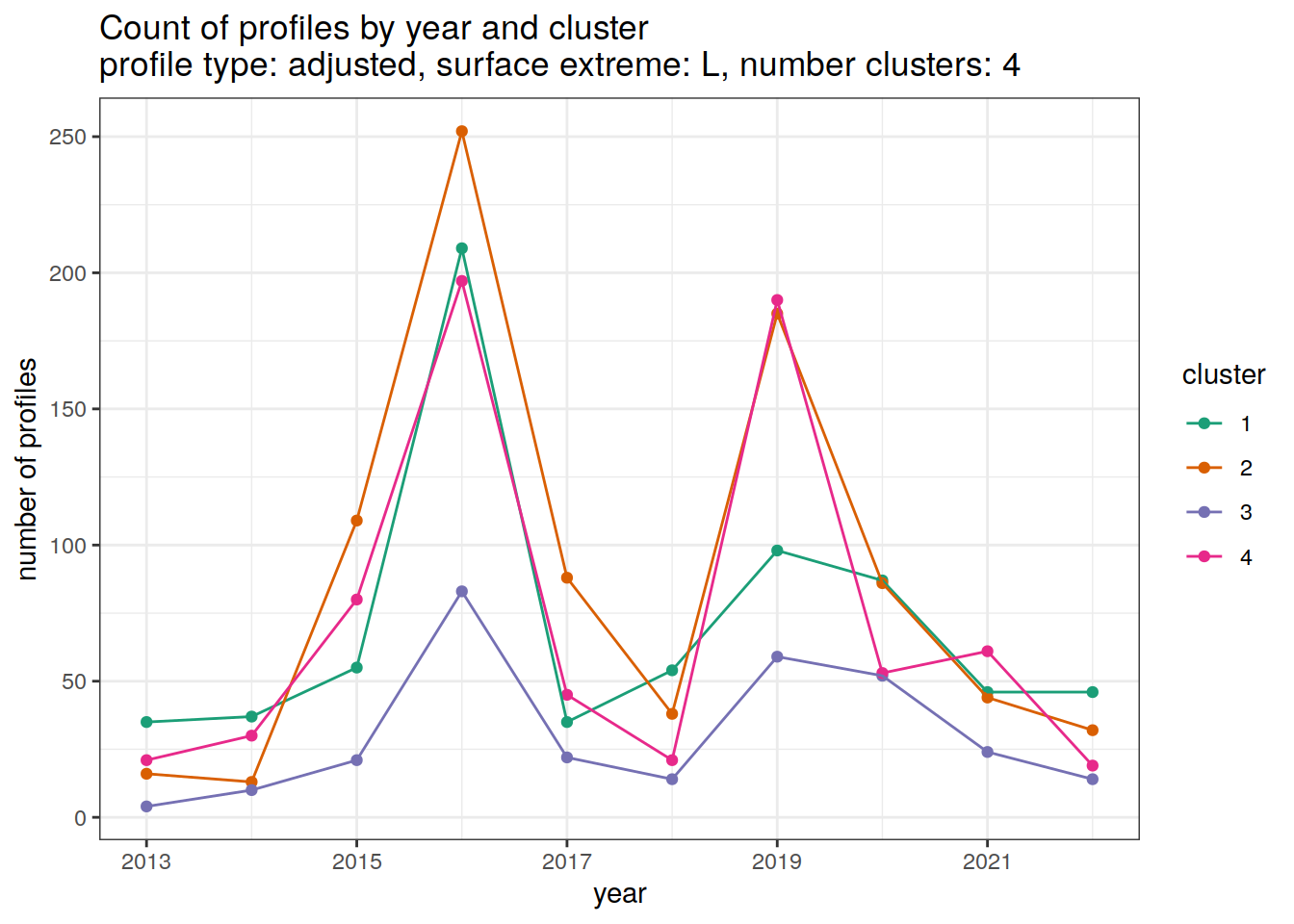
[[2]]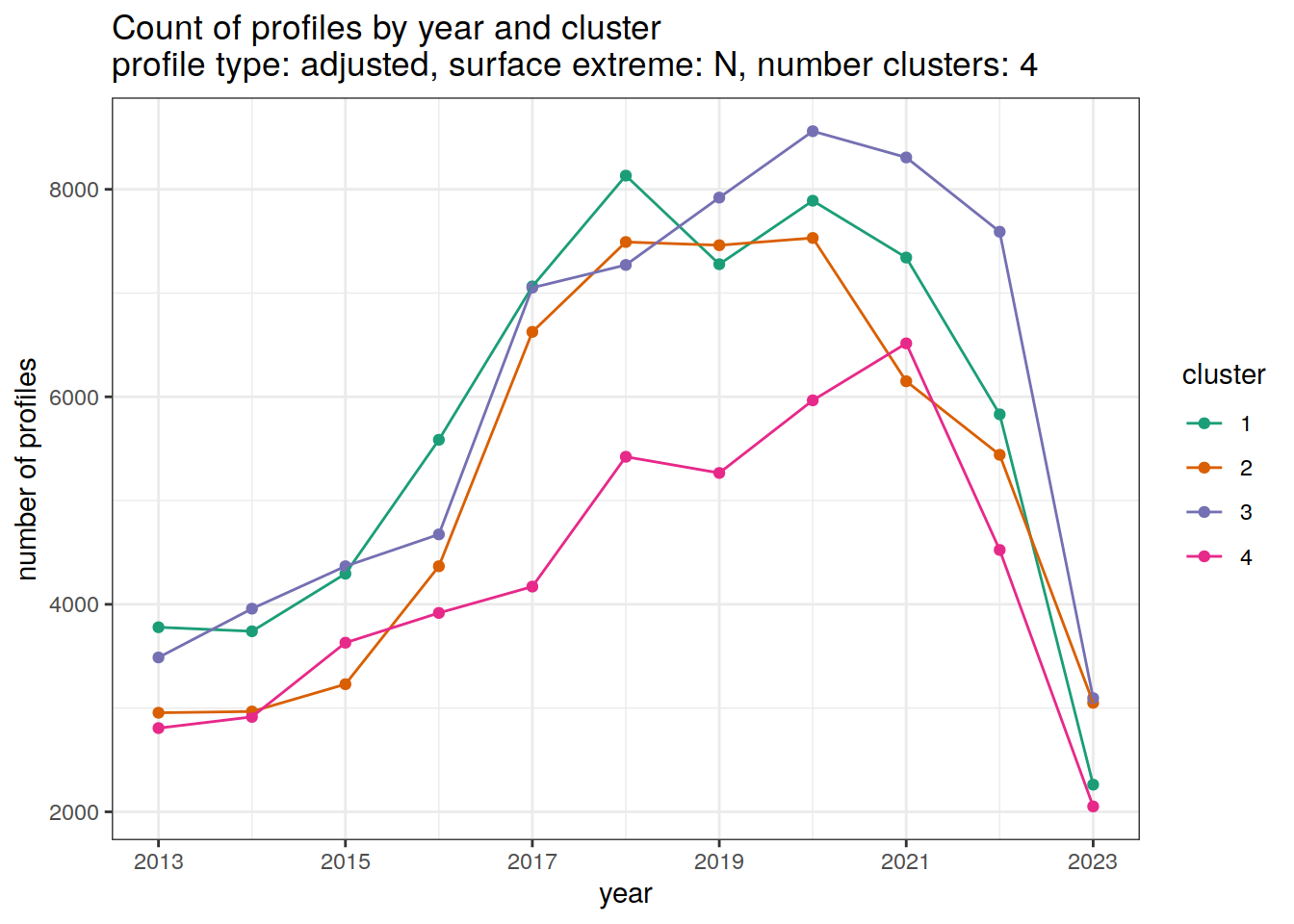
[[3]]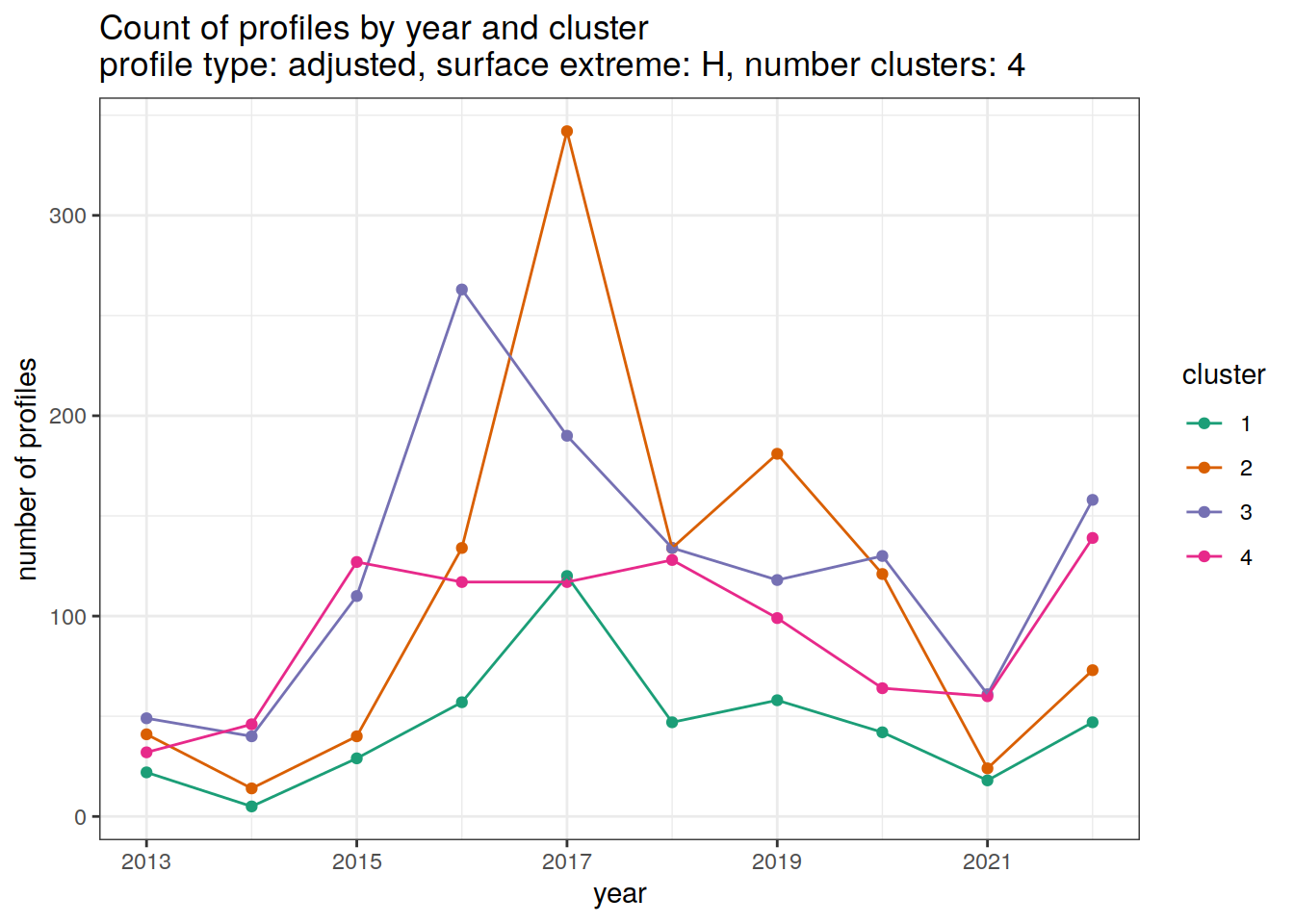
[[4]]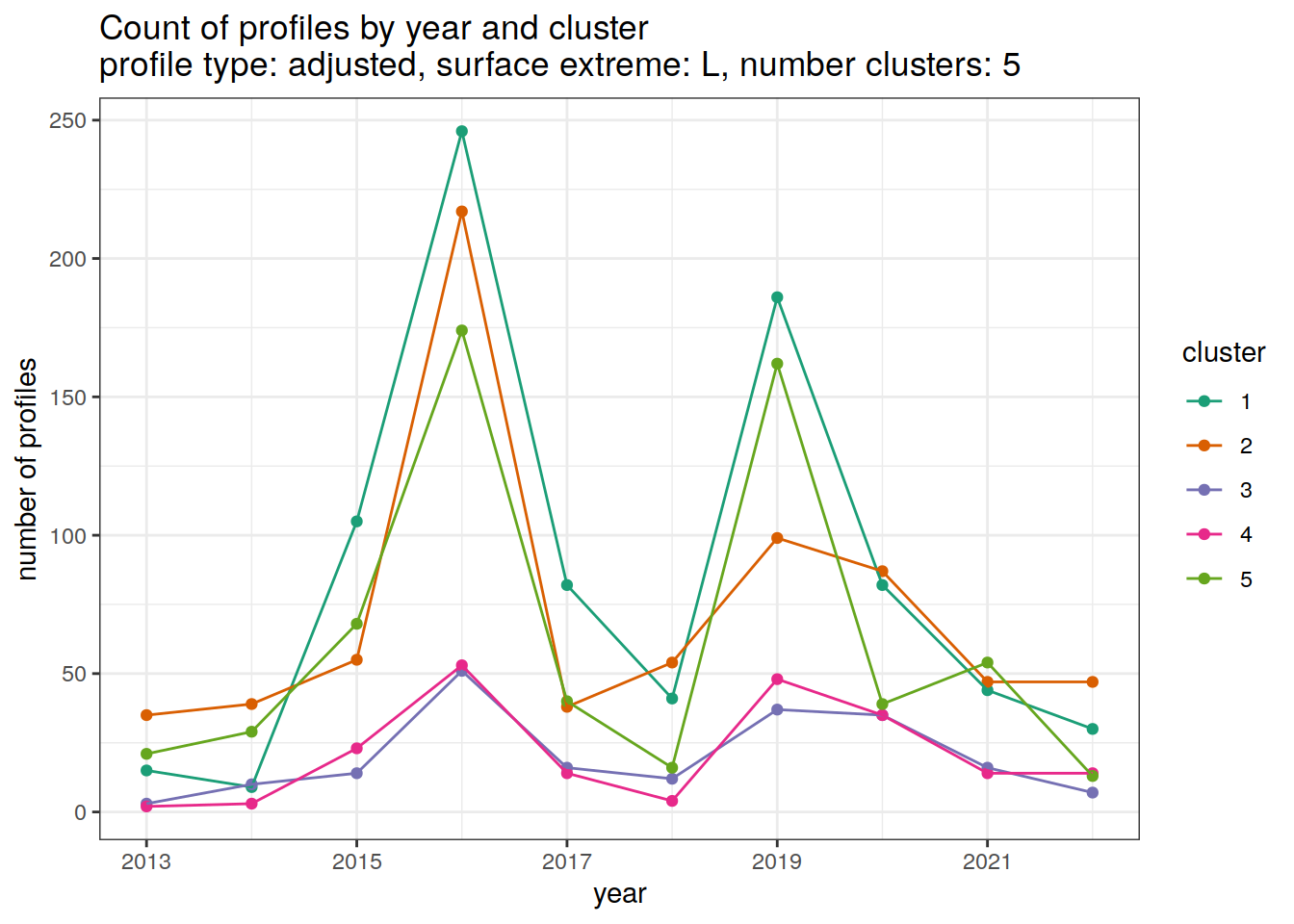
[[5]]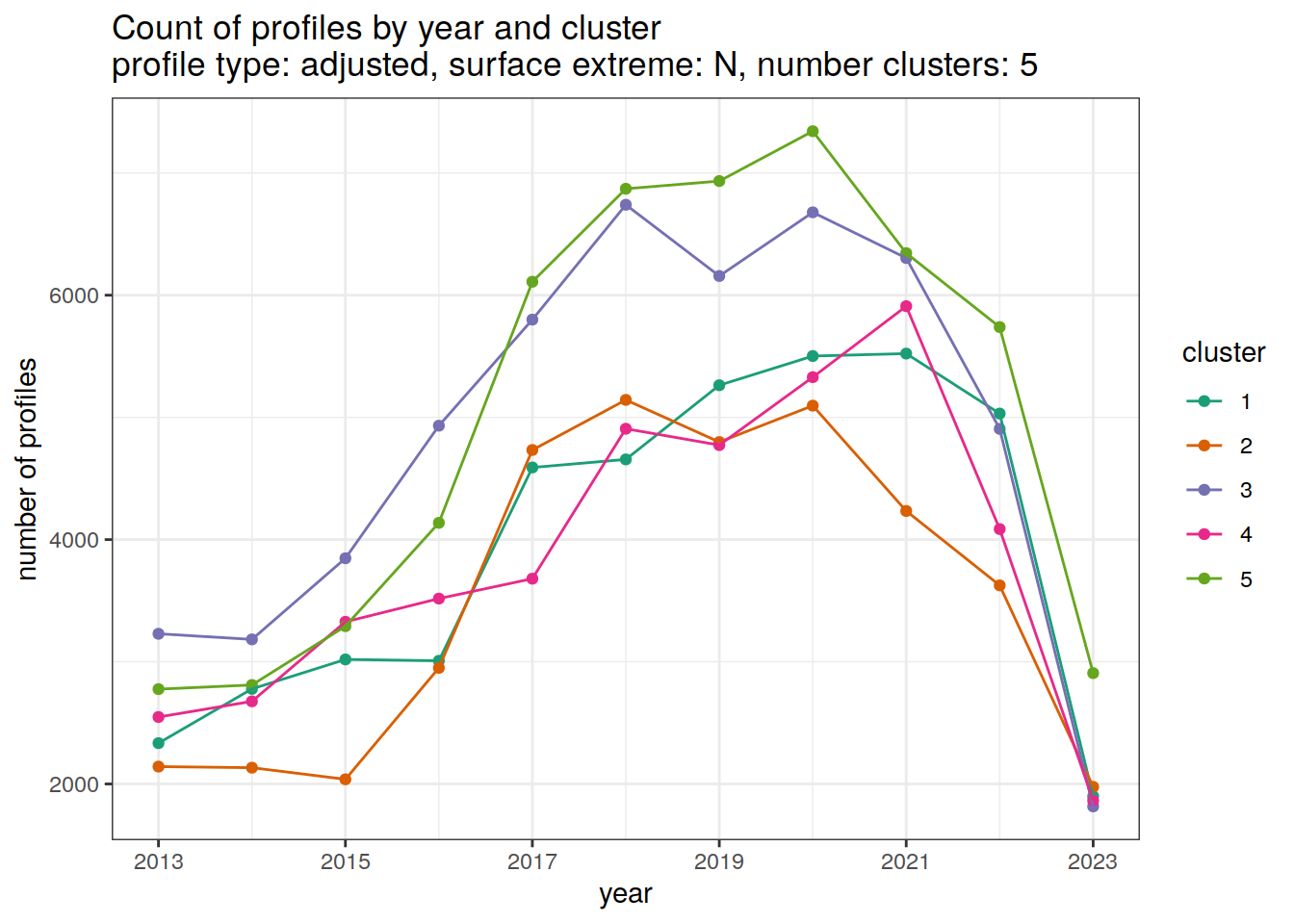
[[6]]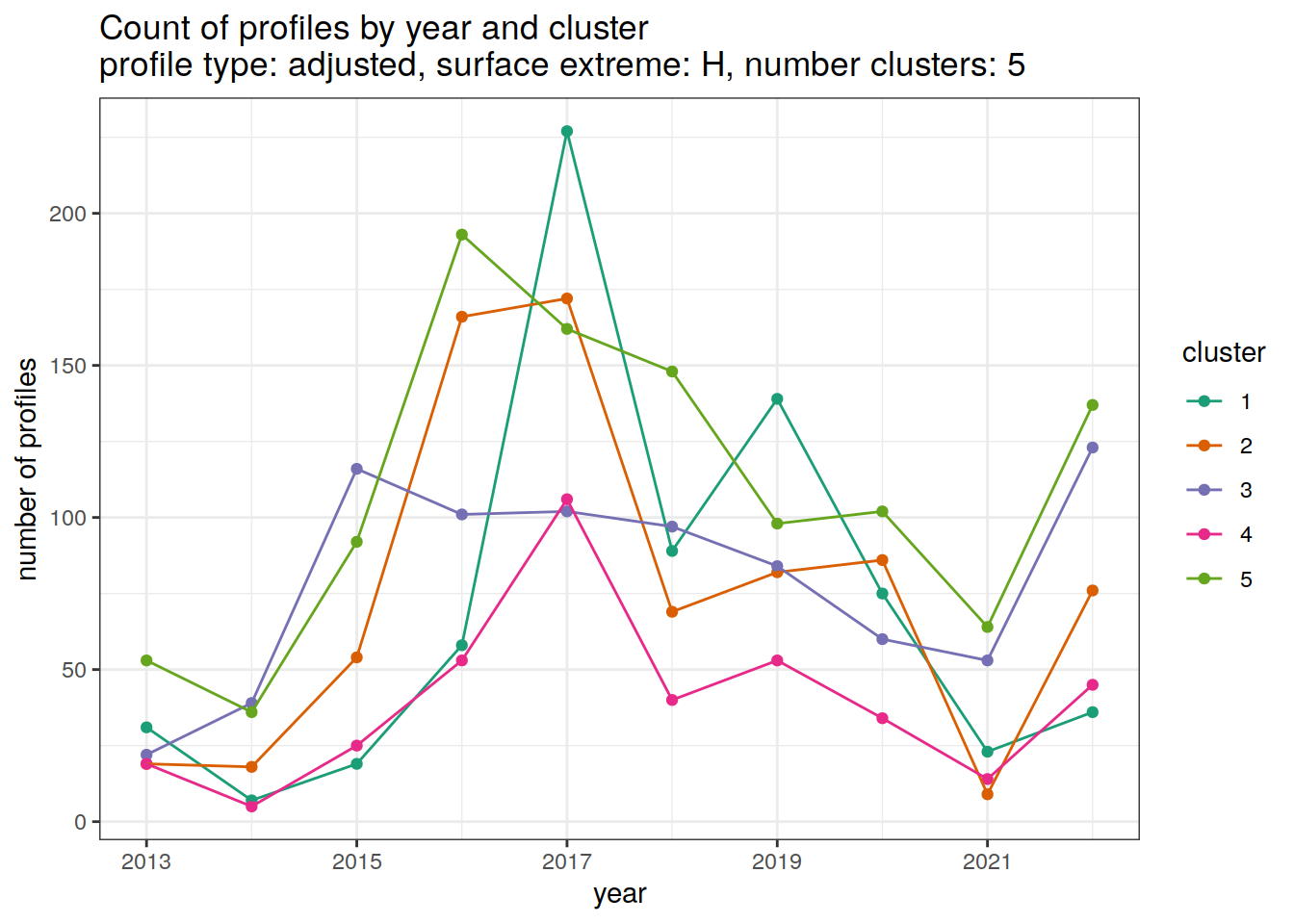
Cluster by month
count of each cluster by month of year
if (opt_extreme_analysis){
# Determine profile count by cluster and year
# Count the measurements
cluster_by_year <- anomaly_cluster_ext %>%
count(file_id, profile_type, num_clusters, extreme_order, extreme, cluster, month,
name = "count_cluster")
# Convert to profiles
cluster_by_year <- cluster_by_year %>%
count(profile_type, num_clusters, extreme_order, extreme, cluster, month,
name = "count_cluster")
# create figure
cluster_by_year %>%
filter (profile_type == "base") %>%
group_split(profile_type, num_clusters, extreme_order) %>%
map(
~ ggplot(
data = .x,
aes(
x = month,
y = count_cluster,
col = cluster,
group = cluster
)
) +
geom_point() +
geom_line() +
scale_x_continuous(breaks = seq(1, 12, 2)) +
scale_color_brewer(palette = 'Dark2') +
labs(
x = 'month',
y = 'number of profiles',
col = 'cluster',
title = paste0(
'Count of profiles by month and cluster \n',
'profile type: ', unique(.x$profile_type), ', ',
'surface extreme: ', unique(.x$extreme), ', ',
'number clusters: ', unique(.x$num_clusters)
)
)
)
}[[1]]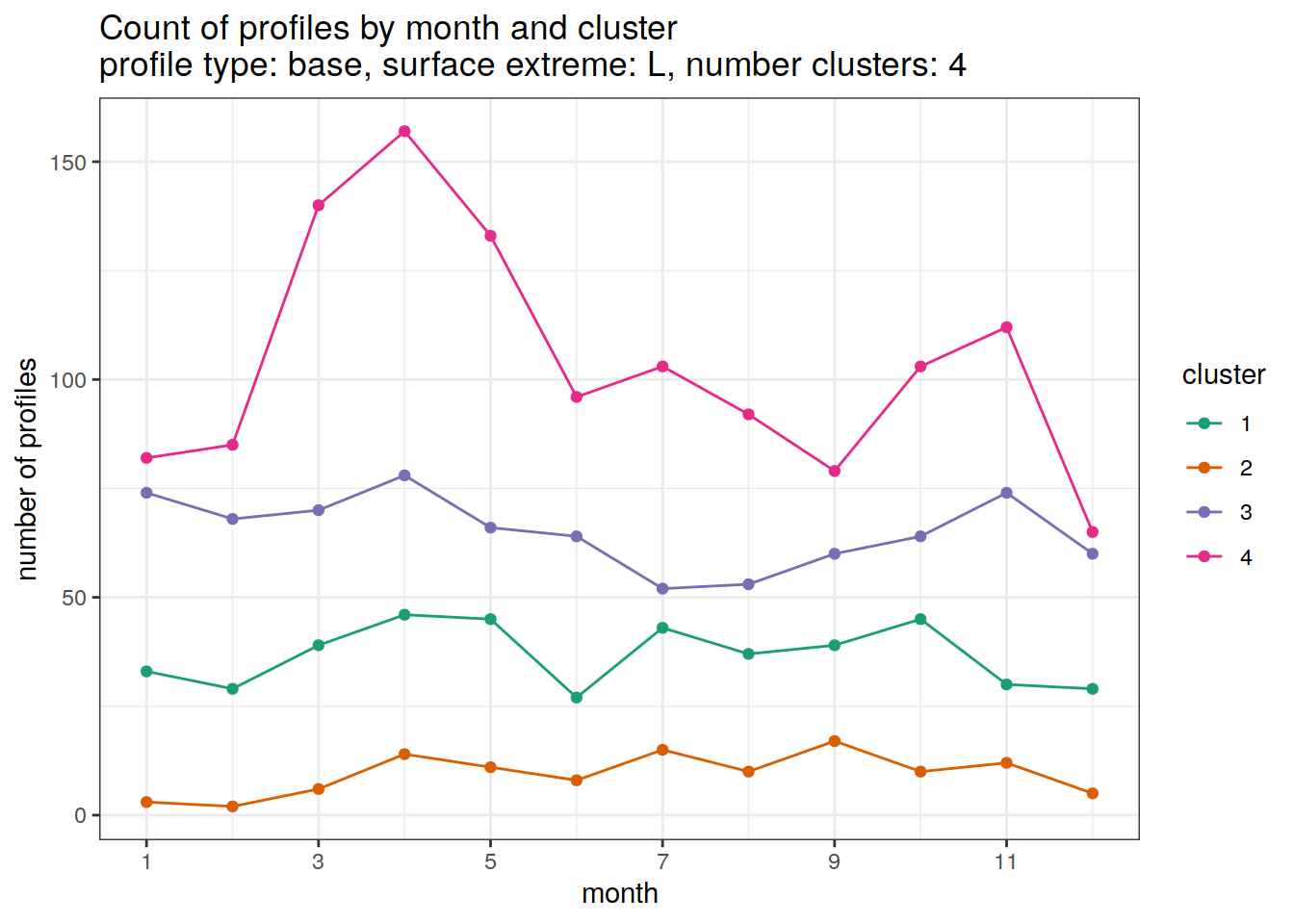
[[2]]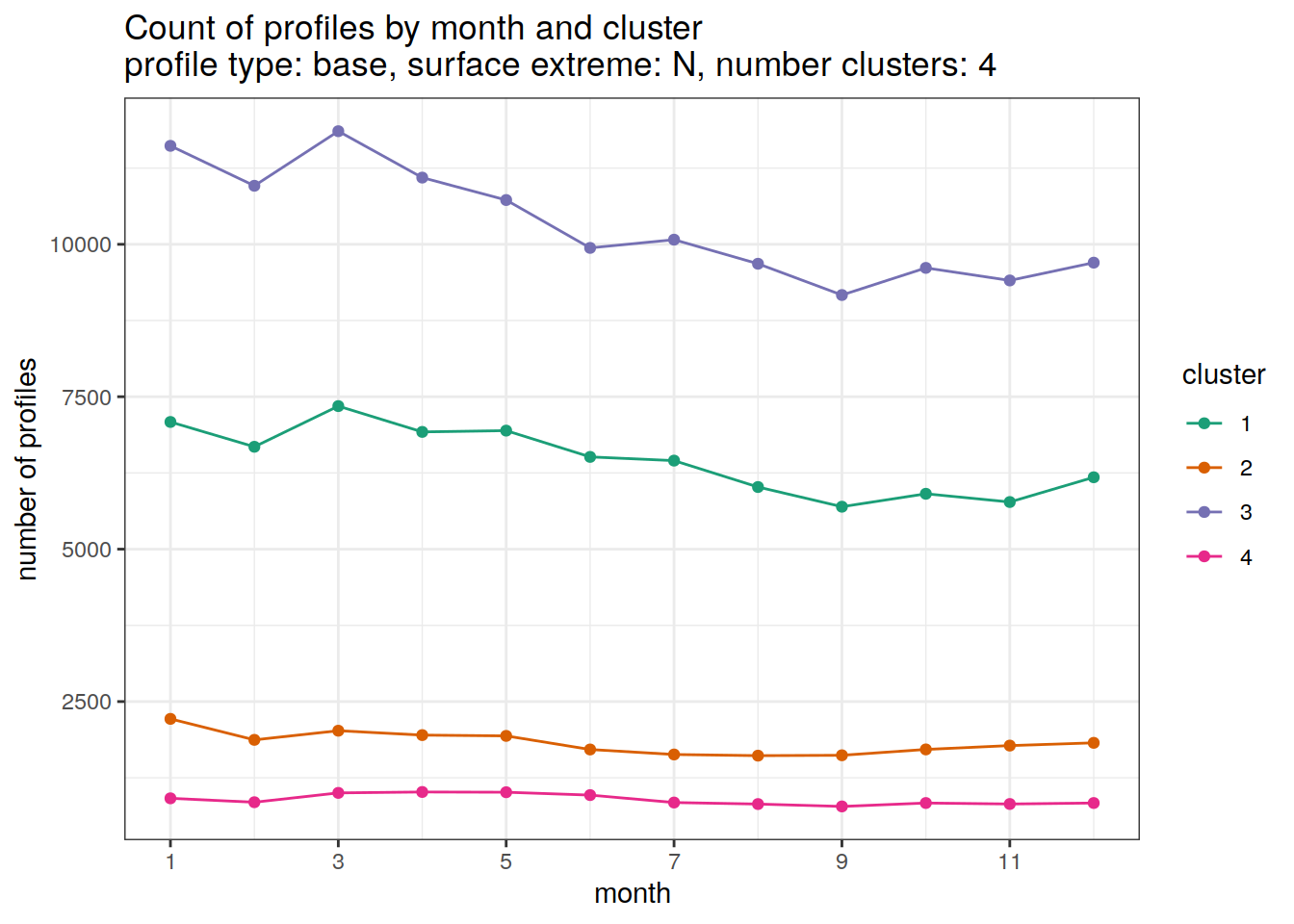
[[3]]
[[4]]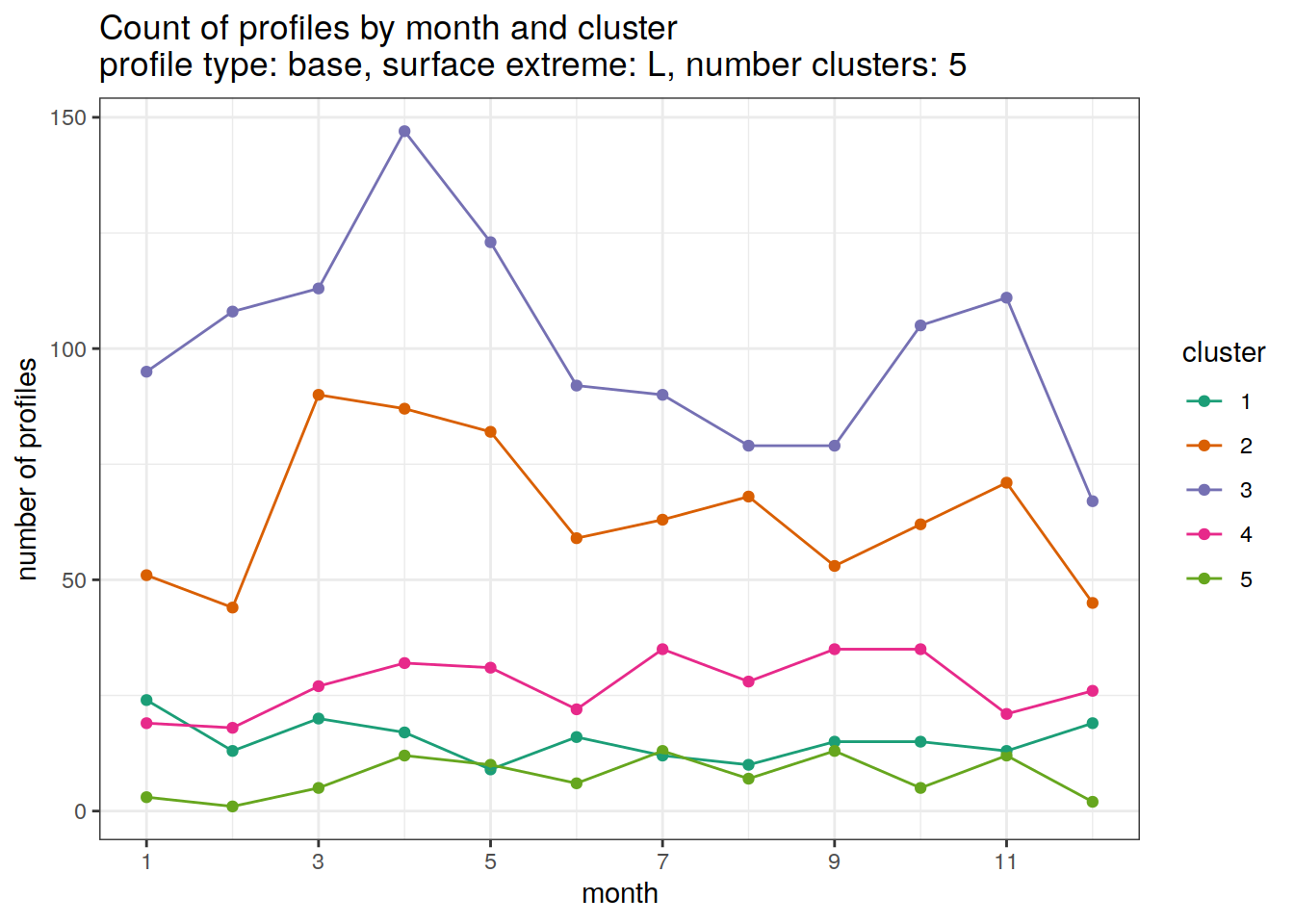
[[5]]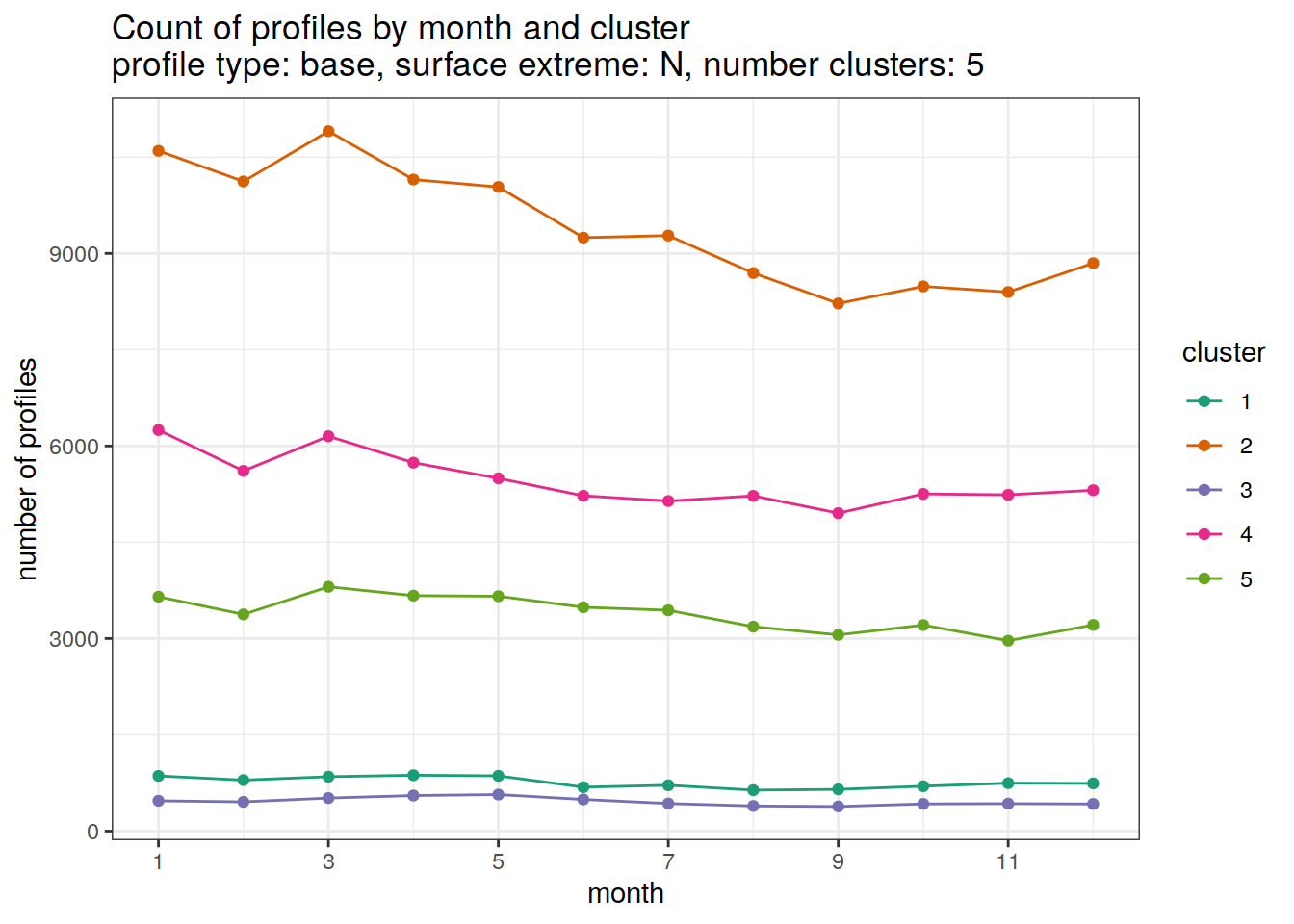
[[6]]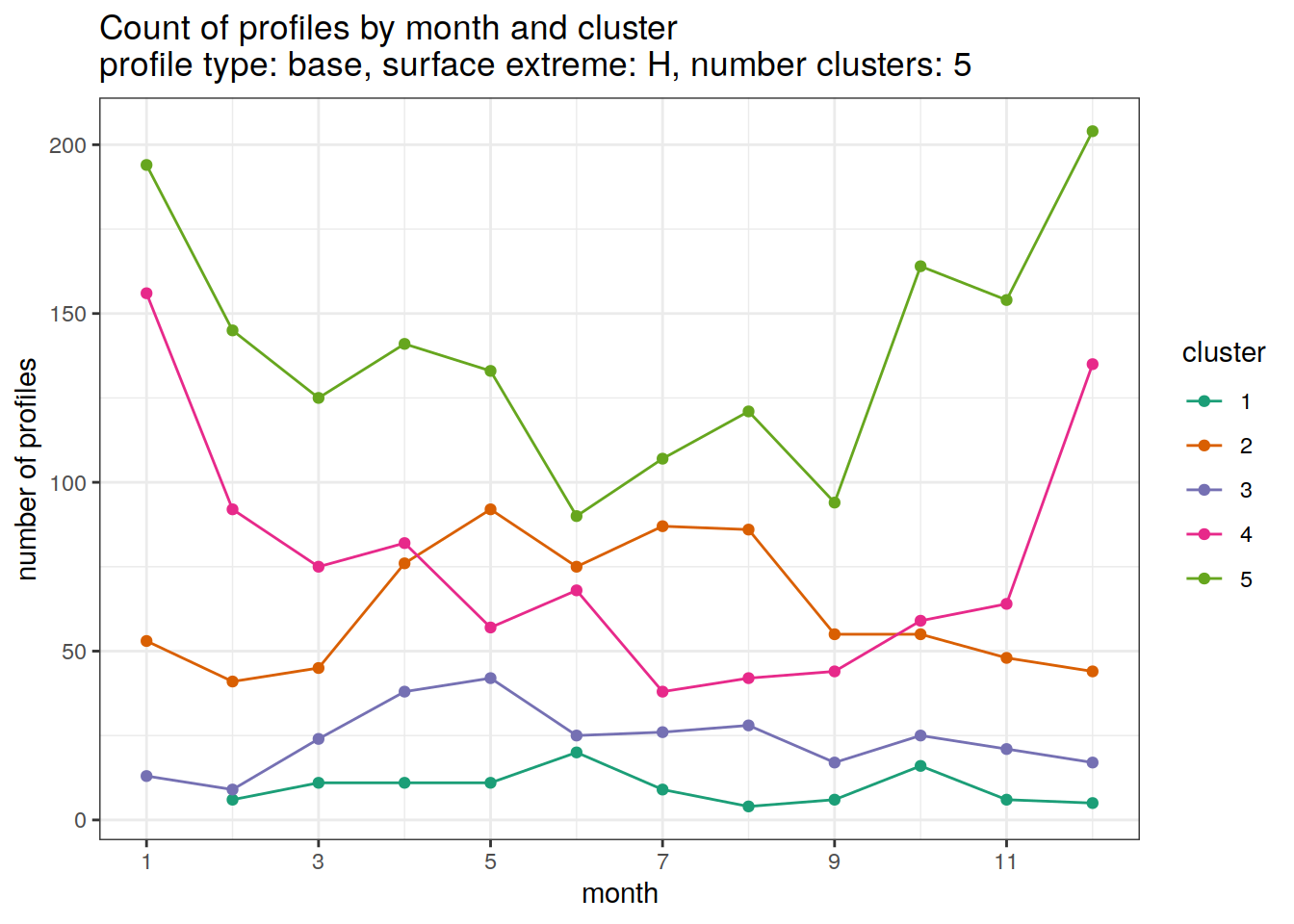
Adjusted profiles
if (opt_extreme_analysis){
if (opt_norm_anomaly) {
# create figure
cluster_by_year %>%
filter (profile_type == "adjusted") %>%
group_split(profile_type, num_clusters, extreme_order) %>%
map(
~ ggplot(
data = .x,
aes(
x = month,
y = count_cluster,
col = cluster,
group = cluster
)
) +
geom_point() +
geom_line() +
scale_x_continuous(breaks = seq(1, 12, 2)) +
scale_color_brewer(palette = 'Dark2') +
labs(
x = 'month',
y = 'number of profiles',
col = 'cluster',
title = paste0(
'Count of profiles by month and cluster \n',
'profile type: ', unique(.x$profile_type), ', ',
'surface extreme: ', unique(.x$extreme), ', ',
'number clusters: ', unique(.x$num_clusters)
)
)
)
}
}[[1]]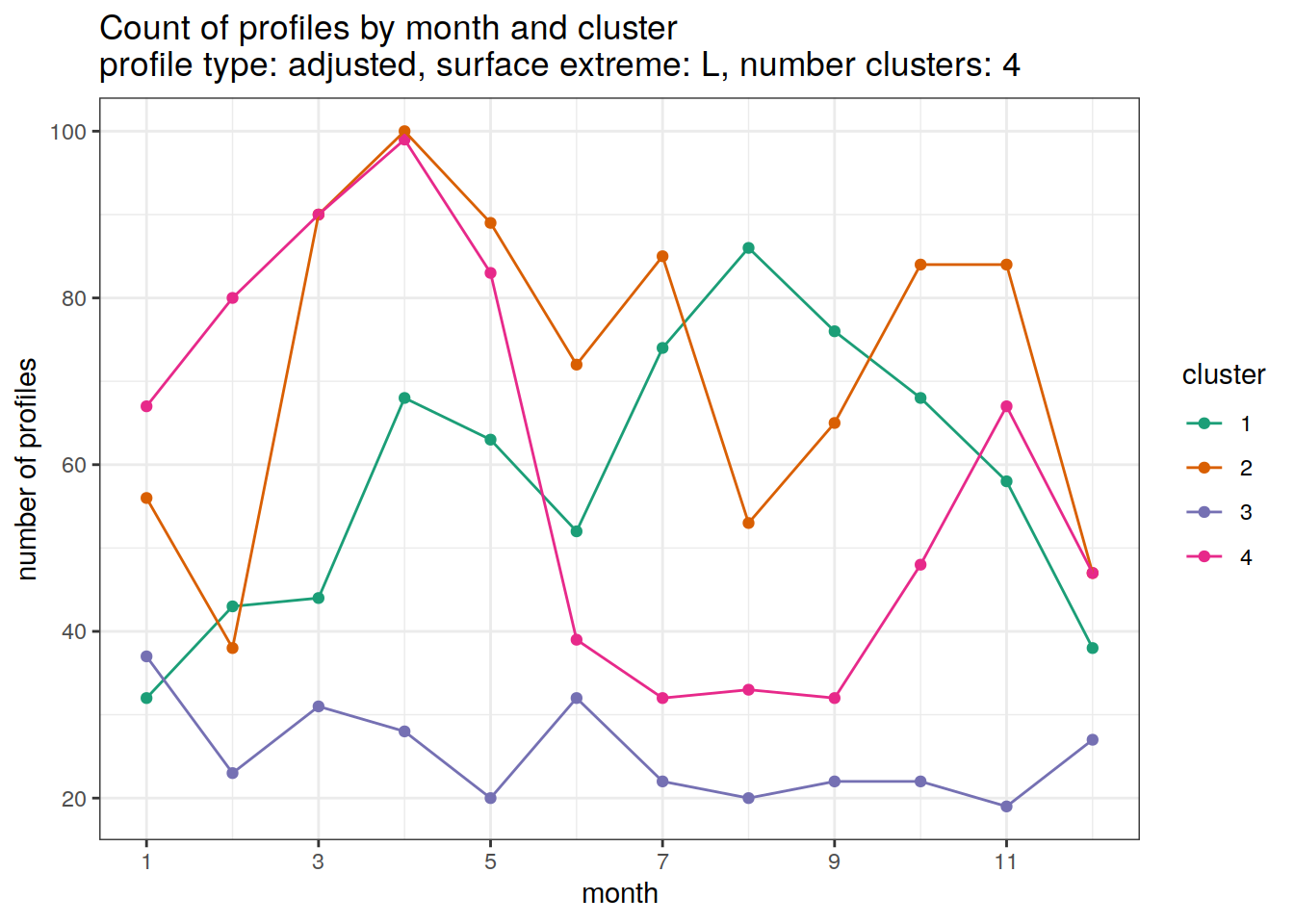
[[2]]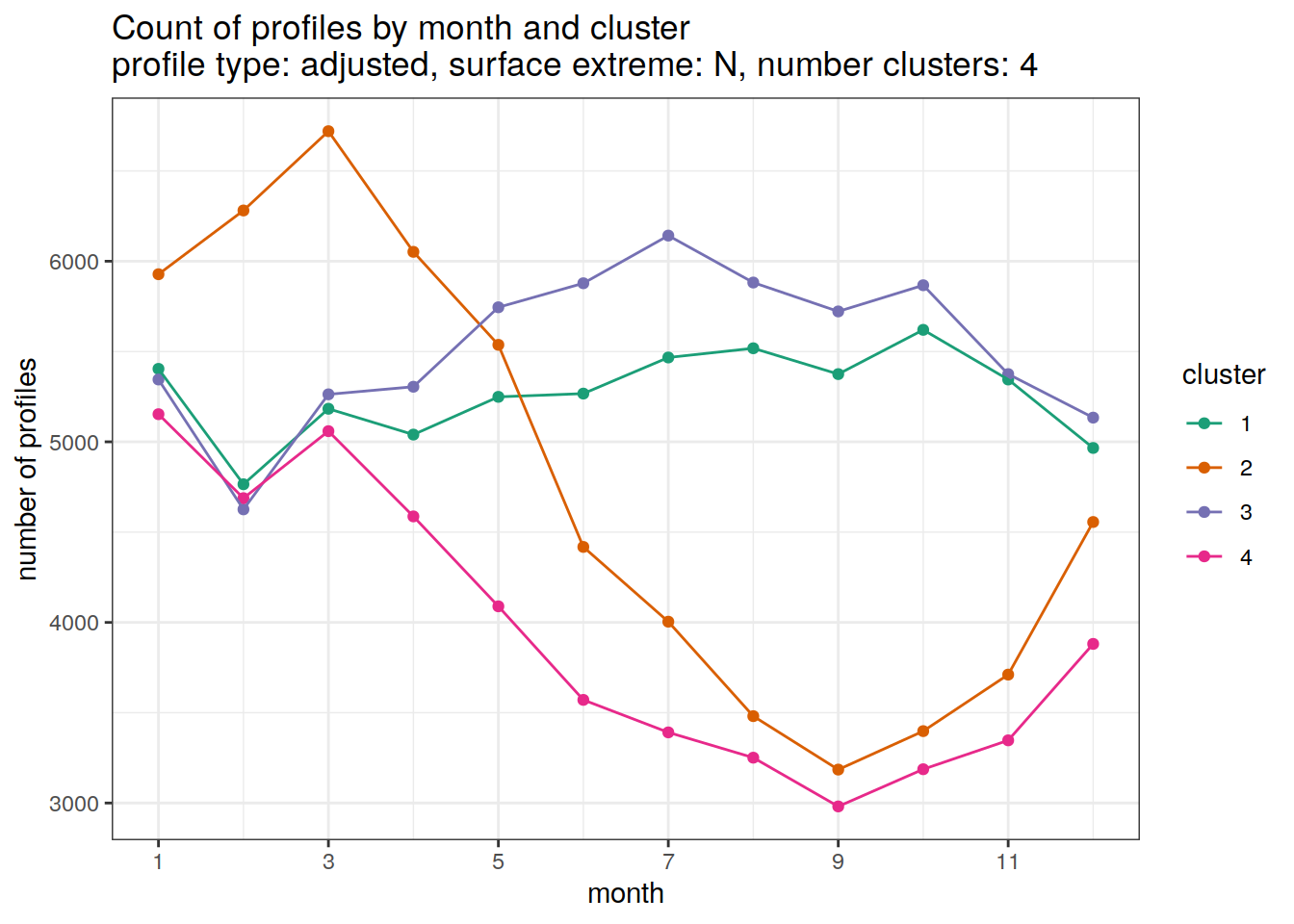
[[3]]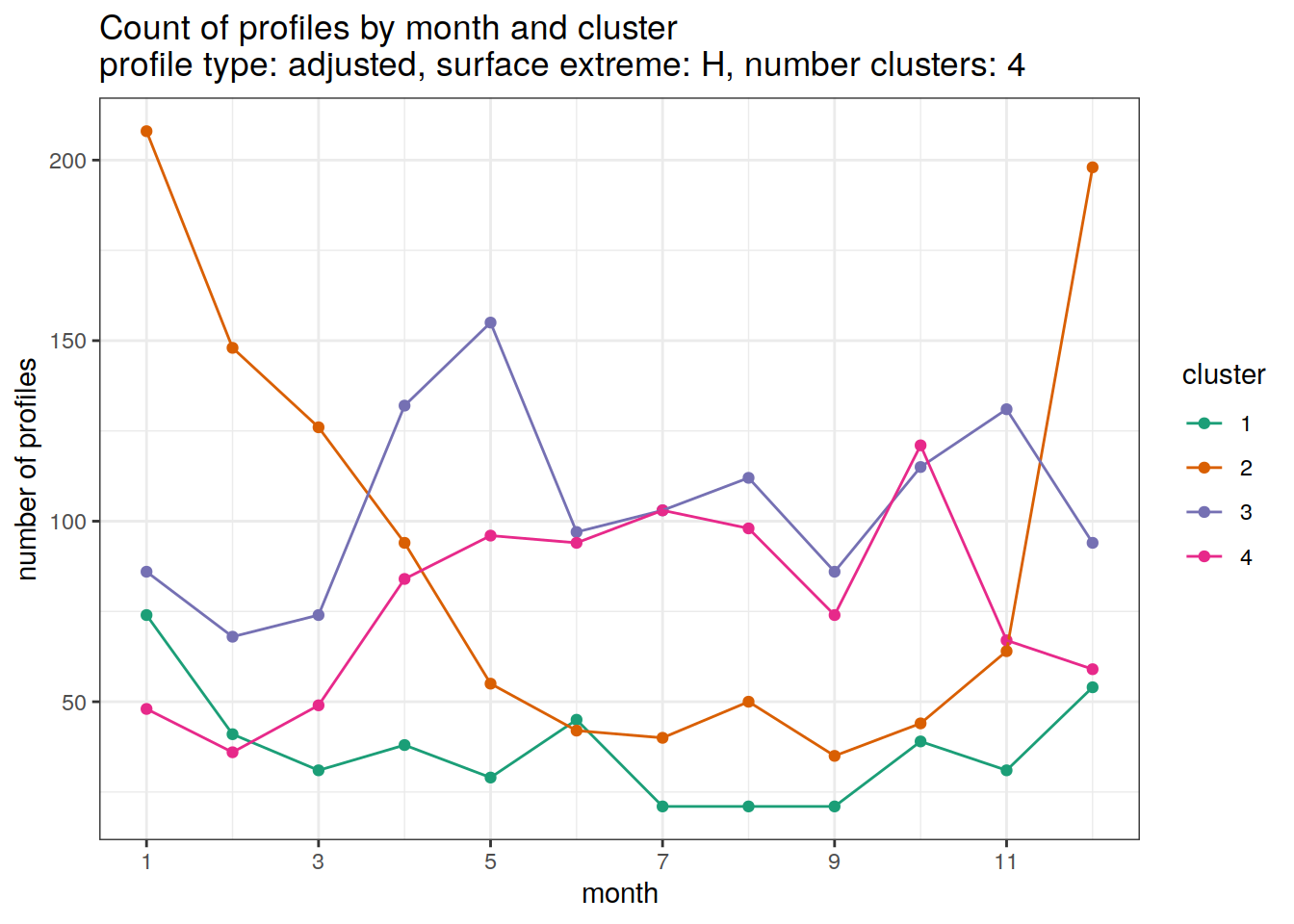
[[4]]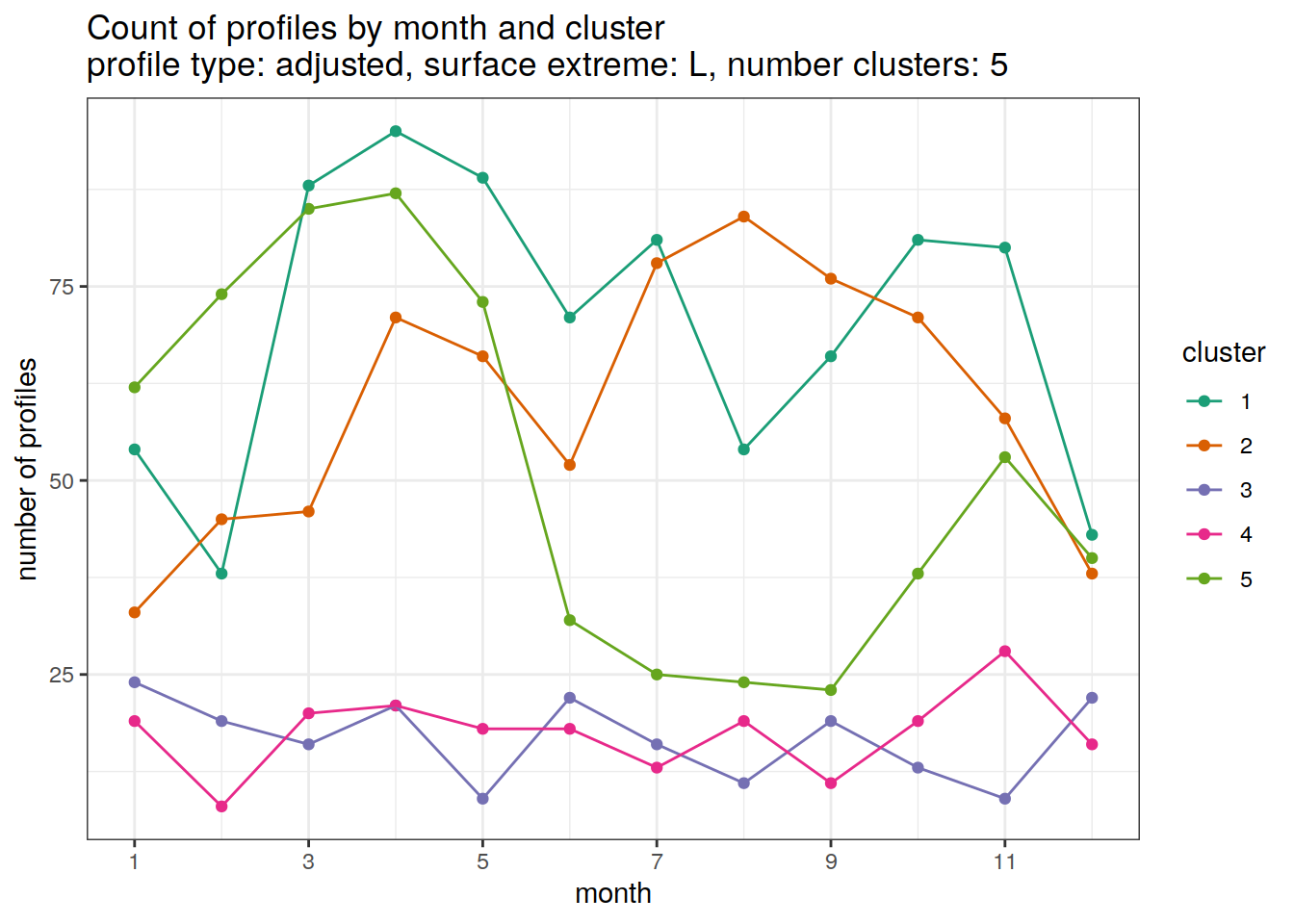
[[5]]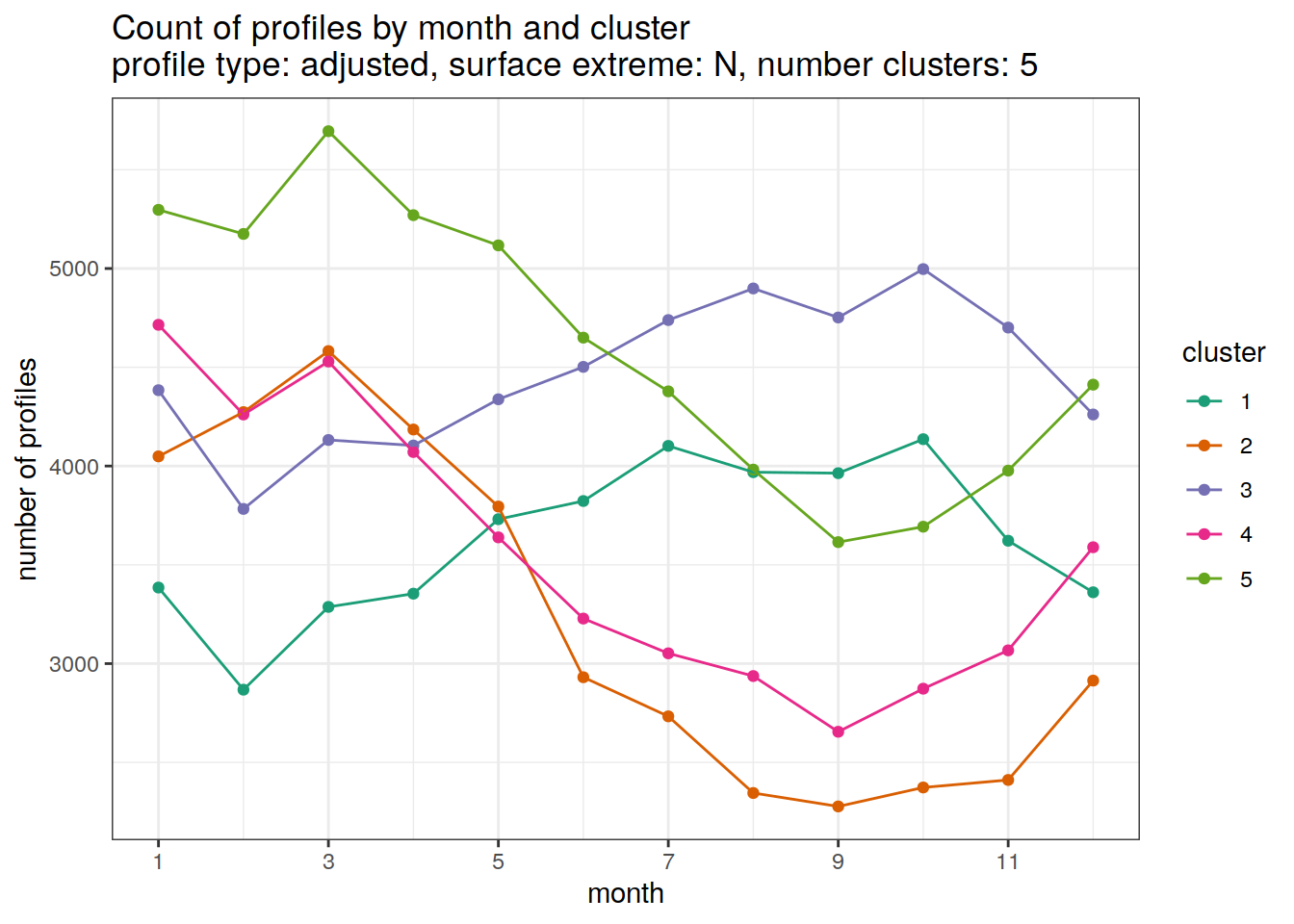
[[6]]
Cluster spatial
location of each cluster on map, spatial analysis
if (opt_extreme_analysis){
# create figure combined
anomaly_cluster_ext %>%
filter (profile_type == "base") %>%
group_split(profile_type, num_clusters, extreme_order) %>%
map(
~ map +
geom_tile(data = .x,
aes(
x = lon,
y = lat,
fill = cluster
)) +
lims(y = opt_map_lat_limit) +
scale_fill_brewer(palette = 'Dark2') +
labs(
title = paste0(
'cluster spatial distribution \n',
'profile type: ', unique(.x$profile_type), ', ',
'surface extreme: ', unique(.x$extreme), ', ',
'number clusters: ', unique(.x$num_clusters)
)
)
)
}[[1]]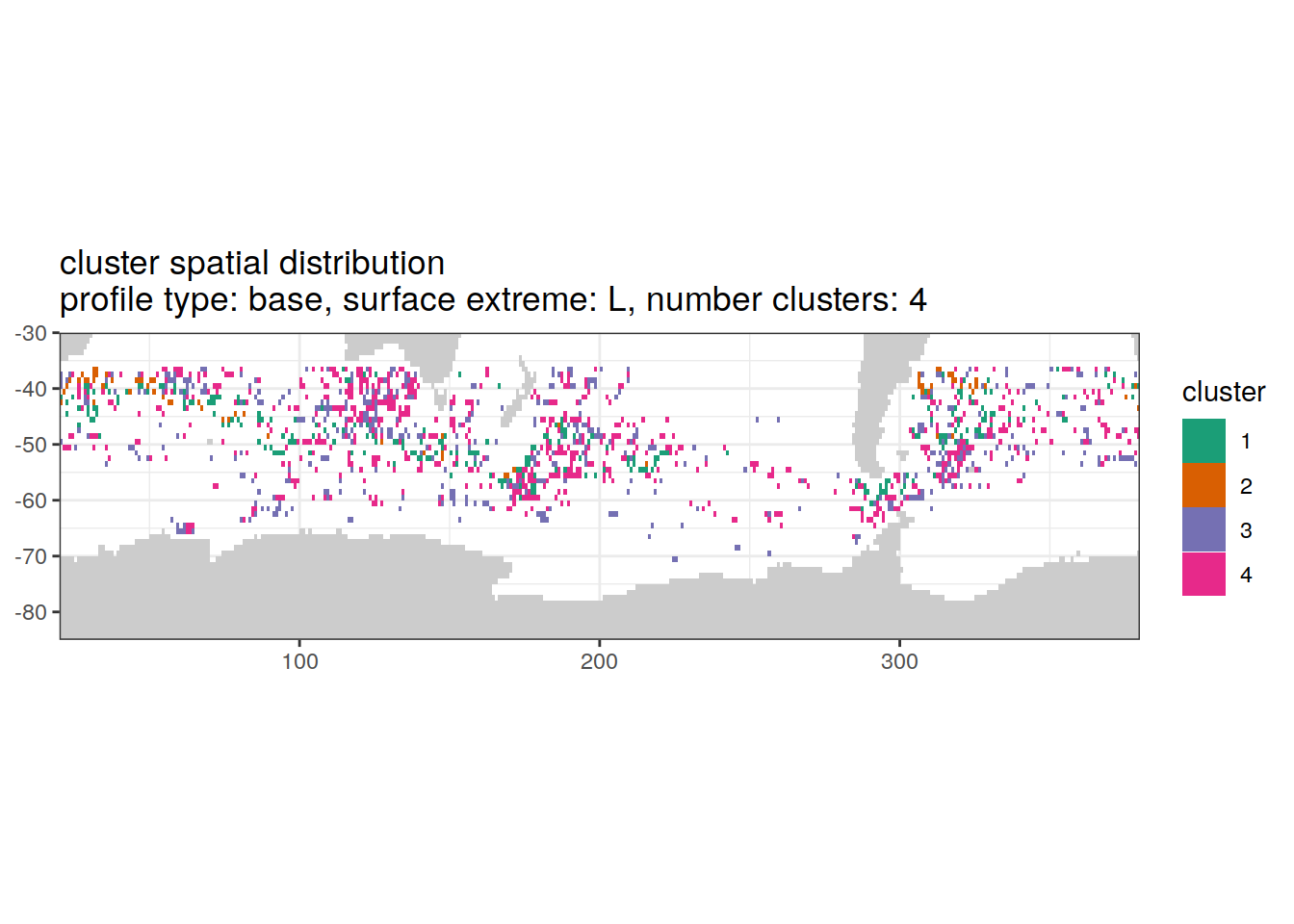
[[2]]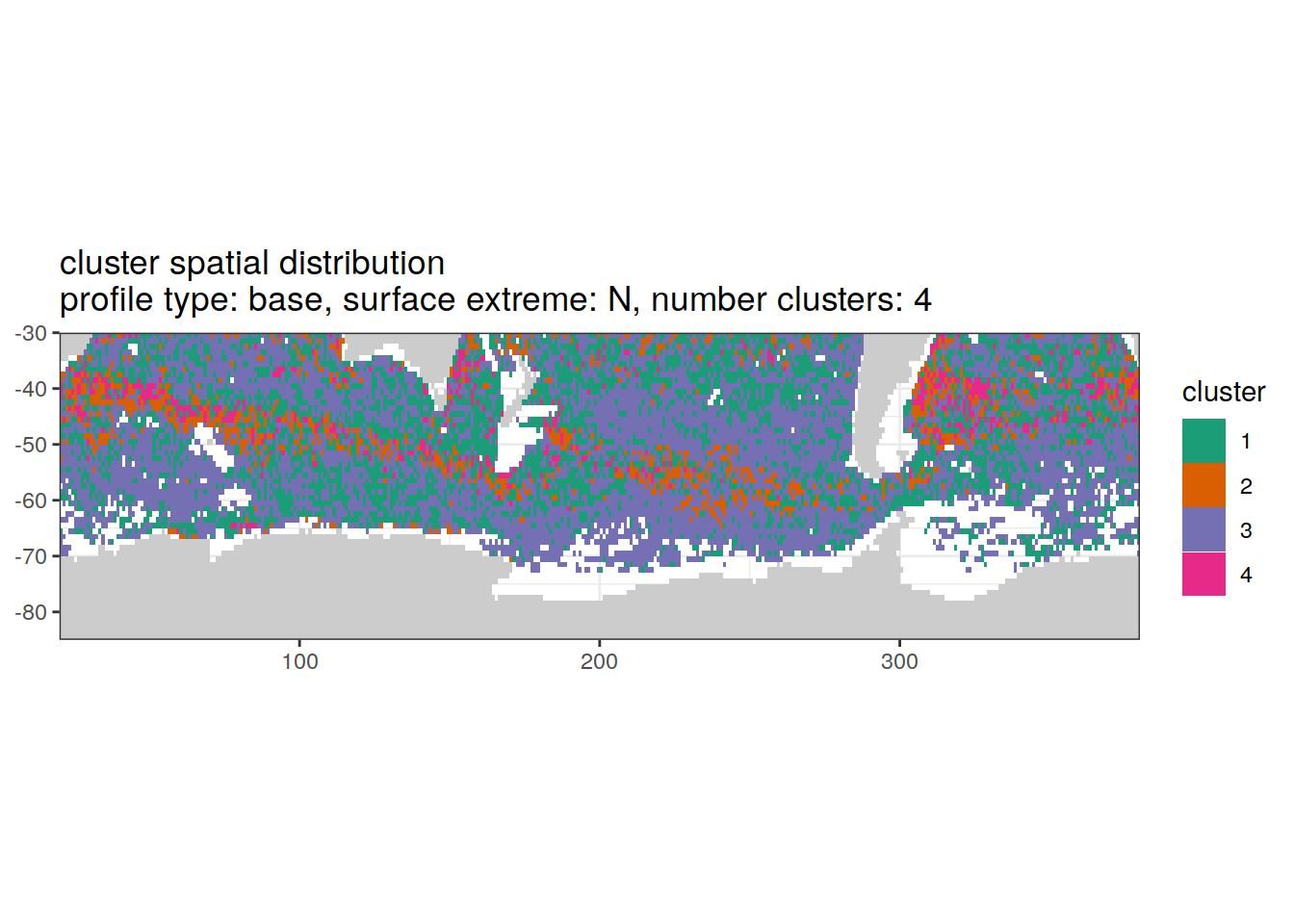
[[3]]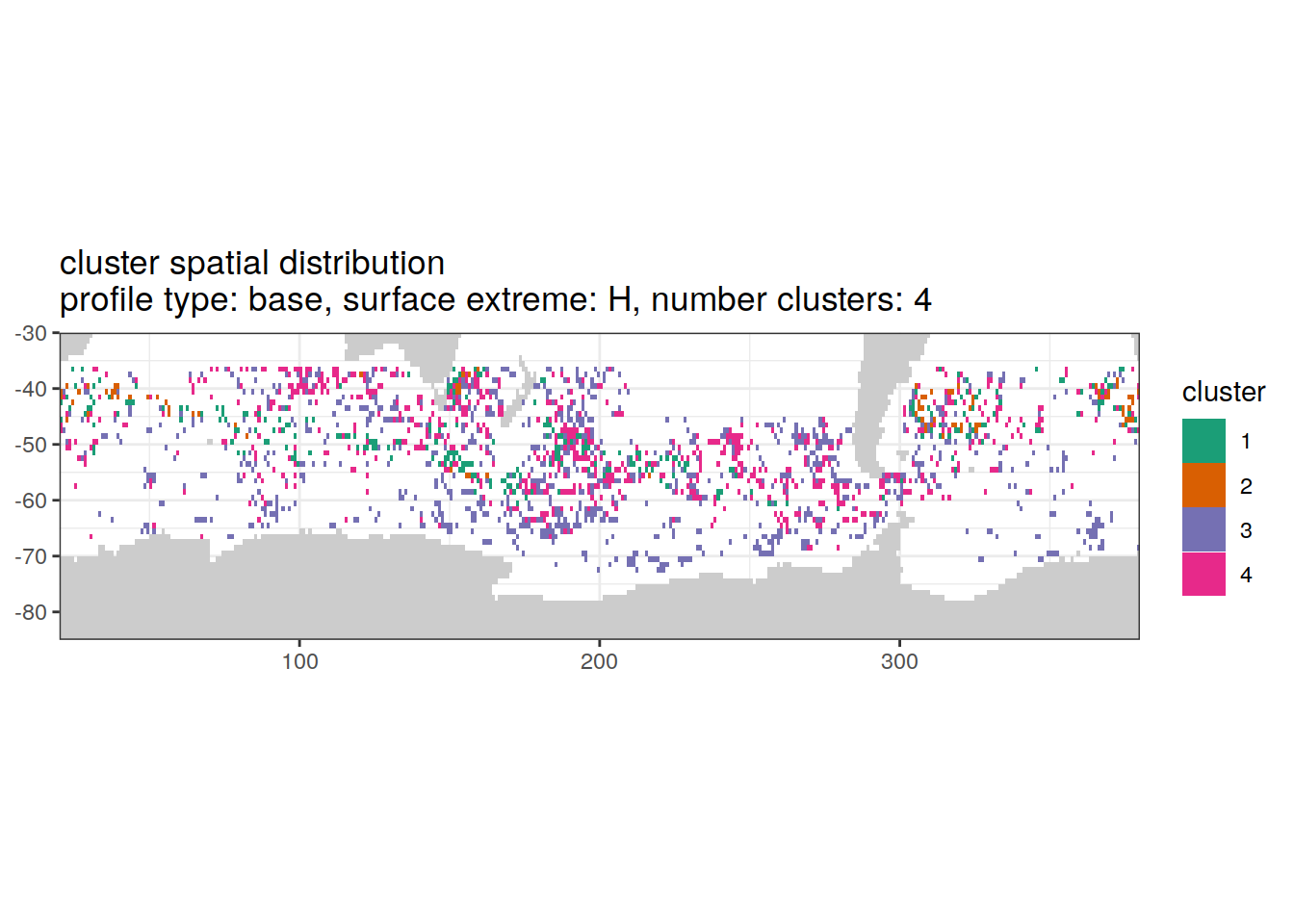
[[4]]
[[5]]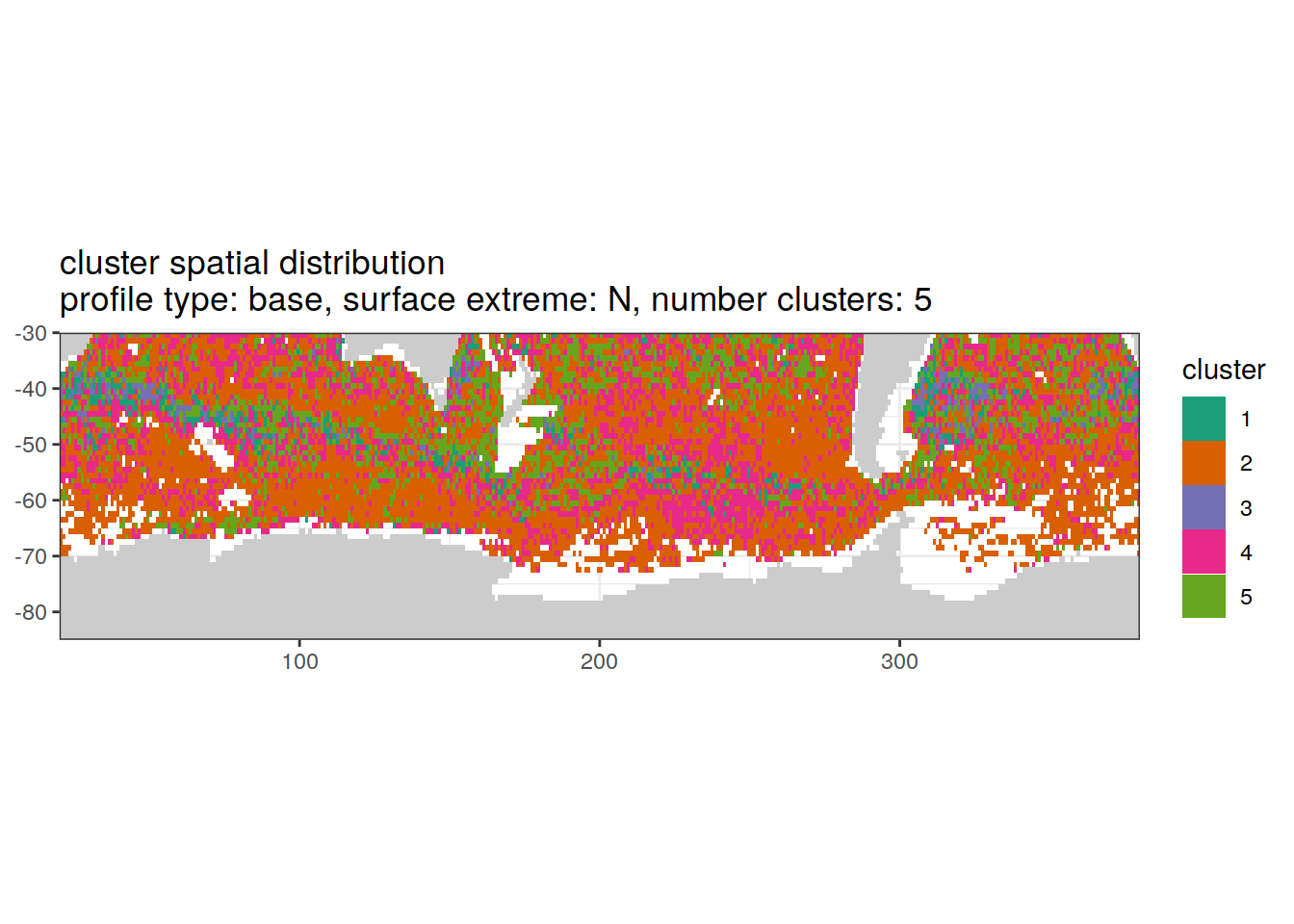
[[6]]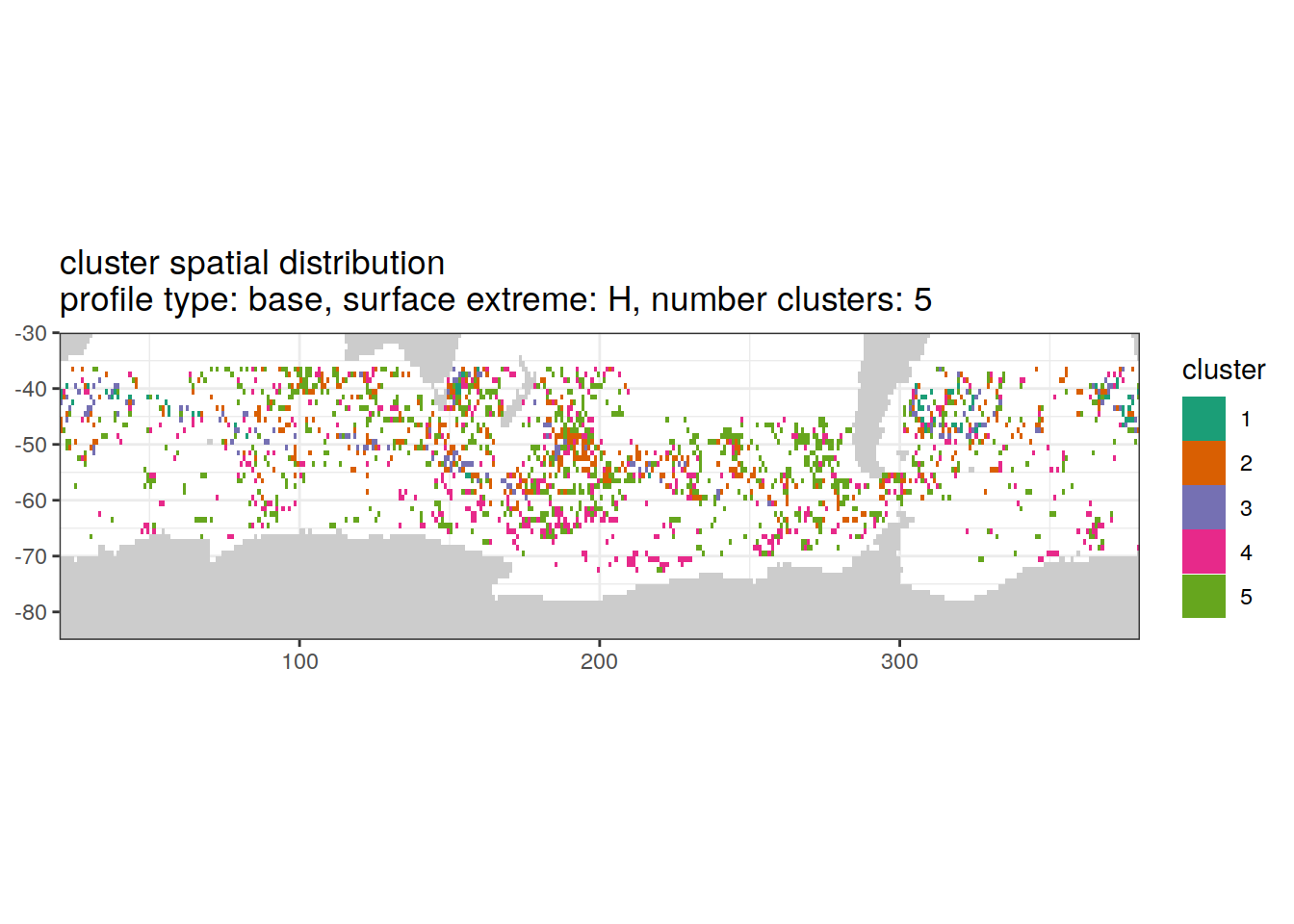
Adjusted profiles
if (opt_extreme_analysis){
if (opt_norm_anomaly) {
# create figure combined
anomaly_cluster_ext %>%
filter (profile_type == "adjusted") %>%
group_split(profile_type, num_clusters, extreme_order) %>%
map(
~ map +
geom_tile(data = .x,
aes(
x = lon,
y = lat,
fill = cluster
)) +
lims(y = opt_map_lat_limit) +
scale_fill_brewer(palette = 'Dark2') +
labs(
title = paste0(
'cluster spatial distribution \n',
'profile type: ', unique(.x$profile_type), ', ',
'surface extreme: ', unique(.x$extreme), ', ',
'number clusters: ', unique(.x$num_clusters)
)
)
)
}
}[[1]]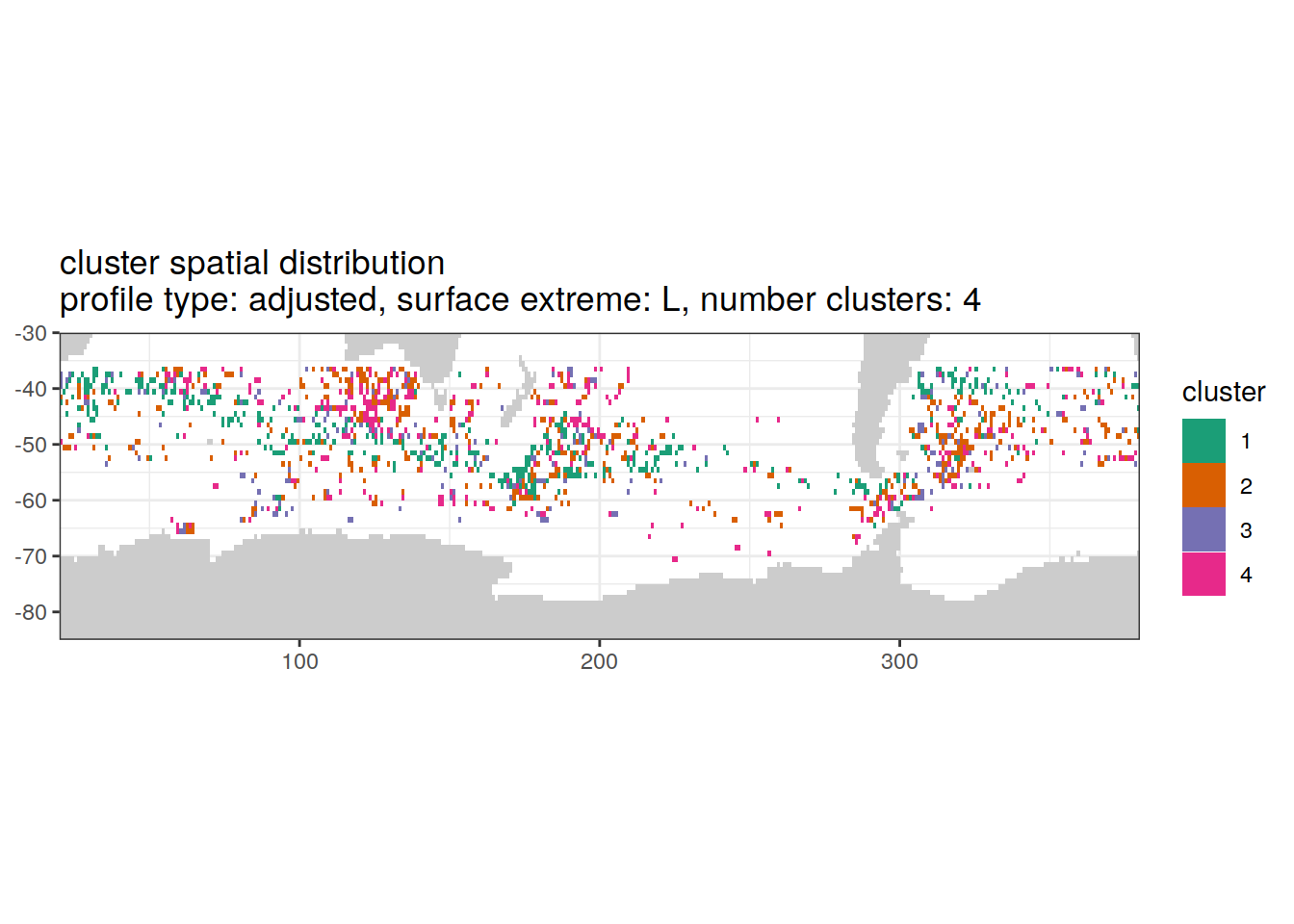
[[2]]
[[3]]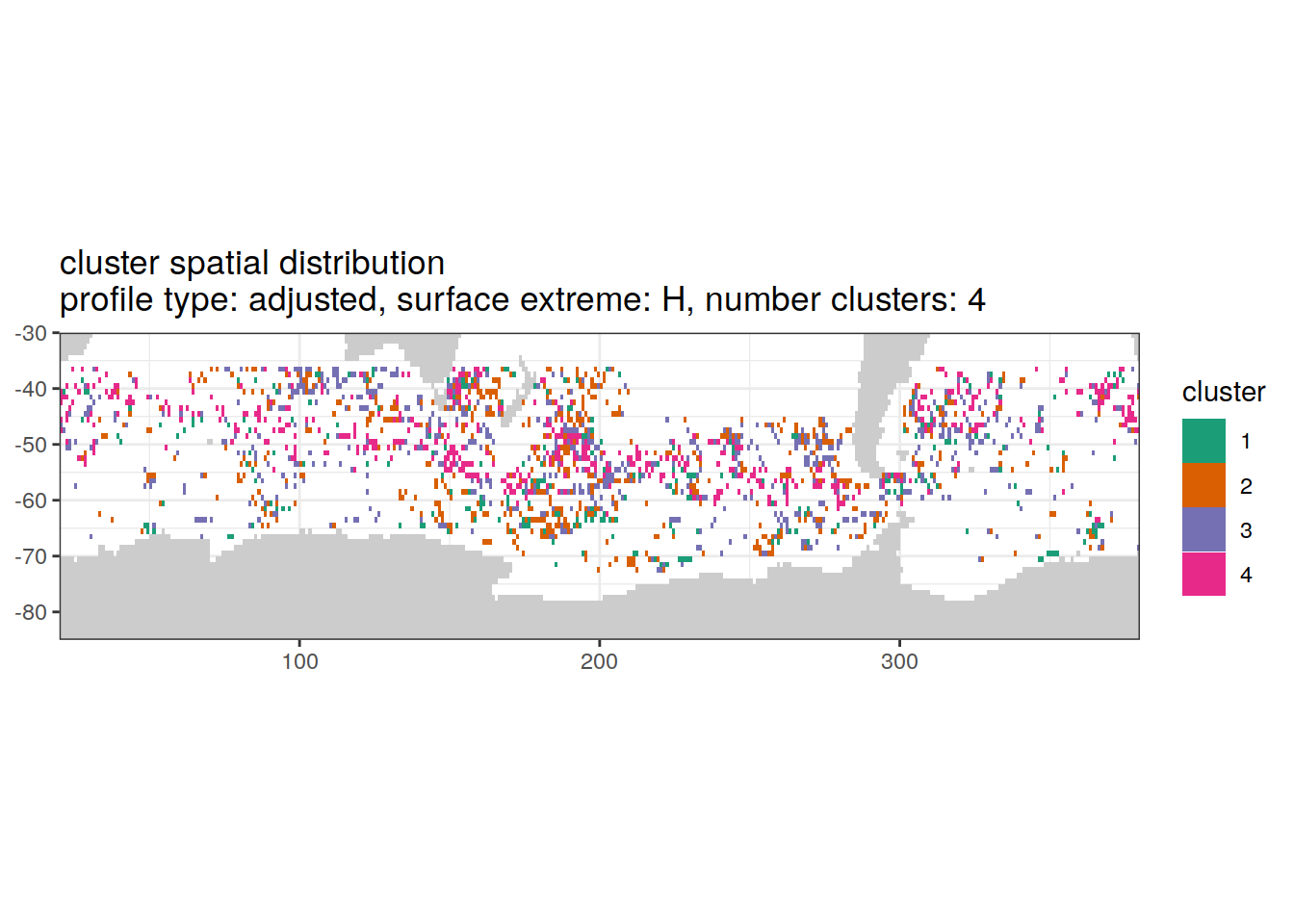
[[4]]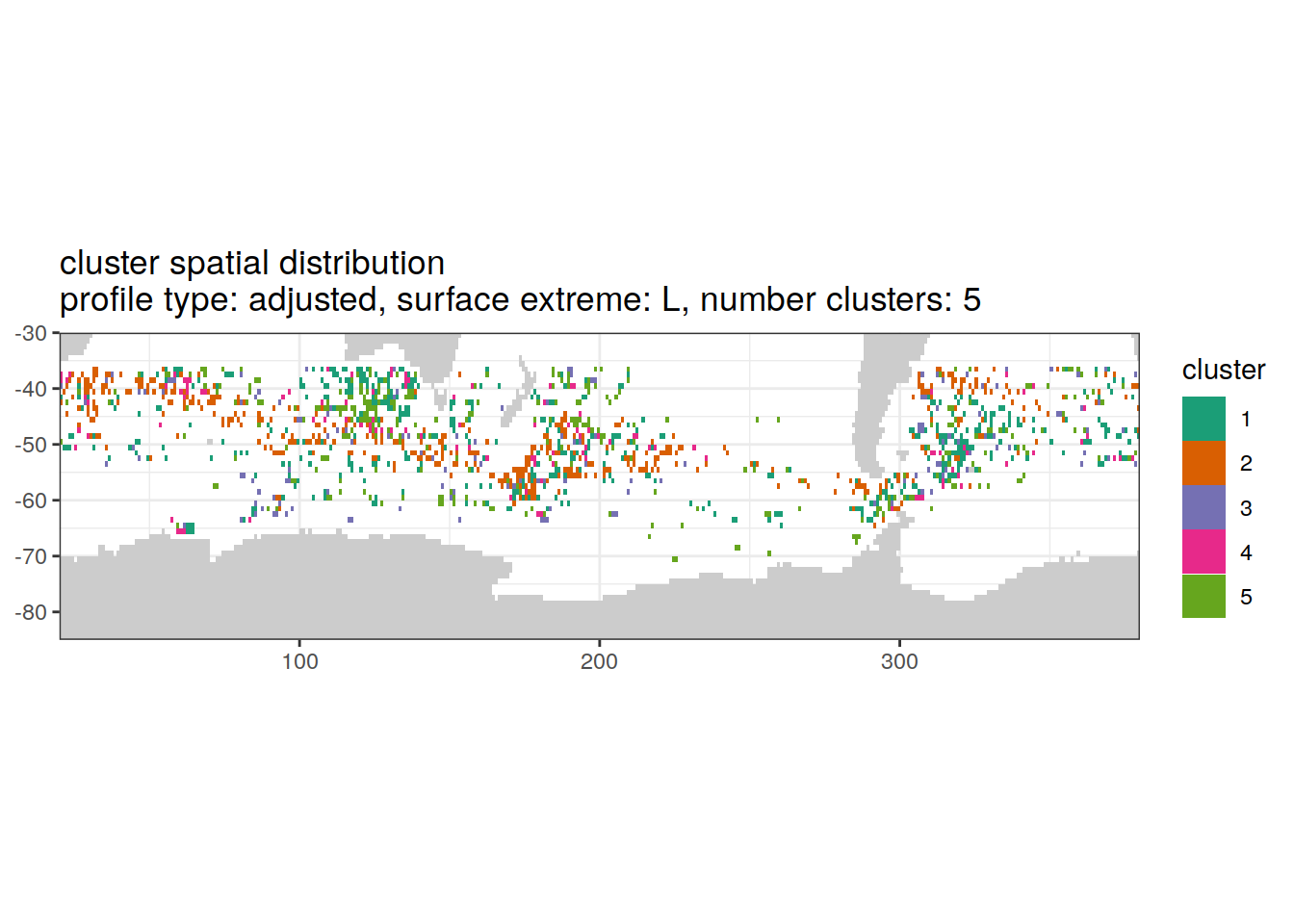
[[5]]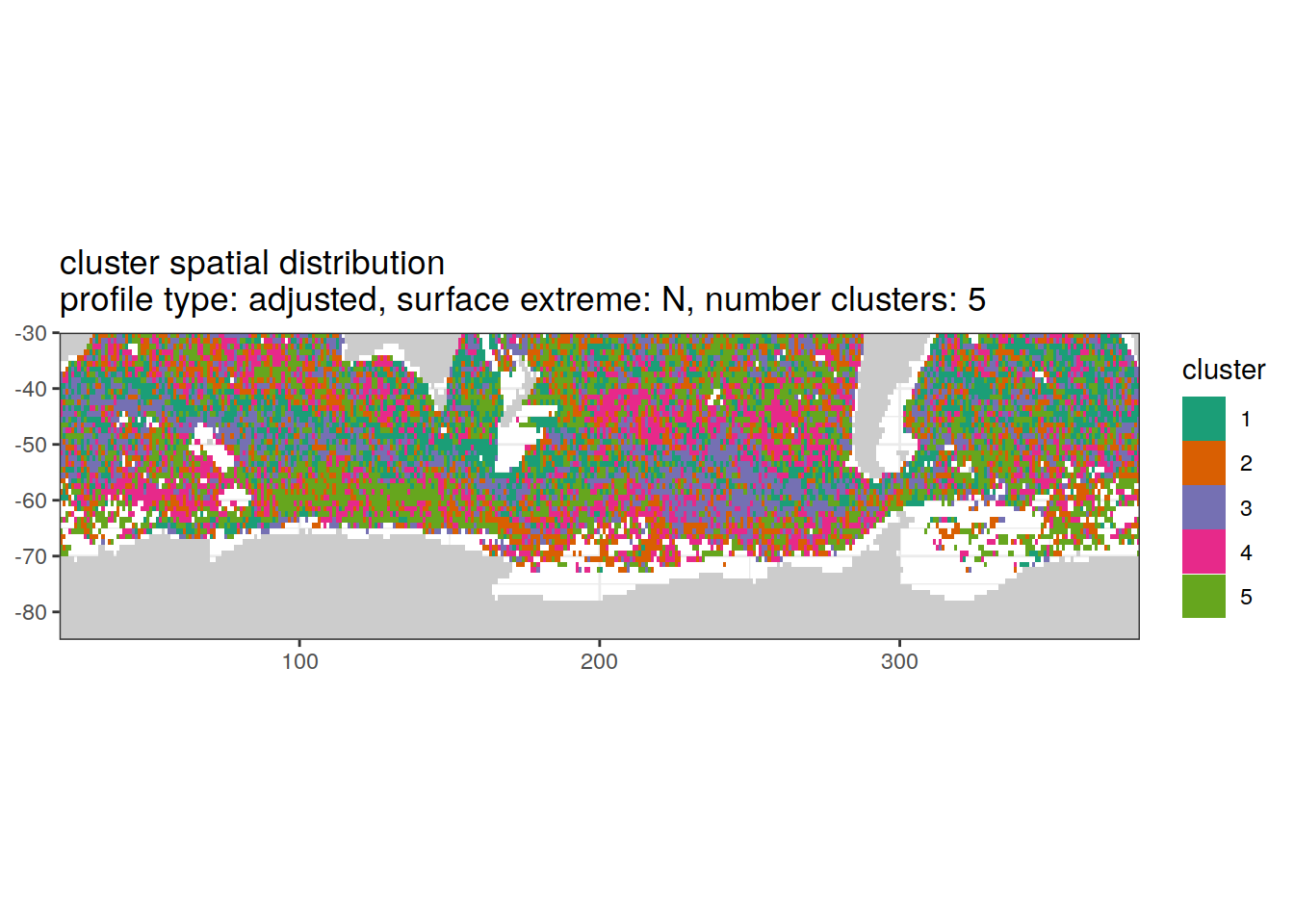
[[6]]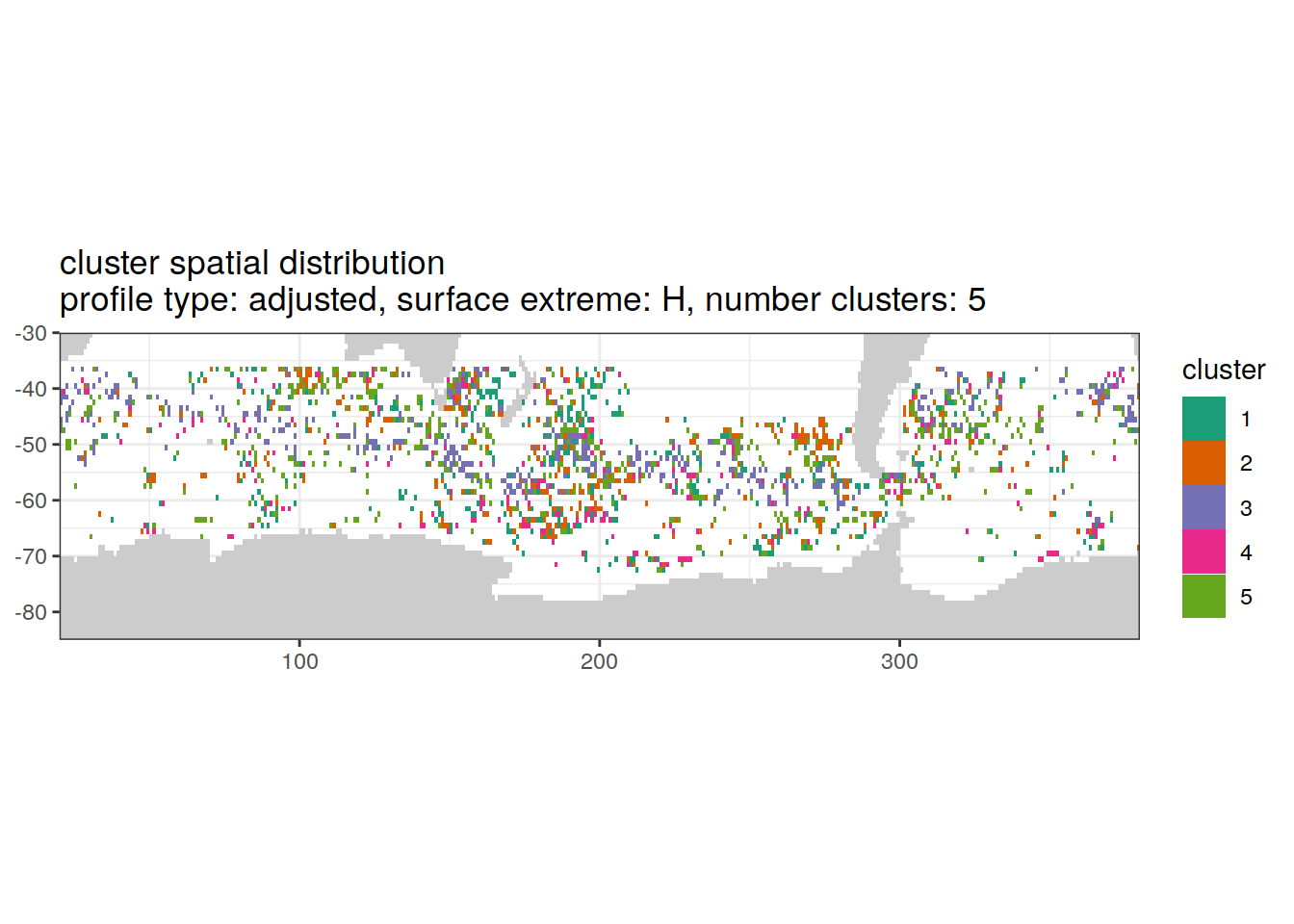
Cluster spatial counts
location of each cluster on map, spatial analysis
if (opt_extreme_analysis){
# Count profiles
cluster_by_location <- anomaly_cluster_ext %>%
count(profile_type, num_clusters, extreme_order, extreme, file_id, lat, lon, cluster,
name = "count_cluster")
# # Add cluster counts to
cluster_by_location <- left_join(cluster_by_location, cluster_count)
# create figure
cluster_by_location %>%
filter (profile_type == "base") %>%
group_split(profile_type, num_clusters, extreme_order) %>%
map(
~ map +
geom_tile(data = .x %>%
count(lat, lon, cluster, count_profiles),
aes(
x = lon,
y = lat,
fill = n
)) +
lims(y = opt_map_lat_limit) +
scale_fill_gradient(low = "blue",
high = "red",
trans = "log10") +
facet_wrap(~ paste0(cluster, " (", formatC(count_profiles, big.mark=",") , ")"), ncol = 2) +
labs(
title = paste0(
'cluster spatial distribution \n',
'profile type: ', unique(.x$profile_type), ', ',
'surface extreme: ', unique(.x$extreme), ', ',
'number clusters: ', unique(.x$num_clusters)
)
)
)
}[[1]]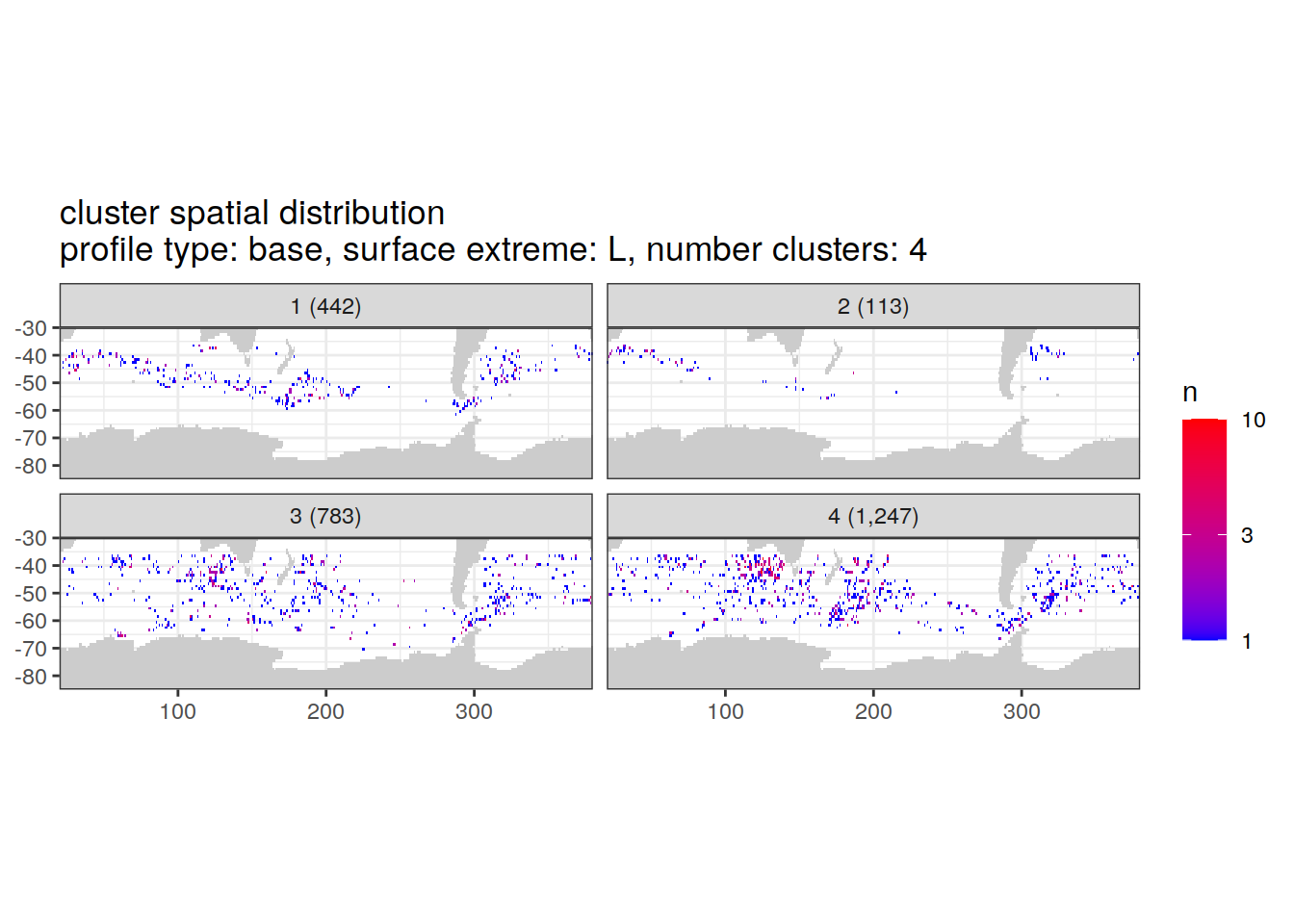
[[2]]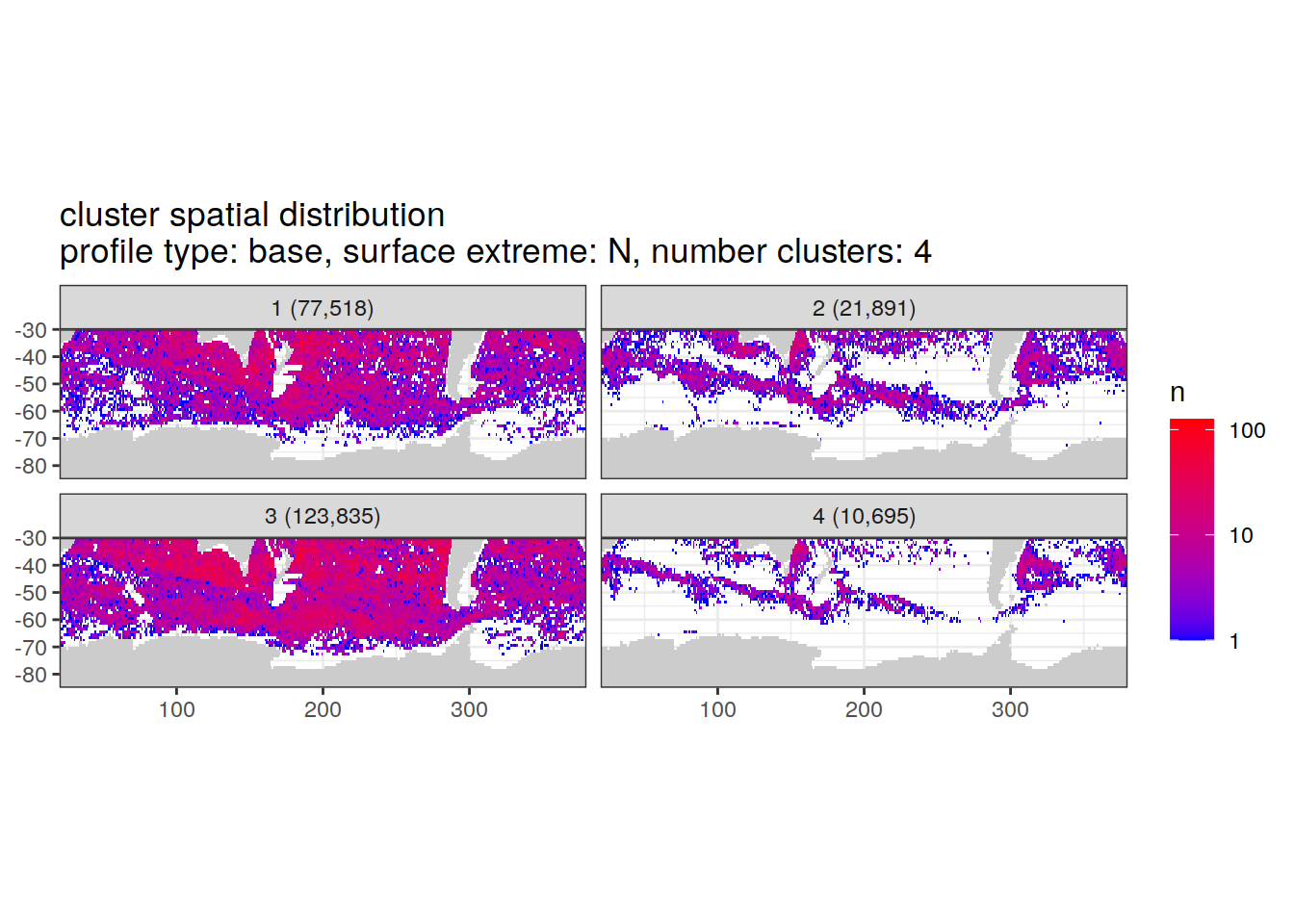
[[3]]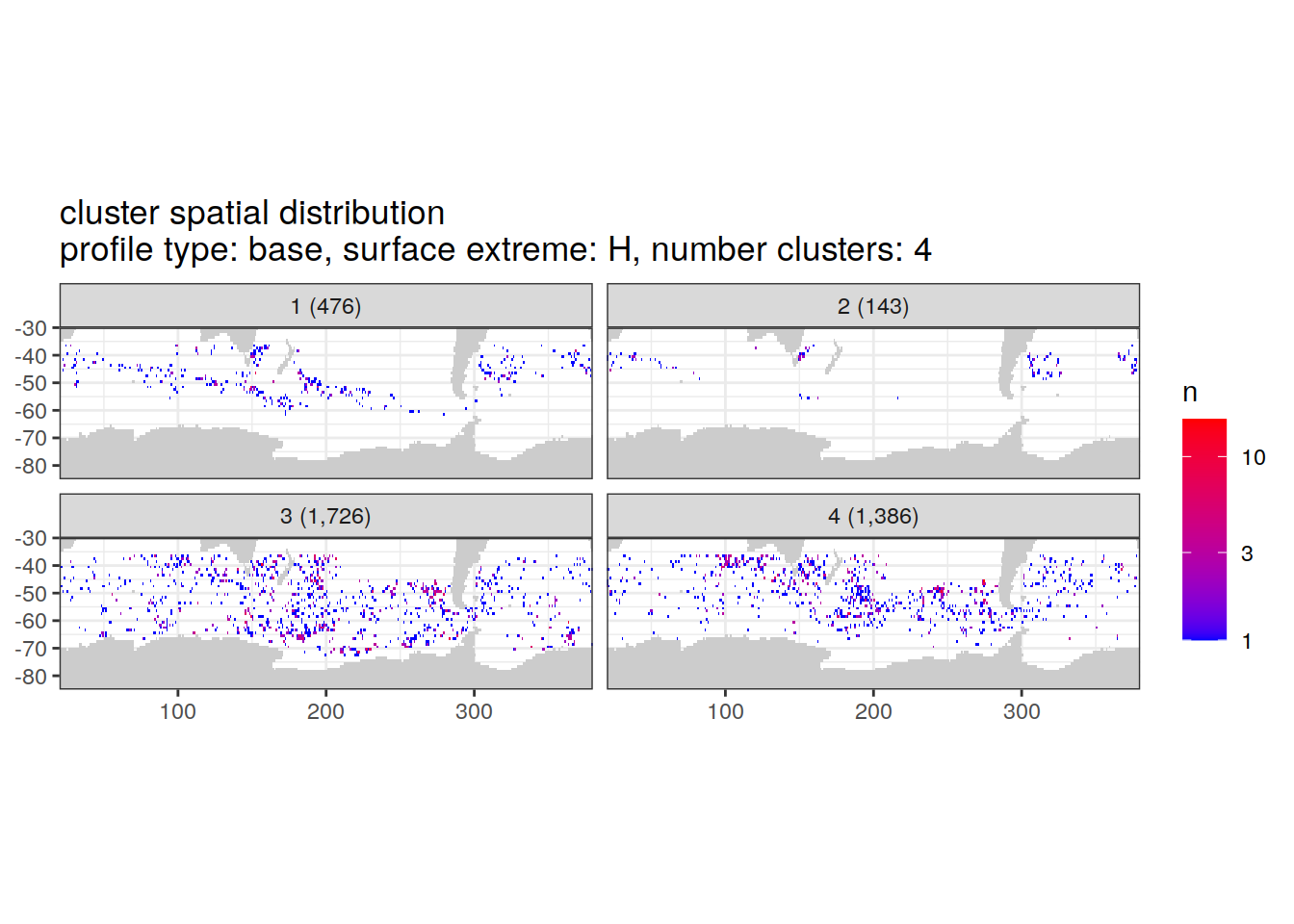
[[4]]
[[5]]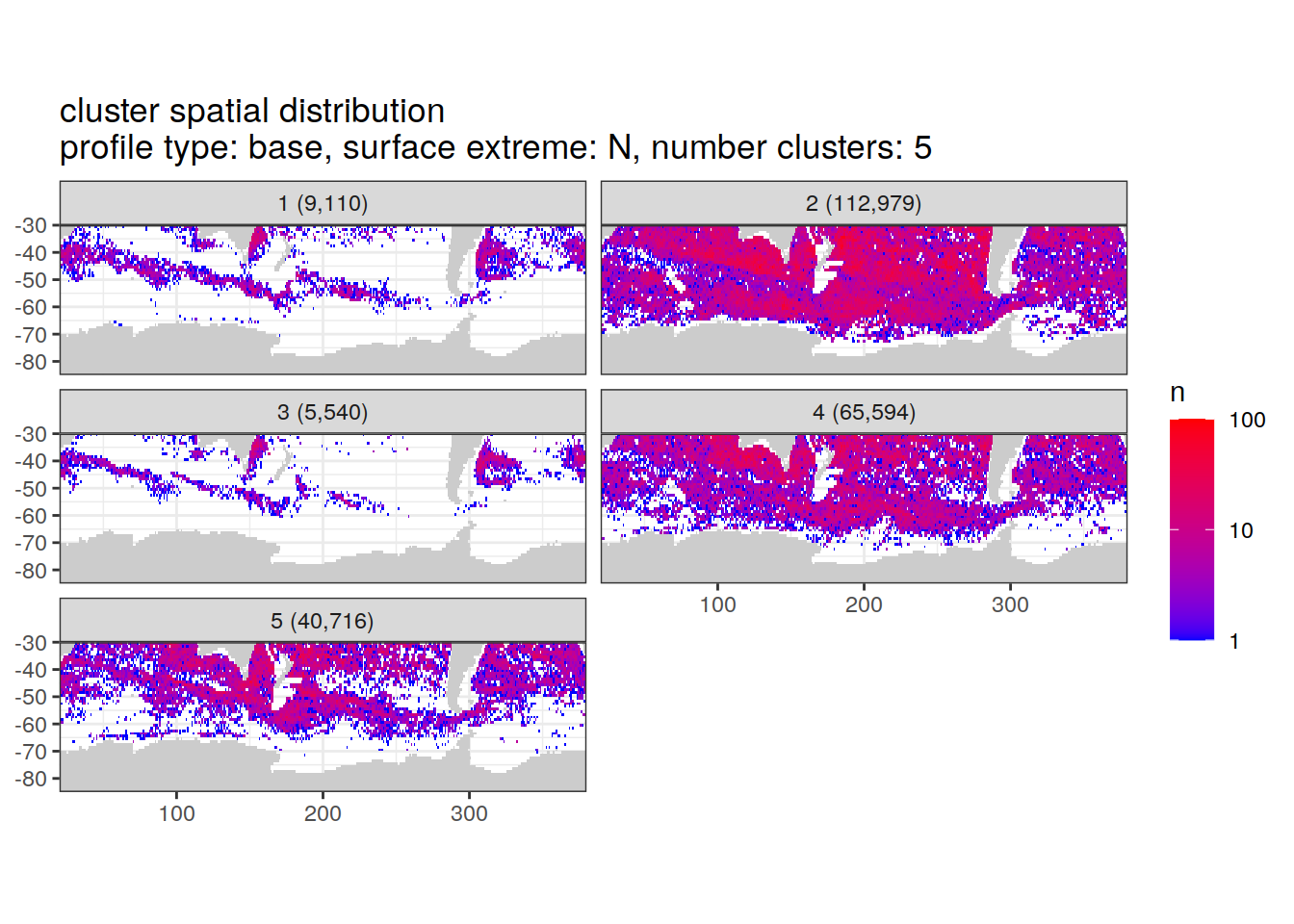
[[6]]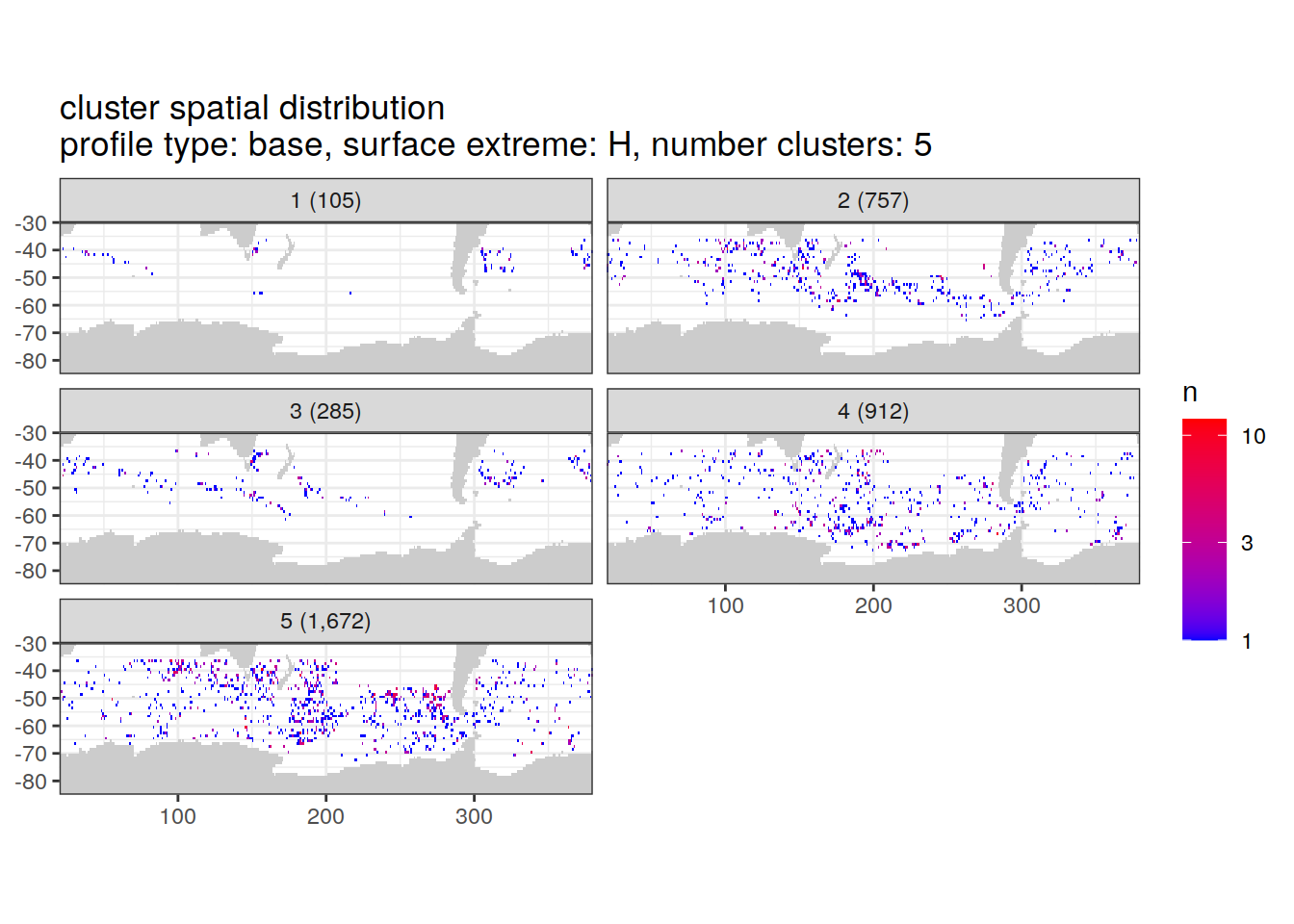
Adjusted profiles
if (opt_extreme_analysis){
if (opt_norm_anomaly) {
cluster_by_location %>%
filter (profile_type == "adjusted") %>%
group_split(profile_type, num_clusters, extreme_order) %>%
map(
~ map +
geom_tile(data = .x %>%
count(lat, lon, cluster, count_profiles),
aes(
x = lon,
y = lat,
fill = n
)) +
lims(y = opt_map_lat_limit) +
scale_fill_gradient(low = "blue",
high = "red",
trans = "log10") +
facet_wrap(~ paste0(cluster, " (", formatC(count_profiles, big.mark=",") , ")"), ncol = 2) +
labs(
title = paste0(
'cluster spatial distribution \n',
'profile type: ', unique(.x$profile_type), ', ',
'surface extreme: ', unique(.x$extreme), ', ',
'number clusters: ', unique(.x$num_clusters)
)
)
)
}
}[[1]]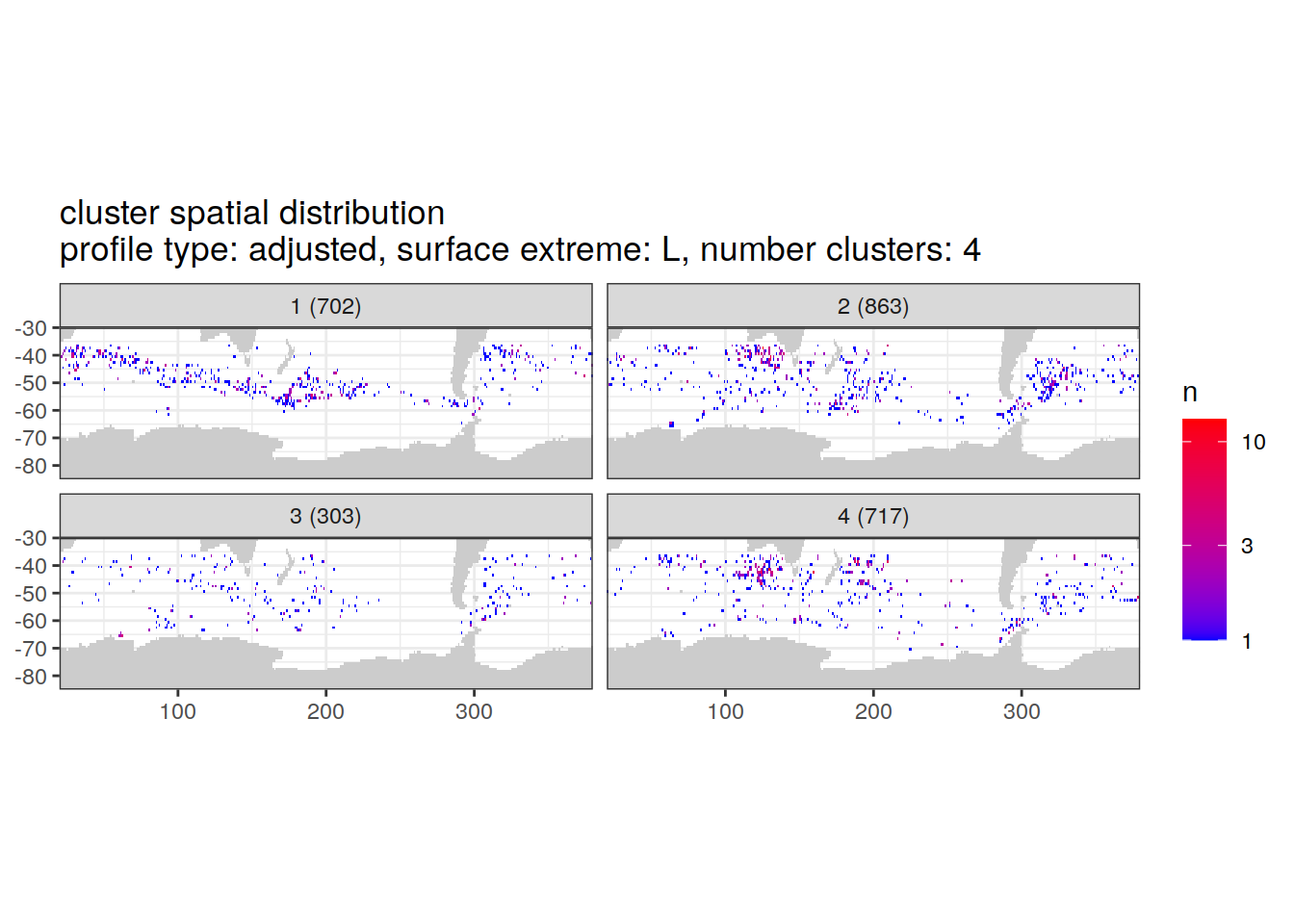
[[2]]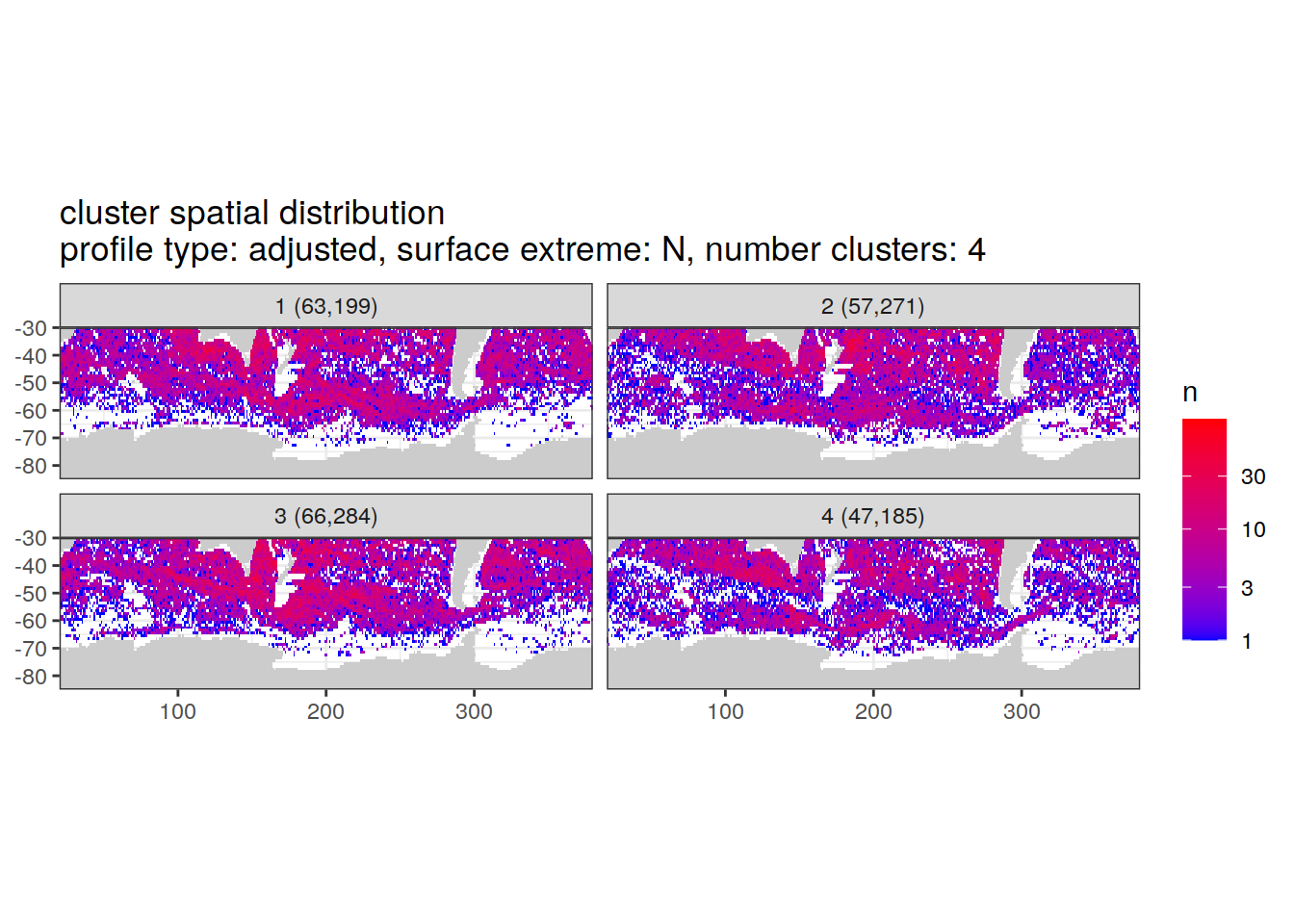
[[3]]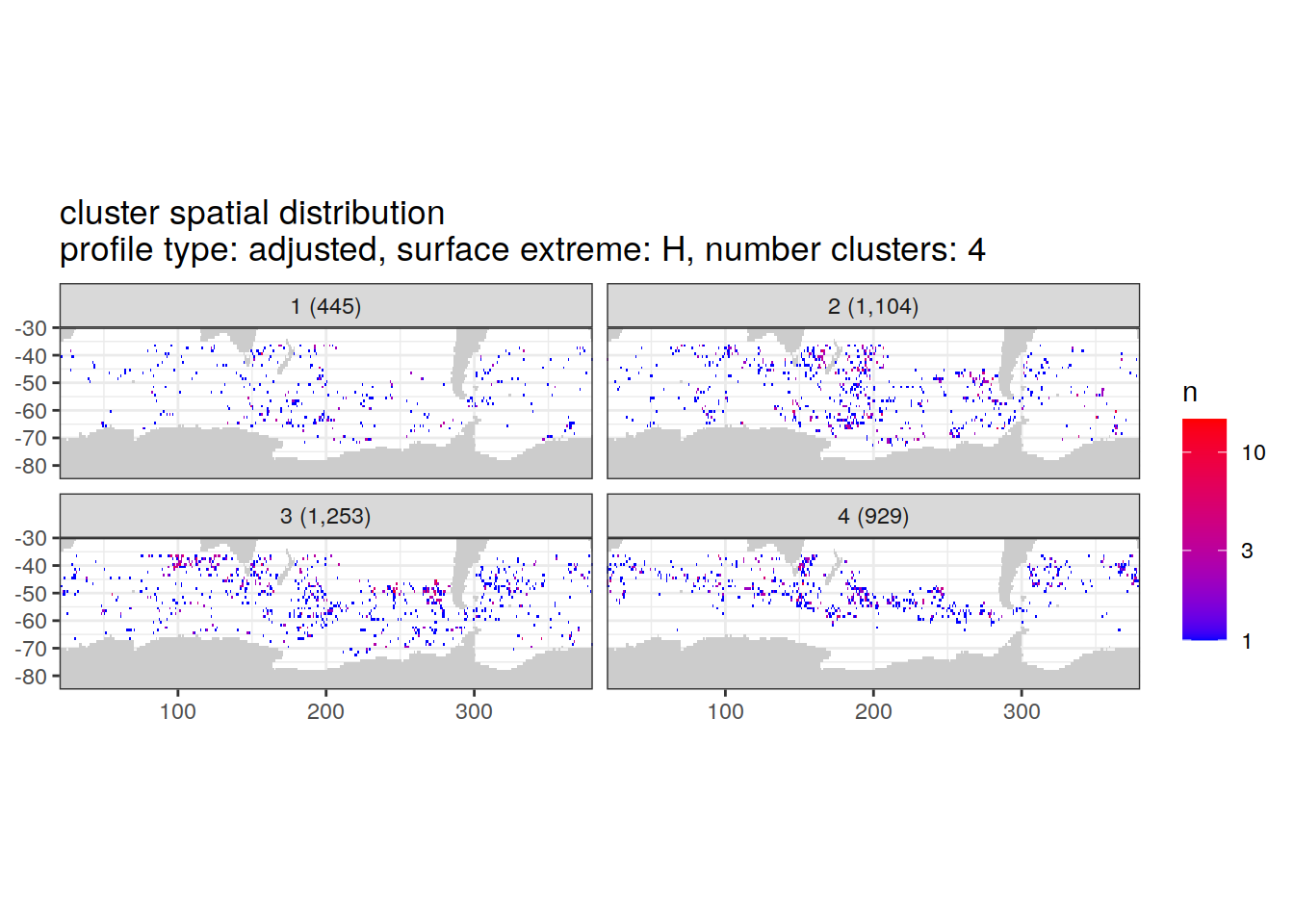
[[4]]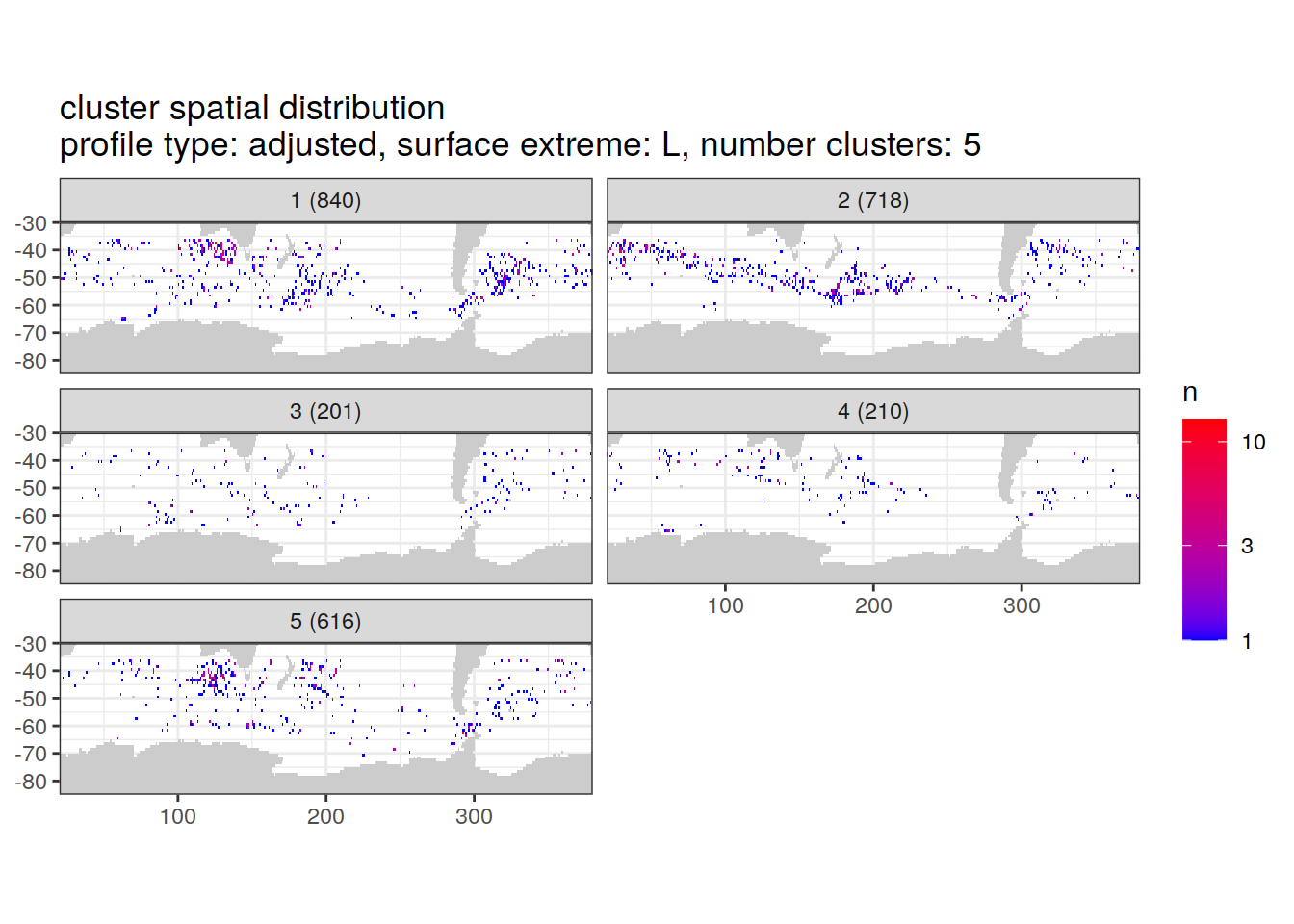
[[5]]
[[6]]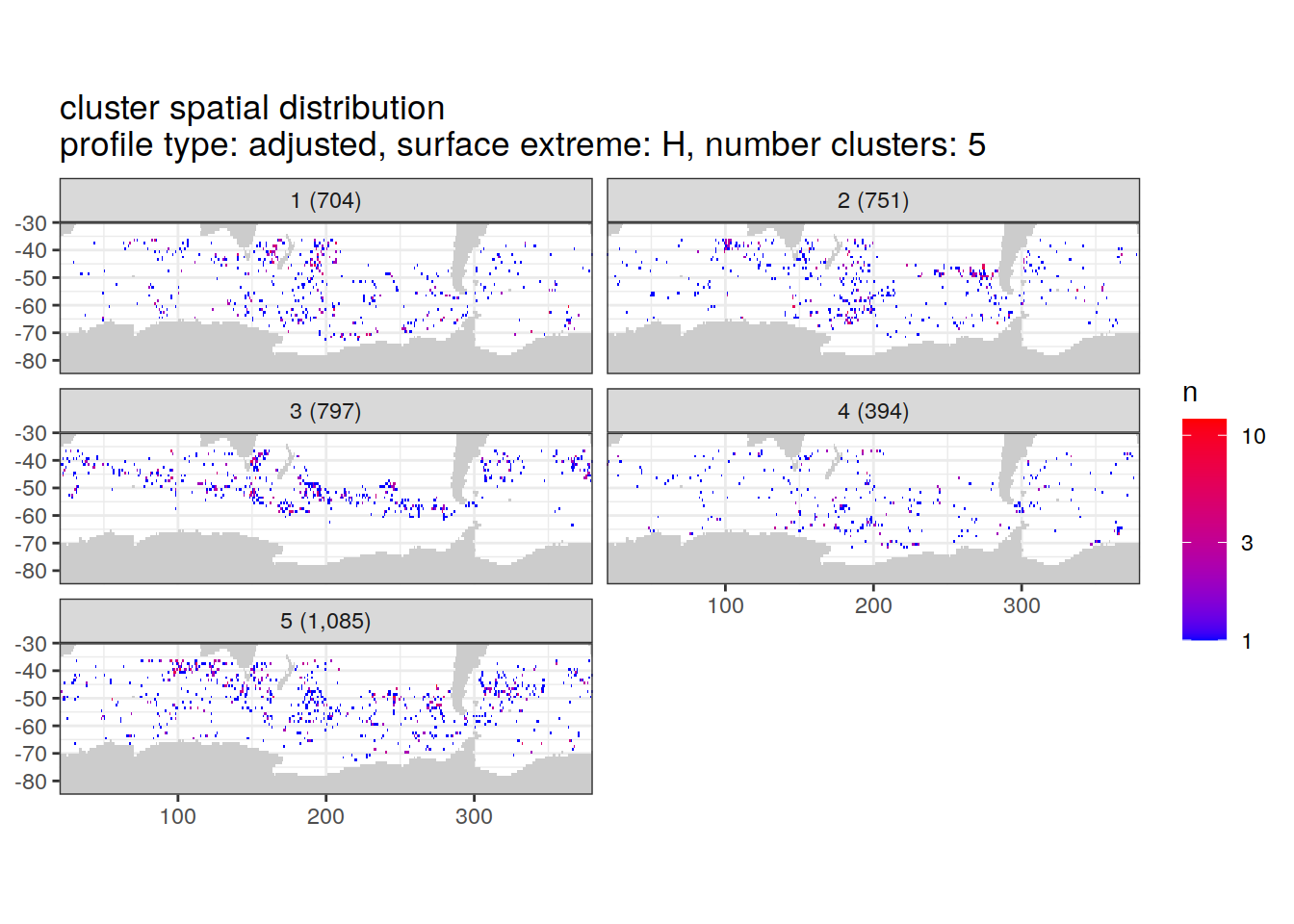
sessionInfo()R version 4.2.2 (2022-10-31)
Platform: x86_64-pc-linux-gnu (64-bit)
Running under: openSUSE Leap 15.5
Matrix products: default
BLAS: /usr/local/R-4.2.2/lib64/R/lib/libRblas.so
LAPACK: /usr/local/R-4.2.2/lib64/R/lib/libRlapack.so
locale:
[1] LC_CTYPE=en_US.UTF-8 LC_NUMERIC=C
[3] LC_TIME=en_US.UTF-8 LC_COLLATE=en_US.UTF-8
[5] LC_MONETARY=en_US.UTF-8 LC_MESSAGES=en_US.UTF-8
[7] LC_PAPER=en_US.UTF-8 LC_NAME=C
[9] LC_ADDRESS=C LC_TELEPHONE=C
[11] LC_MEASUREMENT=en_US.UTF-8 LC_IDENTIFICATION=C
attached base packages:
[1] stats graphics grDevices utils datasets methods base
other attached packages:
[1] yardstick_1.2.0 workflowsets_1.0.1 workflows_1.1.3 tune_1.1.2
[5] rsample_1.2.0 recipes_1.0.8 parsnip_1.1.1 modeldata_1.2.0
[9] infer_1.0.5 dials_1.2.0 scales_1.2.1 broom_1.0.5
[13] tidymodels_1.1.1 ggforce_0.4.1 gsw_1.1-1 gridExtra_2.3
[17] lubridate_1.9.0 timechange_0.1.1 argodata_0.1.0 forcats_0.5.2
[21] stringr_1.5.0 dplyr_1.1.3 purrr_1.0.2 readr_2.1.3
[25] tidyr_1.3.0 tibble_3.2.1 ggplot2_3.4.4 tidyverse_1.3.2
[29] workflowr_1.7.0
loaded via a namespace (and not attached):
[1] googledrive_2.0.0 colorspace_2.0-3 ellipsis_0.3.2
[4] class_7.3-20 rprojroot_2.0.3 fs_1.5.2
[7] rstudioapi_0.15.0 furrr_0.3.1 listenv_0.8.0
[10] farver_2.1.1 prodlim_2019.11.13 fansi_1.0.3
[13] xml2_1.3.3 codetools_0.2-18 splines_4.2.2
[16] cachem_1.0.6 knitr_1.41 polyclip_1.10-4
[19] jsonlite_1.8.3 dbplyr_2.2.1 compiler_4.2.2
[22] httr_1.4.4 backports_1.4.1 assertthat_0.2.1
[25] Matrix_1.5-3 fastmap_1.1.0 gargle_1.2.1
[28] cli_3.6.1 later_1.3.0 tweenr_2.0.2
[31] htmltools_0.5.8.1 tools_4.2.2 gtable_0.3.1
[34] glue_1.6.2 Rcpp_1.0.10 cellranger_1.1.0
[37] jquerylib_0.1.4 RNetCDF_2.6-1 DiceDesign_1.9
[40] vctrs_0.6.4 iterators_1.0.14 timeDate_4021.106
[43] xfun_0.35 gower_1.0.0 globals_0.16.2
[46] ps_1.7.2 rvest_1.0.3 lifecycle_1.0.3
[49] googlesheets4_1.0.1 future_1.29.0 getPass_0.2-2
[52] MASS_7.3-58.1 ipred_0.9-13 hms_1.1.2
[55] promises_1.2.0.1 parallel_4.2.2 RColorBrewer_1.1-3
[58] yaml_2.3.6 sass_0.4.4 rpart_4.1.19
[61] stringi_1.7.8 highr_0.9 foreach_1.5.2
[64] lhs_1.1.6 hardhat_1.3.0 lava_1.7.0
[67] rlang_1.1.1 pkgconfig_2.0.3 evaluate_0.18
[70] lattice_0.20-45 labeling_0.4.2 processx_3.8.0
[73] tidyselect_1.2.0 here_1.0.1 parallelly_1.32.1
[76] magrittr_2.0.3 R6_2.5.1 generics_0.1.3
[79] DBI_1.2.2 pillar_1.9.0 haven_2.5.1
[82] whisker_0.4 withr_2.5.0 survival_3.4-0
[85] nnet_7.3-18 future.apply_1.10.0 modelr_0.1.10
[88] crayon_1.5.2 utf8_1.2.2 tzdb_0.3.0
[91] rmarkdown_2.18 grid_4.2.2 readxl_1.4.1
[94] callr_3.7.3 git2r_0.30.1 reprex_2.0.2
[97] digest_0.6.30 httpuv_1.6.6 GPfit_1.0-8
[100] munsell_0.5.0 viridisLite_0.4.1 bslib_0.4.1